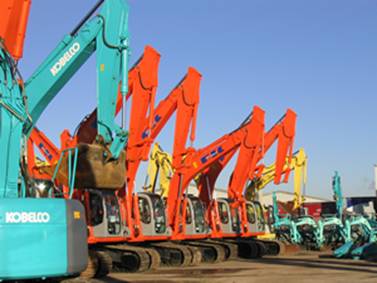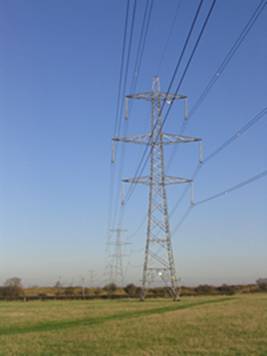Page 01
Topic pack - introduction
Welcome to this Triple A Learning topic pack for business organisation and environment. The pack has a wide range of materials including notes, questions, activities and simulations.
A few words about Navigation
So that you can move to the next page in these notes more easily, each page has navigation tools in a bar at the top and the bottom. These tools are shown below.
![]() The right arrow at the top or bottom of the page will take you to the next page of content.
The right arrow at the top or bottom of the page will take you to the next page of content.
![]() The left arrow at the top or bottom of the page will take you to the previous page.
The left arrow at the top or bottom of the page will take you to the previous page.
![]() The home button will take you back to the table of contents for the pack.
The home button will take you back to the table of contents for the pack.
The pack is split into a series of sections and to access each section, the easiest way is to use the table of contents on the left-hand side of the page. To return to the full table of contents, please click on the 'home button' at any stage.
Higher level extension material
Some of the material in this pack relates to the higher level extension topics in the Business and Management guide. This material is marked by icons as follows:

This icon indicates the start of the higher level extension material.

This icon indicates either:
- The higher level extension material continues on the next page or
- The higher level extension material continues from the previous page

This icon indicates the end of the higher level extension material.
To start viewing the contents of the pack, please click on the right arrow at the top or bottom of the page.
Terms and definitions
One of the key things you need to be sure to know are the definitions of all key business terms. In this section we give you explanations and definitions as well as some flash cards, crosswords and word searches to help you practice them.

If you would prefer to view this interaction in a new web window, then please follow the link below:
Click on the right arrow at the top or bottom of the page to start looking at the definitions.
Aims of the business and management course
The aims of the business and management course at HL and SL are to:
- promote the importance of exploring business issues from different cultural perspectives
- encourage a holistic view of the world of business
- enable the student to develop the capacity to think critically about individual and organizational behaviour
- enhance the student's ability to make informed business decisions
- enable the student to appreciate the nature and significance of change in a local, regional and global context
- promote awareness of social, cultural and ethical factors in the actions of organizations and individuals in those organizations
- appreciate the social and ethical responsibilities associated with businesses operating in international markets.
Assessment Objectives
Having followed the business and management course at HL or SL, students will be expected to:
- demonstrate knowledge and understanding of business terminology, concepts, principles and theories
- make business decisions by identifying the issue(s), selecting and interpreting data, applying appropriate tools and techniques, and recommending suitable solutions
- analyse and evaluate business decisions using a variety of sources
- evaluate business strategies and/or practices showing evidence of critical thinking
- apply skills and knowledge learned in the subject to hypothetical and real business situations
- communicate business ideas and information effectively and accurately using appropriate formats and tools.
In addition to the above, students at HL will be expected to:
- synthesize knowledge in order to develop a framework for business decision-making.
Topic One Structure
Unit one has eight core sub-topics and one HL extension
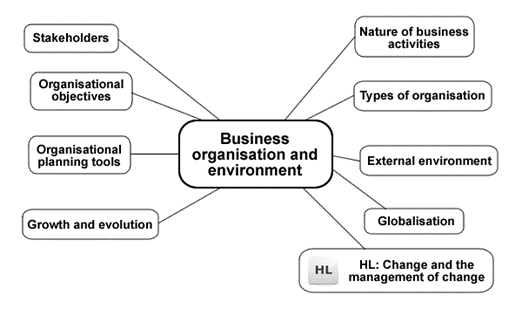
1.1 Nature of business activity - notes
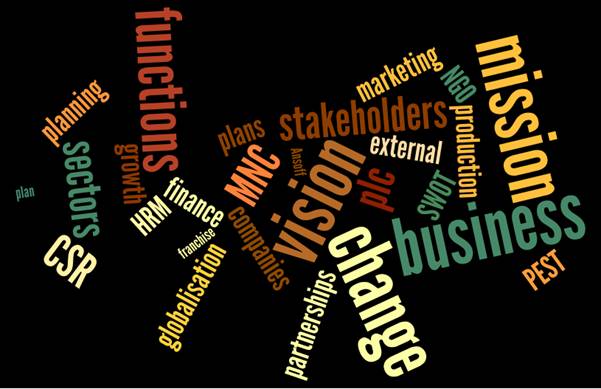
This section looks at the nature of business activity, what a business does and how it does it. It examines the functions/departments of a business and the inputs used to create goods and services.

By the end of this section you should be able to:
- Identify inputs, outputs and processes of a business
- Describe the various business functions and explain their role
- Explain the nature of business activity in different sectors: primary, secondary and tertiary

- Analyse the impact of changes in economic structure on business activity
The nature of business
A business is set up because the founders believe they have found a product or service, which will both satisfy customers and provide a level of returns to meet their needs.
Customers have needs and wants. A need is generally a product or service required for survival, such as food, clothing or shelter. In addition, customers have wants, which are things they would like to have, but are not necessary for immediate survival, such as cars, television and laptops. Of course the nature of needs and wants varies from country to country, and region to region. In hot climates the need to keep cool, will mean most buildings are fitted with air conditioning systems, whereas in cold climates, the need will be for better insulation and heating.
 The resources used to produce goods and services are scarce as they are limited in supply, but the needs and wants of customers are infinite. Therefore, resources must be rationed in some way and this occurs through the business charging a price for their outputs. The success of a business is measured by whether customers are willing to pay this price, and also whether after paying for all the costs of the business the owners can make a profit that justifies the risks of setting up the business in the first place.
The resources used to produce goods and services are scarce as they are limited in supply, but the needs and wants of customers are infinite. Therefore, resources must be rationed in some way and this occurs through the business charging a price for their outputs. The success of a business is measured by whether customers are willing to pay this price, and also whether after paying for all the costs of the business the owners can make a profit that justifies the risks of setting up the business in the first place.
Markets, customer and consumers
A market is a place or a process which brings together buyers and sellers so goods, services and information can be exchanged. Markets vary in size, range, and location. They may be physical in the sense of a shop or restaurant, or may be virtual as in the case of an e-commerce transaction.
The purchasers of the product in the market place are customers. However, those who enjoy the product or serve are consumers. In most cases these are one and the same. If you buy and then eat an ice-cream, you are both the customer and the consumer. However, if a parent buys an ice-cream for their child, the parent is the customer and the child is the consumer. This is a very important distinction in business, because when a firm is planning how to market their product they have to decide whether the customer or the consumer is most influential in the purchasing decision.

Try to avoid misspelling 'Customers'. One of the most common spelling mistakes in examinations, and indeed courseworks, is reference to 'Costumers' - these do exist, but they make costumes!
Business activity
In this, the first section of the IB course, we look at business organisations and the various different types and classifications of organisation that exist. All of these organisations take part in what is called Business Activity. Think about what business activity means to you and what it involves and then follow the link above to see how your thoughts compare with ours.

So let's start to look at this in more detail. We are now aware of what business activity is, but let's examine what we mean by a 'business'. First, what do you think a Business is? Have a think about this and then move on to the next page where we will look at this in more detail.
What is a business?
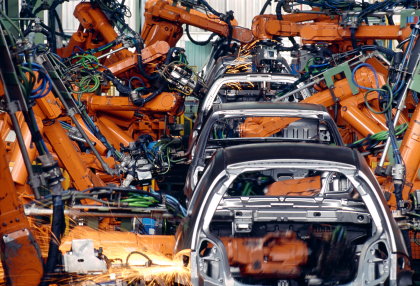 The term 'business' is used to describe all the commercial activities undertaken by the various organisations, which produce and supply goods and services.
The term 'business' is used to describe all the commercial activities undertaken by the various organisations, which produce and supply goods and services.
A business has many features. It is:
- A decision making organisation
- made up of groups of workers (employees), managers, directors and shareholders
- which exists in association with customers, suppliers, competitors, the environment, local, national and other governments
- that uses factors of production
- to produce and sell goods and/or services
- so as to make a profit.
Decision-making
Firms and business studies are all about making and taking decisions. The basic decisions are:
- What to produce - what good or service - and for how long?
- How to produce and in what quantity?
- Who to sell the goods or services to - how to distribute?
Some decisions may have significant consequences. Companies deciding, for instance, to change location or products may invest large sums in their decisions. Poor decisions may result in the closure of the business itself. These types of decisions are called 'strategic' or high level decisions. Businesses need to get these decisions right.
Less important decisions, such as what brand of paper to use, have less important consequences. These day-to-day decisions are referred to as 'tactical' or 'low level' decisions. It is important, however, to remember that too many poor tactical decisions could affect the longer-term strategy. For example in a sports team, the team may be able to cover up for one or possibly two players not playing well. However, if everyone is having a 'bad day' the team will lose!
The business world is dynamic. Little stays the same for long. Management has to detect changes and take decisions on how to react to change on a regular basis. We will learn over the course of this topic and later topics, a whole range of techniques that make decision-making easier. These will be considered as business tools that assist decision making. However, remember, these techniques do not make decisions, people do. A skilled craftsman knows what tool to use and when.
Businesses also have to plan their progress. They aim first to survive, then to grow. This means they normally follow a formal planning cycle designed to address the following questions:
- Where are we now?
- Where would we like to be in the future?
- How are we going to get there?
- How will we know when we arrive?
This framework is a shorthand outline of the strategic decision-making process.
The Classification of a Business
In the same way that individuals have distinct personalities and characteristics, so do businesses. Classifying things help us to understand and define them. The following are ways that we can classify and group businesses, all of which will be examined in detail during this topic:
- By sector - there are two main sectors: private and public. The private sector includes all organisations owned, controlled and managed by private individuals for the purpose of making a profit. The public sector refers to organisations owned, controlled and managed by the government (or state) to provide essential goods and services for the general public. Governments play a role in the production of goods and services that are underprovided by the private sector, such as health and education.
- By level of activity - essentially this describes how close the business is to the customer in the distribution chain. For example, those businesses involved in the extraction of raw materials, such as oil, are very early in the distribution chain, whereas those which own retail outlets are much later in the chain and close to the final customer
- By size - we often classify businesses as small or large, but what do these terms mean? Unfortunately, this classification is complicated by the fact that there are number ways of measuring business size, such as capital employed, market share, sales turnover, profit and the number of employees.
By legal structure -The way that a business is set up affects its legal rights and responsibilities.
Inputs: Factors of production
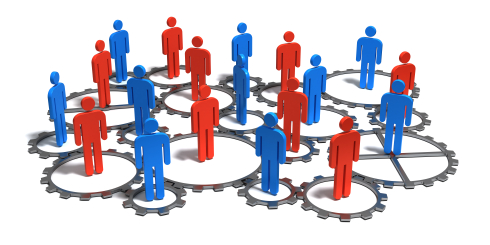 To produce goods or services, a firm must use a range of resources. These resources are called the factors of production or factor inputs. These resources are categorised into four groups:
To produce goods or services, a firm must use a range of resources. These resources are called the factors of production or factor inputs. These resources are categorised into four groups:
- Land - this is the land itself, the factory site, for example. It also covers unprocessed raw materials derived from the earth or water.
- Labour - the services given by all employees of the business. A labour-intensive business is one that has a high proportion of labour inputs, normally because labour is relatively cheap.
- Capital - money, or the assets such as buildings, plant and equipment, which it has bought and uses in the production process. Capital can be thought of as anything used to produce something else. Money is capital only when it is used to buy business assets such as machinery and raw materials. A capital-intensive business depends more heavily on capital than the other factors of production. This is often because labour is relatively expensive.
- Enterprise - that 'spark' or idea which the founder or entrepreneur provides. This will include the planning that brings together the other three factors of production.
The provider of each factor receives a reward for being involved in production:
- Land owners receive rent
- Employees receive wages and salaries
- The providers of capital receive interest
- Entrepreneurs get to keep the profit - if there is any - for their risk-taking in setting up the business process and for their additional responsibilities and decision making in the business process.
Processes: Business functions
A business is usually split into a series of different departments. Each department has a specific function in the operation of the business. For example, the accounting department will be responsible for the management of all financial matters relating to the business. This might include managing the businesses bank accounts, invoicing customers, collecting debts and so on. Each of these different functions is a crucial part of the overall business.
Human resources function (Human Resource Management or HRM for short)
 Firms need people and the human resources department is responsible for the management of people. The responsibilities of the HR department will include:
Firms need people and the human resources department is responsible for the management of people. The responsibilities of the HR department will include:
- Recruitment - the process of finding appropriate people for a given role. This includes advertising a vacancy, selecting candidates for interview, managing contracts of employment, job descriptions and so on.
- Training - both new and existing staff will need training to help them develop and improve their skills and this will be the responsibility of the HR department.
- Pay - people work for money and this process needs managing. How much is each job worth, what other benefits do employees get (pension entitlement, fringe benefits and so on), what happens when people are sick? All these questions and issues are dealt with by the HR department.
- Employee relations and welfare - this includes pay negotiations with employees, disciplinary procedures, considering grievances of employees as well as health and safety, social activities and so on. All these will usually be handled by the HR department.
Human Resources - labour or workforce
Human resources is a collective term for the people within a firm. They are often described and classified by their function:
- Owners - the nature of ownership depends on the legal structure of the firm. The owner may be one person (sole trader) or a group of individuals (partners), or ownership may rest with a group of shareholders.
- Directors - people appointed by the owners to look after their interests. Some directors are also employees. These are the executive directors who are responsible for the day-to-day management of the firm. The senior executive director is the Managing Director or the Chief Executive Officer (CEO). The other directors, the Non-Executive Directors, only sit on the Board and are expected to watch and advise both the board and the owners.
- Managers - people responsible for the planning and control of the business.
- Employees - people who operate the business on a day-to-day basis.
People may be in more than one group. An employee may also be a shareholder, for instance. This can cause a serious conflict of interest.
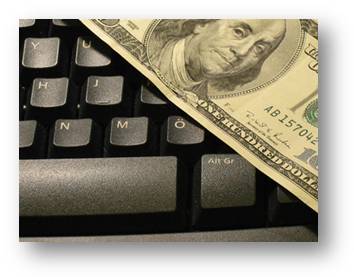 Accounting and finance function
Accounting and finance function
The accounting and finance department are responsible for all issues related to the management of money and the flows of money around the business and between the firm and other firms or customers. The Accounting function involves the collection, recording, presentation and analysis of financial data. This may include 'management accounts' for the directors of the firm to view on a regular basis or the public or 'financial accounts' for anyone to view (if the firm is a public limited company). The Finance function, on the other hand, is concerned with raising the money required for all business operations and the decision-making on how and where that money should be spent.
The responsibilities of the finance function include:
- Sources of finance -decisions about the most appropriate source of finance for each activity.
- Cash flow -the way in which money moves in and out of the business. It is important to balance and manage these flows. If too much money flows out at a given time, the firm is in danger of insolvency.
- Credit control - the process of collecting debts and managing payments. At any given time a firm will be owed money by its customers and may owe money to its suppliers.
Marketing function
 This is seen by many as the heart of the business as the marketing department tends to have the most direct contact with customers. It is important to realise that marketing is not the same as 'selling', but is a much broader concept. The responsibilities of the marketing department may include:
This is seen by many as the heart of the business as the marketing department tends to have the most direct contact with customers. It is important to realise that marketing is not the same as 'selling', but is a much broader concept. The responsibilities of the marketing department may include:
- Researching the market - identifying market opportunities, examining the nature of customers and potential customers, understanding the target market for the good or service, testing consumer reaction to potential products and so on.
- New product development - the marketing department will often work together with the production department to develop new products and services. The marketing department will test if there is a market for the product, identify the features or characteristics that the product requires and may carry out test launches of the product in advance of the full product launch.
- Marketing mix - the marketing department will develop the mix of strategies that will help with selling the product. This includes the pricing of the product, the promotion, the nature of the product and the distribution channels for the product.
Production function (Operations Management or OM for short)
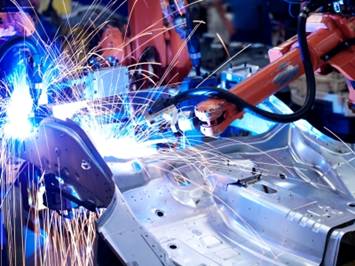 The production function is perhaps the clearest of all. It may also be called the 'operations' function of the firm. However, as with marketing, there is more to the production function than immediately meets the eye. The responsibilities of the production department may include:
The production function is perhaps the clearest of all. It may also be called the 'operations' function of the firm. However, as with marketing, there is more to the production function than immediately meets the eye. The responsibilities of the production department may include:
- New product development - in association with the marketing department
- Research and development (R & D) - R&D refers to systematic investigation or innovation; the outcomes of which are new or improved materials, products, devices, processes, or services. Prototypes of new products may be tested by the marketing department with potential customers.
- Production planning - the production department will consider the layout of the facility, the optimum location of production, the method of production, the type of machinery and so on.
- Quality control - the quality of the product or service is crucial if the reputation of the firm is to be maintained and enhanced.
- Distribution - the production department will organise the distribution of the good or service to the customers. This may be through middlemen or 'intermediaries' such as retail shops or agents or direct to the customer through e-commerce.
- Purchasing and stock control - the production department is responsible for the purchase of stocks or raw materials required for production.
Outputs: Goods and services
The output of a business is goods and services. These are destined either for other firms or for the domestic consumer. Goods are solid items that can be seen and touched (tangible or visible items) such as shoes, food, cars, golf clubs, Manchester United or Barcelona football strips and beef burgers.
Services (invisible or intangible items) are things that cannot be seen or touched, but have visible results, such as services provided by hairdressers, doctors, dentists, solicitors, and banks. Customers pay for skill and experience that they do not possess, or would prefer to purchase to save time. Services can be split into personal or commercial (business) services, although there are often overlaps between the two. For instance, banks offer financial services to both individual and business customers.
The table below categorises types of goods or products:
| Consumer products | Producer products |
|---|---|
|
FMCG's (Fast Moving Consumer Goods) Items bought on a regular basis. Examples are food in a supermarket, papers and magazines etc. Each item has little value. |
ConsumablesItems with a short life and little value. Examples would be raw materials, packaging, paper, lubricants etc. |
|
Consumer durables A good which lasts through many uses and has a long-term value. They are bought infrequently. Special items are:
Other examples are furniture, cars etc. |
Capital goods Plant and Equipment used to produce consumer goods. Examples are pumps and motors, filling machines and computers. Not intended for sale as they are the 'life blood' of the business. |
Sectors of the economy
Sectors of the economy
If you would prefer to view this interaction in a new web window, then please follow the link below:
It is important to remember that the most significant economic activity in many countries exists between businesses, rather than between businesses and consumers. This type of activity where one business sells to another is often called 'B2B' activity (Business to Business).
In this section we are looking at profit organisations - that is organisations whose main objective is usually profit maximisation. We are going to look at this in the context of starting a small firm. We will be looking at the problems of setting up a business either in manufacturing or in the tertiary sector, and examining any legal requirements.

Changes in Economic Structure
Structural change refers to adjustments in the relative importance of different sectors of an economy over time, usually measured in terms of their share of output, employment or total spending.
Since the industrial revolution, structural change in most countries involved shifts from subsistence agriculture to commercial agriculture, an increase in the relative significance of manufacturing and, at a later stage, a shift toward service industries. Structural change also involves shifts between the regions of large national economies, and changes in the composition of a country's imports and exports.
There are many models of economic development and arguments about the stages through which countries travel as they develop. None of these are really relevant to business and management except in the sense that changes in the relative significance of economic sectors will have effects on demand and employment conditions in an economy.
The IMF classifies countries into three main categories:
- developing countries (LEDCs)
- transitional or newly industrialising countries (NICs)
- industrial countries (MEDCs)
Generally speaking, developing countries are characterised by subsistence primary production (mainly agriculture) and low levels of income per head. As these countries develop they go through a process of Industrialisation, which refers to the move from an economy dominated by agricultural output and employment to one dominated by manufacturing. This will have the effects such as:
- Urbanisation
- More capital-intensive industries
- Increases in GDP and living standards as per capita incomes increase
- Increasing employment opportunities
As development proceeds there is a move towards tertiary or service based sector activity as the main contributor to output and employment. This will have effects such as:
- Higher household incomes and changes in consumption patterns towards luxury goods
- Increasing specialisation
- An increase in demand for personal services such as financial planning, hairdressing and personal health
- More leisure time and greater spending on industries such as entertainment, sport and travel
- The growth of technology and communication related industries
Development does not always fit neatly into this primary to secondary to tertiary model. Some developed economies, such as New Zealand have been able to use automation to make their primary industries more efficient and several more economically developed countries, like Japan and Germany, retain a significant manufacturing base by value.
All three sectors of an economy are interdependent in the sense that each sector relies on the others. For example, the largest global manufacturers also require finance, raw materials, energy supplies and transport.
As Business and Management students you need to have an awareness of the effect on relationships within and between countries as they develop. The obvious examples are China and India. As they develop rapidly, the movement of goods and services between countries increase as do the opportunities for employment in related industries. Demand patterns will also change in relation to the accessibility of imported goods and services.

1.1 Nature of business activity - questions
In this section are a series of questions on the topic - Economic structure. The questions may include various types of questions. For example:
- Self-test questions - on-screen questions that give immediate marking and feedback
- Short-answer questions - a series of short-answer questions to help you check your understanding of the topic
- Case study - a case study with associated questions
- In the news - questions based around a topical business news article
Click on the right arrow at the top or bottom of the page to work through the questions.
Economic structure

Economic Structure
| Country/Area | Agriculture (%) | Industry (%) | Services (%) |
|---|---|---|---|
| World (average) | 37.5 | 22.1 | 40.4 |
| European Union (average) | 5.6 | 27.7 | 66.7 |
| Azerbaijan | 38.3 | 12.1 | 49.6 |
| Cambodia | 67.9 | 12.7 | 19.5 |
| Cameroon | 70 | 13 | 17 |
| China | 39.5 | 27.2 | 33.2 |
| Estonia | 2.8 | 22.7 | 74.5 |
| Iceland | 4.8 | 22.2 | 73 |
| India | 52 | 14 | 34 |
| Israel | 2 | 16 | 82 |
| Japan | 4 | 28 | 68 |
| Nepal | 76 | 6 | 18 |
| Singapore | 0 | 23.8 | 76.2 |
| Taiwan | 5.1 | 36.8 | 58 |
Source: CIA Factbook
Singapore and Hong Kong were reported to be the most competitive countries according to the 2010 World Competitiveness Index. A detailed explanation for these rankings is to be found in the press release that accompanied the publication of the Index
Assignment questions
- Examine the breakdown of economic activities in the countries listed above and group the listed countries into developing, transitional (NICs) and developed countries
- Analyse the factors that contribute to a country's competitiveness
- Discuss the consequences for a country as it moves from being manufacturing-focused to service-focused.
Self-test questions - economic structure

1 |
Sectors of the economyCan you match the following business to the sector of the economy that they operate in? If you need some hints, there are links to their web sites underneath the questions. |
2 |
Sectors of the economyCan you match the following business to the sector of the economy that they operate in? If you need some hints, there are links to their web sites underneath the questions. |
The websites of the firms in the questions above are:
3 |
Sectors of the economy
In what sector of the economy is the product shown in the photo below produced?
|
4 |
Sectors of the economy
In which sector of the economy is the product shown in the photo below produced?
|
Factors of production - self-test

1 |
Factors of production
How would you classify the factor of production shown in the image below?
|
2 |
Factors of production
How would you classify the factor of production shown in the image below?
|
3 |
Factors of production
How would you classify the factor of production shown in the image below?
|
4 |
Factors of production
What factors of production are evident in the photo below?
|
5 |
Factors of production
What factors of production are evident in the photo below?
|
6 |
Factors of production
How would you classify the factor of production shown in the image below?
|
1.2 Types of organisation - notes
In the previous section we looked at the nature of business activity and what a business is. We now move on to look at the nature of organisations in the private and public sectors and how we start a new business and the various different types of business organisation. We then examine the nature of non-profit organisations and public private enterprise.

By the end of this section you should be able to:
- Distinguish between organisations in the private and public sector
- Explain the reasons for setting up and organisation and the processes required
- Analyse the problems new set-ups face
- Distinguish between different types of organisation and identify their key features
- Analyse how ownership and control differs between different organisations and evaluate the most appropriate form
- Analyse the separation of ownership and control
- Compare and contrast the objectives of non-profit and profit making organisations and analyse their impact

- Analyse the relationship between organisations in the public and private sector
- Explain the nature of public-private enterprise and analyse the costs of co-operation
Private and public sector
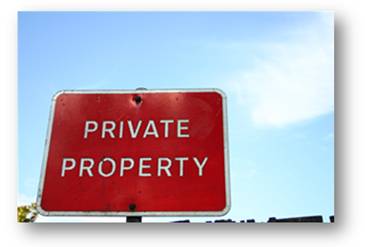 Most of the businesses or organisations that we have looked at so far have been in the private sector of the economy. These are any organisations owned, controlled and managed by private individuals, usually for the purpose of making profit.
Most of the businesses or organisations that we have looked at so far have been in the private sector of the economy. These are any organisations owned, controlled and managed by private individuals, usually for the purpose of making profit.
The public sector is the government sector of the economy - don't muddle this with the general public - they are the private sector! This is referred to as public ownership. It was considered that the government would act in the interests of the population by providing vital services, even if there was no profit in this provision. Merit goods are goods, such as medical care and education, which might not be provided to all of the population by the private sector as there may be no profit here. Government may allow access to all people even if they cannot afford to pay. This is because the government believes the provision of these goods is in the interests of society.
Public ownership is much less common these days as it is believed that businesses are much more efficient if they are privately owned. In the past few decades (since the start of the 1980s) many businesses around the world have been privatised. This means that they have been changed from public ownership to private ownership. However, the balance between public and private ownership varies considerably from country to country. In recent years, several governments have begun to create partnerships with the private sector, which may run some aspects of public sector services such as hospitals and schools, even though these services have not been privatised. These are called public/private partnerships or enterprises, and are to be found in areas such as education and transport. Here the state organises the delivery of the service, while private companies provide some, or all, of the infrastructure.
SUMMARY of types of organisations in the private and public sectors
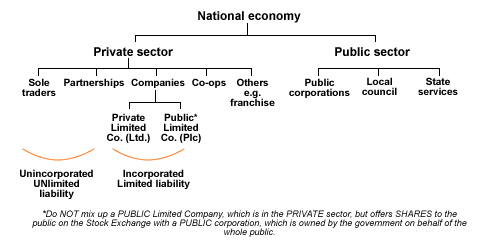
Summary of types of organisations
Why not search around government web sites in your country to find data on the proportion of private and public companies?

Privatisation
Privatisation is the selling of nationalised or state-owned industries to private investors, moving the organisation from the public to the private sector.
It is claimed that privatisation:
- Reduces costs - the profit motive, and competitive pressures will drive costs down. Often a state regulator ensures that private firms do not exploit their monopoly position in the market.
- Increases choice
- Increases quality
- Encourages innovation and invention
- Brings market forces into play in a positive manner for the consumer
- Saves the government money - the costs of the nationalised industries would be replaced by income from business taxes
- Widens share ownership in the population
Privatisation also has some possible problems:
- Monopolies will be in private hands e.g. transport
- Loss of equity - the general public loses a valuable resource
- Externalities - the private firm may not be so careful about creating pollution and other external costs, as they are only responsible for paying private costs (in other words the rewards for the four factors of production).
Privatisation in many countries has been accompanied by the introduction of deregulation, but also the appointment of regulators to reduce the opportunity for exploitation. These regulators are expected to act as 'watchdogs' to protect consumers and other stakeholders.

Deregulation
Deregulation is the removal of government rules, controls and restrictions on production and trade.
Some industries have in the past been government monopolies to protect them from competition. Deregulation is the removal of these government controls from an industry. Regulators control or regulate privatised monopoly industries.
Starting a business
There are six main stages to starting a new business:
- Identifying a business opportunity and a target market and generating ideas about meeting the needs and wants of that market
- Producing a business plan
- Selecting the correct form of business organisation
- Surviving the first few months of operations
- Raising the initial finance from personal savings, family or friends, redundancy payments or borrowing.
- Choosing a suitable location
Starting a new business is extremely risky and businesses are particularly vulnerable in the first 18 months to two years of operation. Indeed, about half of all new businesses fail within this period.
Why is the failure rate of new businesses so high?
Inadequate initial capital
- Start-up costs are very high, e.g. the purchase of equipment and raw materials and the expense of buying or renting business premises. Recruitment and training costs can be significant as well as legal fees and marketing costs.
- Initial demand and sales revenue may be low as the new business has no brand recognition or customer loyalty. Indeed it may take several months before the business can produce any goods and services.
- Cash flow problems resulting from the combination of the two points above, which may kill it before it has the chance to trade successfully.
- Market research has been poor and there is inadequate demand for the goods and services produced by the business.
- Changes in the external environment e.g. the economy may move into recession or new competitors enter the market.
- Other businesses 'steal' or copy their idea
- Falling foul of unknown and/or un-researched legal restrictions, such as business registration, licences and insurances.
- Poor marketing and failure to supply sufficient goods and services to satisfy orders or meet future demand
- Uncompetitive prices - small businesses do not have many economies of scale, which means that costs, and therefore, prices are higher than competitors.
- Poor location as the result of a lack of finance. The best retail and office locations tend to be very expensive.
- The personality of the entrepreneurs - do the founders have the commitment and drive to make the business successful if this entails long hours and disruption to family and social life?
If setting up and establishing a new business is so risky, what are the incentives for individuals to start a business?
- they want to be an entrepreneur (a risk-taker and decision-maker)
- they want to be their own boss, work for their own interests and have some autonomy
- they want to plan, organise and enjoy the satisfaction of building something that is their creation
- they enjoy a challenge
- they think they have a good idea for a good or service and believe they can produce these better than their competitors
- they have special skills that others do not have or are in short supply
- they want to earn a profit and 'get rich'!
What factors make a business likely to succeed and survive?
Inevitably, there are elements of good luck and good timing involved in business survival. However there are some common elements which underpin this success:
- Having a business idea which will sell in a competitive market place. Ideally, this idea should be different to products and series already on sale, creating a USP or Unique Selling Proposition (or point) for which customers are prepared to pay a price providing a profit. This, of course, is extremely difficult, given that most markets already have huge choice. Can the founders truly discover something different or innovative that will persuade buyers to give up their tried and tested products? Alternatively, some businesses have been successful producing a so called 'me too' product to start with and go for a marketing edge. 'Me too' products are basically adapted copies of existing products or services. However, it is essential that these products do not infringe the patents, trademarks and copyrights of other firms.
- Targeting a market segment large enough to support the business and provide a profit, and providing the opportunity for future growth.
- Conducting adequate market research regarding the USP and the target market
- Possessing appropriate business skills and a desire to succeed.
- Adequately protecting their goods and services and intellectual property rights (IPR) such as brand names and logos by establishing:
- patents to protect products from copying by other firms
- registered trademarks to protect logos, slogans and help build brand image and reputation
- copyrights to protect ideas and artistic work, such as software, music, newspapers, books and films.

 Producing a successful product or service: a case study - James Dyson
Producing a successful product or service: a case study - James Dyson
In 1974, James Dyson, an unknown industrial designer decided to become an entrepreneur starting a business with his sister and her husband to make the Ballbarrow. This was the first significant update of the wheelbarrow since the medieval era. Dyson's innovation used a plastic ball instead of a wheel for easier manoeuvrability. Like nearly all of Dyson's inventions, the idea for the Ballbarrow was driven by personal frustration, because his wheelbarrow kept getting stuck in the mud when he was working in the garden.
In the late 1970s, Dyson had the idea for an innovative vacuum cleaner that would not lose suction as it picked up dirt. Five years and 5,127 prototypes later, the 'G Force Dual Cyclone' arrived and revolutionised the vacuum cleaner market. James Dyson offered his invention to major manufacturers. However, no manufacturer or distributor would launch his product as it would disturb the valuable cleaner-bag market worth $500 million every year, so Dyson launched it in Japan in 1986 selling direct to customers through catalogues. The G Force quickly emerged as a cult favourite, despite its rather high price tag. Dyson was forced to sue other companies for patent infringements, and the cases dragged on for years and nearly bankrupted him.
 After failing to sell his invention to any major manufacturer, Dyson was forced set up his own manufacturing company and in June 1993 opened his first research centre and factory in the UK.
After failing to sell his invention to any major manufacturer, Dyson was forced set up his own manufacturing company and in June 1993 opened his first research centre and factory in the UK.
Dyson products quickly began to dominate markets around the world, becoming the largest selling upright vacuum cleaner in Western Europe, The USA and Australia. Naturally, following the success of the 'bag less' technology other major manufacturers began to market their own versions, some copying aspects of Dyson's cyclonic vacuum cleaners. Dyson sued Hoover UK for patent infringement and won around $5 million in damages.
The company continues to expand, experimenting with new ideas and technologies (see the Dyson web site for details of their products). In 2006 Dyson launched a fast and hygienic hand dryer, using a 400 kmh. stream of air.


A further development of Dyson's new air technologies is the innovative series of Air Multiplier fans using new design to draw in air and amplify it up to 18 times, producing an uninterrupted stream of smooth air with no blades or grill. Dyson continues to be one of the innovative manufacturers in the world.
- Define the terms:
- USP
- Entrepreneur
- Explain why Dyson wanted to set up his business.
- Analyse the problems that start-up businesses, such as Dyson face.
- Discuss the importance of protecting intellectual property rights for high technology companies like Dyson.
Also see: World News/James Dyson
A good or a service?
A service firm is usually easier and cheaper to set up than a production firm, because there are fewer requirements to invest in materials, machinery, land and buildings as well as patents. There are fewer implications for cash flow as the business will not need to keep stock.
There are still opportunities for excellent services, including those sold and/or distributed online. For example, most new software is downloadable, rather than being purchased using a CD. Online businesses are relatively cheap to set up and have fewer barriers to entry. However, during the 1990s, thousands of internet based companies were launched, commonly called 'dot-coms'. Most of these spectacularly crashed in the early part of the millennium, wiping out approximately $5trillion in market value from 2000 to 2002. The problem was that many of the business ideas were poorly researched and the products and services of a poor quality. Many of the online businesses failed to set up efficient physical distribution services and deliveries were delayed. The moral to the story is that business success rests on the quality and demand for product and service, not just the technology surrounding it.
Sites that bring buyers and sellers together offer a potentially lucrative business opportunity. There are many 'big-boys' in the market place such as eBay and online shopping and price comparison such as Kelkoo. However, there are still specialist markets, which may not be saturated and where competition may be lower. Perhaps the founder enjoys playing war games such as Warhammer or Dungeons and Dragons? Could a hobby be turned into a business opportunity? Basing a business on a personal interest will certainly be motivating.

You may like to have a look at the following sites in relation to these issues:
- Ebay (http://www.ebay.com)
- Kelkoo (http://www.kelkoo.com/)
- Warhammer - Megaminis (http://megaminis.co.uk/epages/eshop196361.sf)
Market research
It is possible to identify a market opportunity through reliable and valid market research.
Market research is classified into two groups:
- Field research - also known as primary research. Designed and executed specifically to identify a particular product or problem. This is 'first hand data' as it has never been collected before.
- Desk research - also known as secondary research. Based on old, existing data and information. It is, therefore, 'second hand data'. This may be available within the firm, or published externally. Much of the data will be in the public domain.
The former is cheaper, but potentially inaccurate. The latter is expensive, but good if it is done well. This is an example of yet another potential business trade-off.
These concepts are covered in more depth in the marketing topic.
Starting the ball rolling - beginning the planning process
Once a decision has been made to set up a new business, the founders should ask:
- Where the business is going?
- How it will get there?
- How the owners will measure and monitor progress, especially in terms of sales and cash flow?
These are basically the three questions that underpin all strategic decision-making. We will examine these questions in some detail in the strategic topic.
The business often attempts to answer all these questions in its business plan (see topic 1.6). A business plan for a small new firm may fulfil the same role as the mission statement does for a large corporation. It sets out the overall intentions of the business in terms of objectives and strategic direction and therefore underpins the firm's decision making, by setting targets and providing benchmarks for actual performance including forecasts for profit, revenues and cash-flow.
A major function of the plan is to support any application for funds, such as a bank loan. If a bank loan is required, the first thing that the bank manager is likely to want to see is the formal business plan. This tells the bank how serious the founders are, and how well they have researched the business, the market and the products and services it will sell.
Profit-based organisations - legal structure
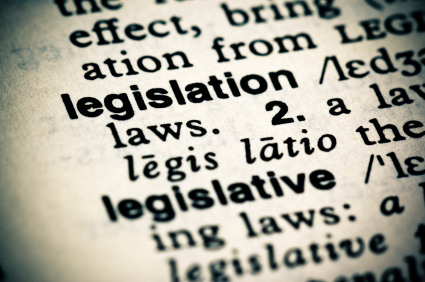 Most organisations that operate in the private sector do so to make profits for the owners. The effectiveness of a business will be influenced by the choice of legal structure, which will determine how a business is financed, managed and organised, and its prospects for growth.
Most organisations that operate in the private sector do so to make profits for the owners. The effectiveness of a business will be influenced by the choice of legal structure, which will determine how a business is financed, managed and organised, and its prospects for growth.
Legal structure
When a firm sets up, the basic choice is whether to be an unincorporated or an incorporated business. The main difference is that in an unincorporated firm, the 'owner is the business', and is legally responsible for everything. For incorporated firms, the firm is a legal entity in itself. It has rights and responsibilities, distinct from those of the owners.
Incorporation is like a birth - a legal entity is created with rights, responsibilities and 'legal personality' - just like a newborn baby. The company has a legal personality. If, for instance, a person steals from a company, it is the company itself that prosecutes the offender, not an individual manager.
An important difference between incorporated and unincorporated businesses is that of limited liability. An unincorporated business has unlimited liability. The owner is responsible for all debts of the business and if necessary his/her personal possessions (assets), such as a house, can be seized to pay business debts. An incorporated business is owned by shareholders. Every shareholder (owner) has limited liability. In the event of the business failing, the shareholders can only lose up to the value of their investment. Their liability for debts is therefore limited to the maximum value of the shares they hold. So if a shareholder has $400 of shares in a company, which goes out of business owing large sums of money, the shareholder can only lose a maximum of $400.
Businesses which possess limited liability must say so after their name, e.g. 'ABC Limited.
This acts as a warning to any individual or organisation that does business with the limited company that, on a liquidation, debts may not be paid. A shareholder's personal possessions cannot be sold to pay for these outstanding debts.
There are four main types of business organisation, and these all have their advantages and disadvantages for the business itself, and also for external organisations and individuals with which the firm deals. We look here at common features of these business organisations. However, they may differ from country to country. One useful exercise is to search online to find out more detail about business structures in your country. The common international legal structures are:
Unincorporated organisations
The business and the owner/owners are seen legally as being one and the same. If you sue a sole trader for debt, for example, you sue the individual owner of the business. The owner is entitled to all the profit, but is also personally liable for all the debts. The owner has unlimited liability and all of his assets may be sold to pay any outstanding debts after the business assets have been sold e.g. the owner's house and car could be seized by legal representatives of the creditors. Sole traders and partners have unlimited liability.
Owners pay personal income tax, at whatever rate the government sets. As the owner's income increases the marginal rate of tax, also increases. There may come a time when the percentage rate of income tax, is higher than the corresponding rate of tax paid by a similar company. This may be an incentive to incorporate.
There are two types of unincorporated businesses:
 Sole trader (sole proprietor)
Sole trader (sole proprietor)
Most new small businesses are set up as sole traders.
- This is the simplest legal structure. It is easy and cheap to set up. There are few formalities, although the sole trader may need to apply for licences or to register the name of the business. The income of the business is the sole trader's income and liable for personal tax. Raising finance for future growth of the business is usually more difficult for a sole trader than a company, and potentially more expensive as interest is likely to be higher because of the increased risk. Sole traders will usually need some security to support borrowing, often their house, and the loan potential is limited. They stand to lose everything if the business fails and may become bankrupt. This situation is called unlimited liability. Some businesses, however, stay sole traders for a long time, even when they are large and even international. JCB, the digger firm, operated as a sole proprietorship for many, many years.
- Sole traders deal directly with the national tax authority, and all profits are treated as income, and taxed accordingly. There are no shares or shareholders. It can be hard to raise money through the banks because of the unlimited liability and lack of security. Many sole traders are small businesses that sell services such as taxi drivers, plumbers, decorators and electricians. As the business is the owner, a sole tradership ceases to exist when the owner retires or dies; it lacks legal continuity.

Although a sole proprietorship is owned by a single owner, it may have many employees. Never say in an exam that a sole trader is where the business is owned and run by one person.
Sole traders have no shares or shareholders. Do not call them companies!
Summary
Advantages of a sole trader:
- Cheap and easy to set up with few legal formalities
- The owner receives all the profits
- Decision-making is quick as only one person makes the decisions
- Being 'your own boss' can be motivating (self actualising)
- Privacy and confidentiality as public accounts are not required
- Flexibility and the ability to offer a personal service
Disadvantages:
- Unlimited liability - risks personal assets
- Limited sources of finance
- Limited managerial skills as the owner is responsible for all business functions
- High risks - sole traders have few economies of scale and therefore higher costs. They are vulnerable to competition from larger businesses with lower costs.
- Workload and stress - owners may be 'workaholics' knowing that any profit is down to them
- Lack of legal continuity
- No one to bounce ideas off
Partnership
 A Partnership is owned by two or more people. For most ordinary partnerships, the maximum number of partners is limited by law to twenty, but like many forms of business structure, this varies from country to country.
A Partnership is owned by two or more people. For most ordinary partnerships, the maximum number of partners is limited by law to twenty, but like many forms of business structure, this varies from country to country.
- The ownership, profit and liabilities are shared between partners. There is more work necessary to set up a partnership than a sole tradership. Generally, a legal agreement - the Deed of Partnership - must be drawn up by a lawyer. There is one major problem of a partnership and that is the responsibility carried by partners. Partners are responsible for losses, 'wholly or severally'. If they all can pay, they will share the debt, but if only one has any assets then this partner will pay all. In other words they still have unlimited liability. A whole section of the law covers partnerships, and they can be difficult to set up and run.
- Many professional firms are partnerships. Most firms of lawyers, accountants, vets and architects are partnerships. They have the necessary skill and knowledge to draw up the correct partnership agreement.
- Partnerships have to be re-established if one partner leaves or dies, as this event invalidates the Deed of Partnership.
The owners of sole traders and partnerships run their businesses and make all major decisions. Sole traders and partnerships cannot sell shares in their business to other people. This can be a significant restriction on them raising capital for expansion. In some countries certain occupations, such as doctors and lawyers, are prevented from incorporating, as there may be a conflict of interest between clients and owners. For instance, if doctors are set up as private companies, is the main obligation to make profits for the shareholders or to treat sick patients even if they have no money?
Summary
Advantages of a partnership:
- Greater financial strength than sole proprietorship as there are more investors
- The owners receives a share of all the profits
- Decision-making can be shared between partners who may be specialists, allowing for the division of labour
- No responsibility to shareholders
- Privacy and confidentiality as public accounts are not required
Disadvantages:
- Unlimited liability - risks personal assets
- Limited sources of finance compared to companies
- Decision making may be slower than sole proprietorships, as more owner are involved. This may leads to disagreements and conflicts
- High risks - sole traders have few economies of scale and therefore higher costs. They are vulnerable to competition from larger businesses with lower costs.
- Workload and stress - owners may be 'workaholics' knowing that any profit is down to them
- Lack of legal continuity - if one partner dies or leaves the partnership is legally dissolved as the Deed of Partnership is invalid. Redrawing the Deed is expensive.
- A mistake by one partner has legal and financial consequences for all partners.
Unlimited liability, difficulties in raising finance and taxation issues may make businesses change their legal form to become incorporated.
Incorporated organisations
Companies are essentially organisations owned by their shareholders. The business and its owners are separate legal entities and there is a separation of control and ownership with the owners appointing managers to run the business on their behalf.
Incorporated firms are legal bodies in their own right. Companies may be known as joint-stock companies or corporations in North America.

Be careful not to confuse public limited companies or corporations which are in the private sector and owned by private individuals with Public Corporations which are owned by the government.
Companies have legal continuity as they continue to exist even if the owners change (i.e. shares are sold on stock markets). Shares are just a slice of the business and signify what proportion, in monetary value, of the business is owned by each individual shareholder. In some countries, shares are called stocks. However, in other countries stocks and shares have different meanings.
Firms pay corporation tax. This is usually a flat rate, and stays the same proportionately, even if profits increase.
The owners of the companies have limited liability; they are only responsible for their investment in the firm through their share capital. The maximum they can lose, on a liquidation, therefore, is the value of their shareholding - personal assets cannot be seized to pay for the debts of the business. This can be a major advantage over being the owner of an unincorporated firm. The owners of the business are its shareholders.
There are two types of company:
 Private limited company (Ltd)
Private limited company (Ltd)
- Most companies start as private limited companies. They can be set up quickly and cheaply, and firms of lawyers are set up which specialise in this. Many private limited companies are family businesses as there is less risk of a takeover. Shareholders in private companies can put restrictions on the sale of shares.
- To become a limited company, its owners have to prepare legal documents, including the Memorandum and Articles of association and be registered with the national government. The Articles lay out the internal rules of the business, such as the calling of meetings, the types of shares and the power of the directors. The Memorandum details any relationship between the business and its external environment. It shows the objectives of the business, the address of its head office and its maximum share capital. These documents can sometimes be bought 'off the shelf' by firms that sell 'shell' companies as their product.
- Limited companies have to prepare and publish each year a set of legal accounts, which have to be checked and approved (audited) by independent accountants. These can sometimes be bought 'off the shelf' by firms that sell 'shell' companies as their product.
- The owners also have to prepare and publish each year a set of legal accounts and should send these to the appropriate government organisation each year.
- There has to be at least one director, but other requirements are few. Shares can be sold, privately, but not on the national stock market. There is no minimum capital requirement, however. Shareholders have limited liability. That means they can only lose their share capital; creditors cannot claim any other assets. Private companies are hard to take over without the agreement of the existing shareholders. Equally, they may be hard to sell.
- Many private limited companies are family businesses as there is less risk of a takeover. With private companies, any owner wishing to sell their shares must offer them to existing shareholders first. This protects the original owners from losing their control of the business.
Public limited company (plc)
These are the public companies whose shares are traded on national and international stock exchanges.
A flotation or an initial public offering (IPO) occurs when a private limited company issues shares to the public for the first time seeking capital to expand. The company becomes a public limited company and is listed one, or several, stock exchanges.
With a public limited company qualifying shares are sold on the Stock Exchange to the general public. Anybody can buy them, and if a shareholder buys 50% of the shares plus one more, they can control the business by outvoting all the other owners and appointing their own representatives as Directors. This is because shareholders receive one vote for every share they hold. In practice, not all shareholders vote when they have the opportunity (often only 2 - 3% bother!), so practical control can be achieved with fewer than 50% of shares.
A considerable amount of finance is usually required to become a plc as the company must usually have a minimum share capital which is more than many entrepreneurs can afford. There may also be many other requirements such as:
- A minimum number of directors.
- A fully qualified Company Secretary (the chief administrative officer responsible for all legal affairs).
- Legal accounts prepared each year and sent to the appropriate national government organisation.
A plc can be taken over without the agreement of the present Directors. If the firm is performing well shares will sell easily - in fact they will be in high demand.
The law sets out a series of requirements governing the formation and operation of companies, which are shown below:
The legal differences between private and public limited companies
|
Private Limited Company (Ltd) |
Public Limited Company (plc) |
|
|---|---|---|
| Memorandum of Association | Must state that the company is a public company | |
| Name | Must end with the word 'Limited' or the letters 'Ltd' | Must end with plc, or the words in full |
| Minimum Authorised Capital | None | Varies according to local law, but usually a set limit |
| Minimum shareholders | 2 | 2 |
| Minimum Directors | 1 | 2 |
| Retirement of Directors | No age set, unless the firm is a subsidiary of a plc, when they must retire at 70 | Must retire at 70 |
| Issue of shares to the public | No advertising to the public. Sale by private agreement only | May do so on the Stock Exchange, by means of a Prospectus. |
| Company Secretary | Anybody | Must be professionally qualified as a Company Secretary |
| Accounts | Small and medium size companies may submit shortened accounts | Must file full accounts and Directors reports with national government. |
| Meetings | Proxy (a representative of the shareholder) may address the meeting | A proxy cannot speak at a public meeting. |
Some of these requirements may differ in detail between countries, but this gives a useful guide as to the basis of incorporation of firms.
In incorporated companies, plc's or limited companies, the decision makers (the Executive Directors) are often not the owners; it is the shareholders who are. This separation (often called 'divorce') between ownership and control can cause major problems, as has been seen with firms like Enron and WorldCom, where Directors do not always act in the interest of the shareholders.
Typically a new business will start as a sole trader, and then become a private limited company as soon as possible. It will then 'go public' (float shares), when it thinks it is appropriate.
It is possible to set up as a private limited company quite easily and cheaply these days as shell companies are available to buy, i.e. companies where all the legal requirements have been completed, but the purpose is left very general. A good advisor can select the right one providing instant limited liability.
Summary
Advantages of companies:
- Companies have access to large amounts of capital by selling shares, although private limited companies cannot advertise their shares for sale publicly, which limits the capital available
- Money raised by selling shares is permanent capital and never has to be repaid, unless the business is liquidated. Unlike loans which require interest to be paid, companies pay a dividend to shareholders, but the amount is decided by the company itself and may not be paid at all when profits are low or losses made.
- Companies benefit from legal continuity
- Directors are often shareholders which provides an incentive to improve performance to maximise dividends
- As companies tend to be larger than sole traders and partnerships, they enjoy economies of scale which should result in lower costs and therefore lower prices and/or higher profit margins
- Companies have many managers and employees who can be specialists improving the efficiency and performance of the business
- Larger organisations are likely to have better customer recognition and may be more trusted by the public who know more about them.
Disadvantages of companies:
- Lack of confidentiality and privacy since companies must produce audited accounts, which are available to the public. Private limited companies can restrict access to these accounts more easily than Plcs who must produce annual reports containing their final accounts
- Large firms may be less agile and flexible as diseconomies of scale set in
- Large firms may provide a more standardised and less personal service
- The costs of setting up a company can be high, because of the legal requirements involved
- The original owners may lose control of their own businesses, especially in the case of Plcs where sales by any shareholder are unrestricted
Other types of private sector organisations
Co-operatives
A co-operative is an organisation run by a group of people, each of whom has a financial interest in its success and how it is managed. That group may be the producers (agricultural co-operative), the workers (workers co-operative) or the customers (retail co-operative). The profits of the co-operative will be shared on an individual basis. Co-operatives are found across all sectors, but their importance differs from country to country. In Europe, co-operatives are popular in agriculture and retailing. Much of the wine industry in Europe is organised on a cooperative basis. Almost all of Japanese farmers belong to Nokyo, one of the largest co-operatives in the world
Most co-operatives are registered as limited liability companies.

1 |
Business organisationsMatch the following descriptions to the appropriate type of business organisation. |
Whenever you look at a business look carefully at how they are owned and where they operate. Are they simply a small local organisation? Are they privately owned or are they a limited company or partnership? Are they part of a larger national company? Are they perhaps part of a multinational group?
When you stop looking at this screen and next go out (which could be in the next few minutes) - have a look at the first five businesses you see and see if you can answer the above questions about them. Why not use the web to investigate a little bit more about them? You may be surprised.
Non-profit organisations
Most businesses that we will be looking at during the course operate in the private sector of the economy. That is, they are privately owned by individuals or shareholders and we assume that their main aim is to maximise profits.
However, there are many other types of business organisation that you may also come across during your course. One of these is a non-profit or not for profit organisation. In a way the name speaks for itself, but this doesn't mean that they don't make a profit; just that it is called a surplus. They may have a surplus of income over expenditure, but this will be ploughed back in for the benefit of the members or beneficiaries. Non-profit organisations may be clubs, charities (NGOs), pressure groups or other similar organisations that have some of the same aims as a private business, but profit isn't one of them!
Non-governmental organisations
Non-governmental organisations (NGO's for short) are organisations that may take part in business activity (as we have described it) and operate in the private sector, but their interests are more likely to be the development of the community and run for the benefit of others.
NGO's are non-profit organisations, which are independent from government. In the US they may be more commonly known as PVO's - private voluntary organisations.

The purpose of NGO's are hugely varied. They may be environmental organisations, voluntary groups, specific public-interest groups, scientific organisations or perhaps religious organisations. Examples include:
Why not browse around their web sites to see what they do? These are large international NGO's. Can you find examples of local and regional NGO's where you live?
For more detail, why not have a look at the Wikipedia article on NGO's. You can do that in the window below, or follow the previous link to open the article in a new window.
Charities
Charities are a form of non-profit organisation with the key function of fundraising to support a chosen cause or a group of individuals. Charities tend to be run along business lines, because they aim to maximise their donations and minimise costs.
They seek to educate and inform the public about the cause they are supporting and may act as a pressure group by lobbying government to increase resources allocated to underprivileged or excluded groups with the aim of improving social welfare. They may also seek to raise awareness of a social problem such as homelessness or medical issues such as AIDS.
Since charities do not sell in the conventional sense, they still use marketing to increase profile of their cause and to create brand awareness. Many charities use celebrity endorsement to raise their public profiles. Charities are often run by a combination of professional managers and full-time employees working alongside individual volunteers.
Charities need to be registered and restrictions may be placed on their operations. Governments impose obligations to report fully on their financial position. It is not unknown for bogus charities to be setup and for funds to end up in the pockets of unscrupulous founders.
Large companies may wish to associate themselves with charitable organisations to raise their ethical credentials. Donors to charities may receive tax allowances.

Oxfam
 Oxfam works with more than 3,000 local partner organizations to assist people living in poverty exercise their human rights, assert their dignity as full citizens and take control of their lives.
Oxfam works with more than 3,000 local partner organizations to assist people living in poverty exercise their human rights, assert their dignity as full citizens and take control of their lives.
Oxfam concentrates on three interlinked areas of work:
People need help in an emergency. Oxfam delivers aid, support and protection and helps communities develop the capacity to cope with future crises. Click on this link to see examples of current emergencies.
With the right support poor people can take control, solve their own problems, and rely on themselves. Oxfam funds long-term work to fight poverty in thousands of communities worldwide. Click on this link to see where Oxfam works.
Poverty isn't just about lack of resources. In a wealthy world it's about bad decisions made by powerful people. Oxfam campaigns hard, putting pressure on leaders for real lasting change.
- Define the terms:
- NGO
- Celebrity endorsement
- Produce a 500 - 750 word report to send to a potential corporate donor:
- Outlining Oxfam's purpose
- Providing examples of Oxfam's work
- Explaining how a donation to Oxfam can help a company's marketing and corporate image and provide competitive advantage.
Pressure groups
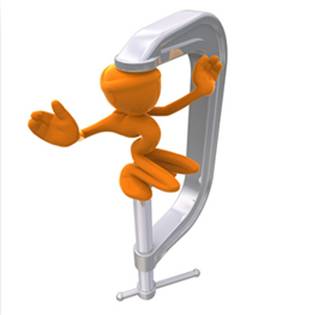 Pressure groups are groups without political power, but which aim to influence the political, or decision-making, process. They have specific interests and attempt to influence businesses, people and government to help achieve their objectives. They may have a very narrow focus (e.g. a local group trying to prevent the building of a road), or they may have broader focus (e.g. environmental groups like Greenpeace). These groups are often referred to as single-cause or multi-cause groups.
Pressure groups are groups without political power, but which aim to influence the political, or decision-making, process. They have specific interests and attempt to influence businesses, people and government to help achieve their objectives. They may have a very narrow focus (e.g. a local group trying to prevent the building of a road), or they may have broader focus (e.g. environmental groups like Greenpeace). These groups are often referred to as single-cause or multi-cause groups.
Pressure groups can be split in all sorts of ways. These include:
- Local community groups - groups campaigning on specific local issues to try to improve an area or achieve a particular outcome.
- Environmental groups - groups trying to achieve an improved environment and prevent businesses and other from polluting excessively.
- Employee groups - these could include trade unions, which are trying to achieve better conditions for their members or perhaps other professional associations representing the interests of a particular group.
- Consumer groups - these are groups, which represent the interests of consumers and campaign to ensure that consumers get a fair deal from firms.
- Social groups - groups who campaign for changes in society. These may be political changes to give people improved rights or to reduce any discrimination against minority groups.

Can you think of a group that comes under each of these headings in your country?
Pressure groups will try to influence in a variety of ways:
- Lobbying politicians - pressure groups will often try to get politicians to support their cause and raise issues in government. If these changes are implemented firms may be constrained in their behaviour and suffer increased costs of operation.
- Lobbying Boards of Directors - pressure groups may often try to lobby firms directly and find sympathetic directors. They may even try to persuade the firm of their social responsibilities. In some cases they could even become shareholders and try to influence through active shareholding.
- Organising direct campaigns - pressure groups may try to influence consumers to boycott particular firms or products. For example, Greenpeace tried to organise consumers to boycott Esso over their involvement in President Bush's campaign and the subsequent refusal to sign the Kyoto Treaty.
- Lobbying investors - there has been a significant growth in recent years in 'ethical investment'. This may make many investors more open to influence from pressure groups to ensure that they only invest in ethically responsible ways.
- Preparing media campaigns - many pressure groups will aim to get as much media attention as possible for their cause. This will help raise the profile of the issue and if firms don't react appropriately, their public image may suffer. This may have a negative effect on their marketing.
The extent to which pressure groups are able to influence issues will depend on various factors, including:
- Their size - this can be financial size as well as their organisational ability.
- The popularity of their cause and their ability to mobilise the public.
- Their access to politicians - this will be a key determinant of their ability to influence the political process.
- The reputation of the pressure group and the respect they have from the general public.
The ability to organise pressure groups has been helped by the internet and social networking groups such as Facebook and MySpace. For instance, following the oil spill in the Gulf nearly a million people signed up to several Facebook campaigns to boycott BP products.
Public-private enterprise

In some situations, governments may not be in a position to provide a good or service for financial or policy reasons, even though this may be a government service. In this case they may create what is termed a 'public-private partnership' (often referred to as PPPs). This is where the government enters into a partnership with a private firm to build/develop the good or service and then perhaps to go on to provide or operate it on behalf of the government.

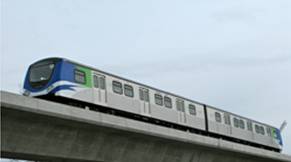 Examples of public-private partnerships include:
Examples of public-private partnerships include:
- International AIDS Vaccine Initiative (IAVI), which is a global non-profit making NGO promoting the development of development of vaccines to prevent HIV infection and AIDS. IAVI collaborates with the public and private sectors in both industrialised and developing countries.
- The Canada Line is a rapid transit line in the Metro Vancouver region of British Columbia, Canada. Opened in August 2009 it was built as a public-private partnership. Funding was provided by both government agencies and private partners.
Public contributions came from the following sources:
- Government of Canada: $450 million
- Government of British Columbia: $435 million
- Vancouver Airport Authority: $300 million
- TransLink: $334 million
- City of Vancouver: $29 million
Advantages and disadvantages
PPPs have been welcomed by many governments, but have also had their fair share of criticism. So what are their costs and benefits?
Benefits
- PPPs may enable to government to develop public assets faster and at lower cost to the country's taxpayers than by conventional public procurement.
- They may reduce the borrowing burden for government as the money can be raised by private firms
- PPPs allow for private sector management skills to be brought to bear on the development, management and operation of the good or service
- PPPs may reduce the cost per unit of providing the good/service as private firms may be able to develop and operate the project more efficiently
Costs
- PPPs must include a fair return for shareholders and so the overall cost may not eventually be as low as was first was thought
- Firms will not be required, unless the contracts are very specific, to take account of social needs and social objectives in their provision of the good or service
- PPPs often have very high costs associated with their provision for legal and contractual reasons. The contracts developed can be very complex and may take significant time and cost to draw up.

For more detail, why not have a look at the Wikipedia article on the Public Private Partnership. You can do that in the window below, or follow the previous link to open the article in a new window.

1.2 Types of organisation - questions
In this section are a series of questions on the topic - Types of organisation. The questions may include various types of questions. For example:
- Self-test questions - on-screen questions that give immediate marking and feedback
- Short-answer questions - a series of short-answer questions to help you check your understanding of the topic
- Case study - a case study with associated questions
- In the news - questions based around a topical business news article
Click on the right arrow at the top or bottom of the page to work through the questions.
Legal structure - short answer questions

Question 1
Distinguish between a sole trader business and a private limited business.
Question 2
Explain why is it usually cheaper to start a small business in the service sector than in the manufacturing sector?
Question 3
Describe a business plan and explain why it is so important to a newly established firm.
Question 4
Distinguish between a Limited Company and a plc.
Where has Willy Wonka gone?
Read the article Here's the chocolate factory, but where has Willy Wonka gone? (you can do this in the window below or follow the previous link to read the article in a separate window) and then consider answers to the questions below.

Question 1
Explain what is meant by a 'workers co-operative'.
Question 2
The article refers to Working World - a non-profit finance agency. Explain how the objectives of Working World may differ from those of a private bank.
Question 3
Analyse two advantages and two disadvantages of running Ghelco as a workers co-operative.
Question 4
Discuss the likely impact of changing Ghelco to a public limited company.
Fans splash cash for hot new band
Read the article Fans splash cash for hot new band (you can do this in the window below or follow the previous link to read the article in a separate window) and then consider answers to the questions below.

Question 1
Define the term 'share issue'.
Question 2
Examine other sources of finance that Four Day Hombre could have used to finance their first album.
Question 3
Discuss the risks that investors are taking by investing in this new record label.
With the downloading and sharing of music, the internet has become an increasingly important medium to distribute music and to introduce new bands. This idea of investing in music has developed as a way for bands to finance themselves in a market that is becoming ever more competitive and difficult for the large music labels to control. The following illustrate this trend:
Taking your chances online
Read the article Betfair takes a punt on stock market (you can do this in the window below or follow the previous link to read the article in a separate window) and then consider answers to the questions below.

You may also like to read the article Betfair set to list shares

Question 1
Define the terms:
- Entrepreneur
- Stock exchange
Question 2
Distinguish between a private limited company and a public limited company.
Question 3
Explain what is meant by the 'flotation' of Betfair?
Question 4
Analyse the advantages and disadvantages for Betfair of becoming a public limited company.
Starting a business US style
The news
We tend to think that the US is the place to start a small business. This might be the case and indeed many of the 'big names' in global business e.g. Hewlett Packard, did begin as a small business, literally in Mr Hewlett's garage. So, what does the US government give out as advice on how to start a small business? What follows is an edited version of some of their advice.
Small business marketing
- Discuss the products/services offered by your small business.
- Identify the customer demand for your small business.
- Identify the market, for your small business.
- Explain how your small business will be advertised.
- Explain the pricing strategy.
Financial management
- Explain the source of small business start-up capital.
- Develop a monthly small business-operating budget.
- Develop an expected monthly cash flow for the small business.
- Provide projected small business income statements.
- Discuss your break-even point of your small business.
- Discuss how you will maintain small business accounting records.
- Provide approaches to any small business problem that may develop.
Small business operations
- Explain how the small business will be managed.
- Discuss hiring procedures for your small business.
- Discuss insurance and leases relevant to your small business.
- Account for the equipment necessary to produce your products/services.
- Account for production and delivery of products and services.
The theory
This US government advice gives some advice for starting a business. This is a complex procedure and involves many activities. Follow the links below for further information on related theoretical topics.
Starting a business
Possible problems faced by start-ups
Businesses are the most vulnerable in the first two or three years following their formation. Indeed, in some developed countries business failures can be over half of business start-ups. Why is the failure rate so high in these early years?
- Finance is difficult to raise as new businesses have few assets to offer as security or collateral for loans, and banks and other investors view them as high-risk
- Cash-flow may be an issue because costs are often high in the early months as the business is investing in new assets, such as raw materials and tools and machinery and marketing heavily. The business may be profitable, if they get as far as selling the product. However, if they run out of cash, they cannot afford to pay bills or wages and the products may not be finishes or sold. In addition, new businesses tend to be small and do not possess economies of scale. Entrepreneurs may also lack key financial skills.
- Lack of brand and company loyalty as it takes time for a business to develop goodwill and a reliable customer base.
- Poor location may be an issue as the business may not have the funds to afford the high rents charged in premium sites. This is often the reason why many entrepreneurs operate from their homes.
- Lack of management experience may hamper decision-making and the dream of quick success and wealth may override the need for steady growth.
It is important to note that liquidity problems are the key reason for the early demise of new start-ups, rather than a lack of profitability.

Setting up a business
The following websites have resources to help any new start-up from marketing to accounts:
Using this website and working in groups of 2 - 5 people, undertake one or more of the following for a new online business set-up:
- Prepare a booklet containing a 15-point plan to help the online business set-up.
- Video or record a podcast of an interview with a 'new set up advisor' answering questions on the 'key issues' when setting up your online business.
- Prepare an article for a newspaper or financial magazine on setting up a new online business.
Split the tasks down between you. For example, allocate roles for researcher(s), interviewer and advisors.
You may also like to read two case studies on two online business set-ups:
Profit-based organisations
The different types of business ownership
When starting a profit-based organisation it will be one of the following forms:
- sole trader
- partnership
- private limited company
- public limited company.
We need to distinguish between the different types of business ownership and identify their main advantages and disadvantages
| Advantages | Disadvantages | |
|---|---|---|
| Sole trader |
|
|
| Partnerships |
|
|
| Private Limited Company |
|
|
| Public Limited Company |
|
|
Remember that those who found a business take the initial risks and make all the original decisions. For a sole trader both risk-taking and decision-making are their responsibility.
However, when a plc is formed, the owners and the shareholders are normally different people. Professional managers are appointed by the owners of a business to run the business on their behalf. This is referred to as the 'separation (or divorce) of ownership and control'. It is important to appreciate the problems associated with size and the divorce of ownership and control.
As the business grows it will need more finance and this is normally easier for Plc's. The complexity of operations will require the recruitment of specialist professionals. They often prefer to work for Plc's as the financial rewards, company benefits and promotion opportunities, tend to be better. However, managers controlling the decision-making process are employees, not owners. In theory they represent the owners, but in practice with Plcs, this is often not the case as the shares are held by thousands of 'owners' who may not share objectives or vote at general meetings. Remember that shareholders might consider profits, and therefore dividends, to be the prime reason for their investment; whereas managers may need to look to the longer-term survival and growth of the business as the expense of short term profits.
So, stakeholder conflict can arise as a business changes its business and legal structures.

Questions
- Outline the major factors involved in starting a business.
- Describe the main characteristics of the different forms of business ownership.
- Explain the reasons for converting a private limited company into a Plc.
- Examine how the divorce takes place between the ownership and control of a business.
Suggested answers
1.3 Organisational objectives - notes
We have looked at nature of business activity and the structure of organisations. We now need to look at the question 'why' organisations exist. This is the area of aims, objectives and goals. It is only when there are aims and goals, that it is possible to measure success by comparing actual performance against targeted performance. It is like navigation; you have to know where you are trying to go, before you know whether you are on, or off, course.
We also examine the concepts of ethics and Corporate Social Responsibility - areas of growing importance in the business world, not just because we should expect firms to act as responsible citizens, but also because their behaviour can provide competitive advantage.

By the end of this section you should be able to:
- Explain the importance of objectives in managing an organisation
- Explain the purpose of mission and vision statements and analyse their role
- Distinguish between objectives, strategies and tactics and how they interrelate
- Examine the reasons why organisations set ethical objectives, analyse the advantages and disadvantages of these and discuss their impact.
- Explain the different views that firms may take of their social responsibility in an international context
- Analyse the value of social and environmental audits

- Evaluate the need to change objectives in response to changes in the internal and external environments
- Discuss why a firm's view of its social responsibility, and society's expectations may change over time
- Analyse the impact of a change in society's views on social responsibility on a firm's behaviour in a national and international context
- Analyse the reasons why firms may choose different strategies towards their social responsibilities
Nature, role and importance of objectives
Form of aims and objectives
 It is necessary to understand two pairs of terms before we go any further.
It is necessary to understand two pairs of terms before we go any further.
- Strategy - this is a long-term plan illustrating how the business will achieve its corporate objectives. Strategic objectives are significant long-term goals. They normally relate to key business objectives such as profitability, asset value and market share.
- Tactics - these are the short-term activities carried out on a daily basis to implement the business strategy. It should be possible to arrive at a set of checkpoints when performance can be measured against success criteria.
The next pair of terms looks at the timeframe in which we consider aims and objectives.
- Long-term - the organisation is looking into the future, setting plans over a period of 1- 5 years
- Short-term - this is much closer in time. Tactical objectives may be daily, weekly or monthly. Anything relating to activities below one year is normally called short-term.
Short-term tends to be associated with tactical decisions and activities and long term with strategy, therefore:
The aims of a firm are its strategy. From these are derived tactical objectives. Any firm needs strategic aims so that all its stakeholders know where the business seeks to be. The shorter-term objectives are there to provide immediate targets and motivators for the managers and other employees.
The first, the most basic, and the perpetual goal of any firm is survival. Only after this has been secured can it develop other significant strategic aims. These may include:
- Increased profit
- Greater market share
- Elimination of competition
- Possible takeovers or mergers
- International expansion and market growth
- Corporate image
- Improving quality
Aims and objectives are there for everybody in the firm. They are there to give a target and to act as an encouragement or motivators to staff. They drive decision-making. It is important, therefore, to express them in the correct form of language.
Why have objectives?
It is only with objectives, targets or aims that a firm can know where it is going, and can measure its progress.

Do you really know the difference between aims, objectives and goals? Write what you think, then click Target.
Hierarchy of Objectives
If you would prefer to view this interaction in a new web window, then please follow the link below:

One example of this is Hewlett Packard. To examine their corporate objectives and shared values follow the link below:
Changing objectives
Changing objectives in response to changes in the external and internal environment

Aims and objectives are not fixed, but will change from time to time in response to changes in the internal and external environments, which offer opportunities or pose threats.
Internal environment:
This is the part of a business under its control and includes factors such as developing human resources, financial planning and marketing.
The drivers to change in the internal environment may be negative or positive.
Negative changes may include:
- High staff turnover and/or absenteeism
- Falling quality standards
- Loss of productivity and falling motivation and morale
- Liquidity problems
- Increasing costs
These negative changes are a threat to the business and must be addressed.
Positive changes may include:
- The recruitment of talented and experienced individuals
- Improving productivity and quality
- Successful innovation
- Exceeding performance measures
Again positive changes should elicit some changes in business activity. These might involve changing budgets or success criteria or strategic objectives. If change does not happen the firm may still perform well, but below its capabilities.
External environment:
This external environment is the 'world beyond the firm', and is not controllable by it. It includes political, economic, social and technological change which impacts on the business and its markets. The external environment provides the opportunities for business growth and development and poses threats to its financial and operating activities.
The drivers to change in the external environment may be negative or positive.
Negative changes may include:
- Recession
- New competition
- Innovation and new products from competitors
- New laws and regulations which increase the firm's costs
- Changes in social behaviour and trends which will decrease demand for a firm's products and services
These negative changes are a threat to the business and must be addressed. Although the firm cannot change the external environment - it may alter its business practices and operations to reduce their effects.
Positive changes may include:
- Economic recovery and boom periods
- New technologies that will reduce production and/or operating costs
- Changes in consumer behaviour that favour the firm's products and services
- Reductions in taxes
As with internal changes, changing external factors should lead the business to review its corporate objectives and strategy and adjust its plans for the future.
The firm must consider how significant the changes are, and how important it is to change... and in what time span. Change can be expensive and involve considerable organisational adjustments. It also may unsettle stakeholders.

Statements - mission and vision
There is much confusion about these two statements, simply because there is a lack of clarity about what they concern. In practice, they may overlap or one may be a part of the other.
Many people mistake vision statement for mission statement, and sometimes one is simply used as a longer term version of the other. However, the vision statement should describe why it is important to achieve the organisation's mission, by defining its purpose or broader goal. A mission statement is more specific to what the enterprise can achieve. The vision statement may relate to broader social aims, such as the reduction of global warming, health improvements or human advancement.
The vision statement describes why it is important to achieve the firm's mission.
The mission statement

"A business is not defined by its name, statutes or articles of incorporation. It is defined by the business mission. Only a clear definition of the missions and purpose of the organisation makes possible clear and realistic business objectives."
Peter Drucker
It has become popular for firms to publish 'mission statements'. They define an organisation's purpose and primary objectives, stating 'who we are and what we do'. By publishing the firm's mission statement it is believed that everybody will know what their business is and relate to its purpose. Employees should be motivated and fired up to achieve.
This only works, however, if everybody understands and relates to the mission. The mission statement acts as a whole philosophy for the firm to help give a clear statement of direction for the present and so needs to have immediate relevance. Of course, it helps if the mission corresponds to the outlook and purpose of the individuals who make up the organisation, and if they have contributed to the development of that mission. If the mission is perceived as a glib slogan, designed by the marketing team, it will have little value.
Mission statements are targeted at internal and external stakeholders. This means that the statements have to be suitable for a wide range of readers. Internally, they are meant to encourage and motivate everybody, thus they must give a target, to which the reader can relate. This is not easy, and an unsuitable statement could, arguably, do more harm than good.
The mission statement is not specific and does not usually have quantifiable targets, or measures, rather it is aimed at helping customers, employees and all other stakeholders to understand the direction and objectives of the firm. The mission statement should:
- be a concise statement of where the business is now, but also show its future direction
- provide a statement of perceived success - what the business wants to achieve in the long term, as well as now
- allow the business to use the statement for the development of specific goals and objectives to achieve their aims.
- provide inspiration to employees to achieve the aims or vision set out by the statement

Mission Statements
Apple Computers:
Apple is committed to protecting the environment, health and safety of our employees, customers and the global communities where we operate. We recognise that by integrating sound environmental, health and safety management practices into all aspects of our business, we can offer technologically innovative products and services while conserving and enhancing resources for future generations. Apple strives for continuous improvement in our environmental, health and safety management systems and in the environmental quality of our products, processes and services.
Walt Disney:
The mission of The Walt Disney Company is to be one of the world's leading producers and providers of entertainment and information. Using our portfolio of brands to differentiate our content, services and consumer products, we seek to develop the most creative, innovative and profitable entertainment experiences and related products in the world.
The vision statement
While a mission statement is of immediate relevance to all stakeholders as it is about the present and the way in which a company wants to advance, a vision statement is a more general statement looking at where the business desires to be in the future and the values that it will take with it along the way. A vision statement is less quantifiable than a mission statement as it is a statement about what the organisation wants to become and what it wants to achieve.
The vision statement should make employees feel proud, motivated, and excited to part of something much larger than them. It should stretch the organisation's capabilities and give shape and direction to its future.

Westin Hotels
Year after year, Westin and its people will be regarded as the best and most sought after hotel and resort management group in North America.
Chevron
At the heart of The Chevron Way is our vision ...to be the global energy company most admired for its people, partnership and performance.
Heinz
Our vision, quite simply, is to be "the world's premier food company, offering nutritious, superior tasting foods to people everywhere." Being the premier food company does not mean being the biggest but it does mean being the best in terms of consumer value, customer service, employee talent, and consistent and predictable growth. We are well on our way to realizing this vision but there is more we must do to fully achieve it.

Web task
Go to the web sites of 5 major firms and find their mission statements. How do they differ? Can you find examples of corresponding vision statements?
Look at some of the mission statements of the companies profiled on Biz/ed. Try a search on the Biz/ed site using the search term 'mission statement'. You can have a go at this in the window below.
For more information on mission and vision statements, why not try the following links?
- Mindtools.com - mission and vision statements
- Wikipedia - strategic planning - mission and vision statements
Unfortunately the iconic Dilbert mission statement generator has now been discontinued, but there are a number of alternatives available such as the one from ISMS.
Alternatively, you can have a go at this in the window below and generate a few random mission statements!
Another way of generating pointless mission statements is to download a mission statement generator from the Apple apps store, if you have an iPhone or iPad. There are several free versions available.

Mission and Vision Statements: Coca-Cola and Innocent
In 2010, Coca-Cola bought a controlling stake in the Innocent smoothie company. Many commentators criticised the owners of Innocent, accusing them of selling out on their ideals.
 Innocent is the UK and Europe's favourite smoothie company, selling natural healthy products in over 13 countries and employing over 220 people across Europe. Innocent's mission is to make it easy for people to do themselves some good and to make it taste good too. In addition to 100% pure fruit smoothies, their successful latest products - orange juice and veg pots - fit with their mission of getting natural healthy products to as many people as possible.
Innocent is the UK and Europe's favourite smoothie company, selling natural healthy products in over 13 countries and employing over 220 people across Europe. Innocent's mission is to make it easy for people to do themselves some good and to make it taste good too. In addition to 100% pure fruit smoothies, their successful latest products - orange juice and veg pots - fit with their mission of getting natural healthy products to as many people as possible.
 As a business, Innocent wants to leave things better than they find them. This is reflected in everything they do, from sourcing their fruit from farms with higher social and environmental standards to developing the world's first 100% recycled plastic bottle to donating 10% of profits every year to charity.
As a business, Innocent wants to leave things better than they find them. This is reflected in everything they do, from sourcing their fruit from farms with higher social and environmental standards to developing the world's first 100% recycled plastic bottle to donating 10% of profits every year to charity.
"Being accountable to our customers is something that is in our blood. In the summer of 1998 when we had developed our first smoothie recipes but were still nervous about giving up our proper jobs, we bought £500 worth of fruit, turned it into smoothies and sold them from a stall at a little music festival in London. We put up a big sign saying 'Do you think we should give up our jobs to make these smoothies?' and put out a bin saying 'YES' and a bin saying 'NO' and asked people to put the empty bottle in the right bin. At the end of the weekend the 'YES' bin was full so we went in the next day and resigned."
 Coca-Cola Company: Mission, Vision & Values
Coca-Cola Company: Mission, Vision & Values
The following is an extract from the Coca-Colas website, which presents an outline of its 2020 vision for the business.
To continue to thrive as a business over the next ten years and beyond, Coca-Cola say it must look ahead, understand the trends and forces that will shape their business in the future and move swiftly to prepare for what's to come:
"We must get ready for tomorrow today. That's what our 2020 Vision is all about. It creates a long-term destination for our business and provides us with a "Roadmap" for winning together with our bottling partners."
Our Mission
 Our Roadmap starts with our mission, which is enduring. It declares our purpose as a company and serves as the standard against which we weigh our actions and decisions.
Our Roadmap starts with our mission, which is enduring. It declares our purpose as a company and serves as the standard against which we weigh our actions and decisions.
- To refresh the world...
- To inspire moments of optimism and happiness...
To create value and make a difference.
Our Vision
Our vision serves as the framework for our Roadmap and guides every aspect of our business by describing what we need to accomplish in order to continue achieving sustainable, quality growth.
- People: Be a great place to work where people are inspired to be the best they can be.
- Portfolio: Bring to the world a portfolio of quality beverage brands that anticipate and satisfy people's desires and needs.
- Partners: Nurture a winning network of customers and suppliers, together we create mutual, enduring value.
- Planet: Be a responsible citizen that makes a difference by helping build and support sustainable communities.
- Profit: Maximize long-term return to shareowners while being mindful of our overall responsibilities.
Productivity
Be a highly effective, lean and fast-moving organization.
Our Winning Culture
Our Winning Culture defines the attitudes and behaviours that will be required of us to make our 2020 Vision a reality.
Live Our Values
Our values serve as a compass for our actions and describe how we behave in the world.
- Leadership: The courage to shape a better future
- Collaboration: Leverage collective genius
- Integrity: Be real
- Accountability: If it is to be, it's up to me
- Passion: Committed in heart and mind
- Diversity: As inclusive as our brands
Quality
What we do, we do well

Questions:
- Using Coca-Cola as an example, identify two differences between a mission statement and a vision statement.
- Explain why some critics argue that mission statements are no more than an exercise in public relations
- Analyse the role of vision and mission statements in the operations of Coca-Cola
- Discuss the reasons for Coca-Cola's purchase of a controlling stake in Innocent smoothies.
You may want to look at the following the following article to support your answer:
Short versus long-term objectives
The previous section showed how objectives can be long or short-term. It also demonstrated how they could change with time, particularly short-term objectives. These all link with planning and, in particular, corporate (company) planning.
The planning cycle
If you would prefer to view this interaction in a new web window, then please follow the link below:
Firms need to keep their long-term objectives in mind when they are making short-term tactical decisions. An opportunity may come up, but does it fit with the long-term objectives? Is it so attractive that the long-term objectives should be changed?
Long-term objectives are usually set by the directors, and only changed by them.
Short-term tactical objectives may well be delegated to senior, or middle, managers, who may also have the authority to change them, if necessary.
Changes in short or long term objectives can seriously influence the performance of a company and the morale of the employees. Remember, change is rarely popular, as people often feel threatened by it.
Short versus long-term objectives - a further explanation
Planning cycle - context of a firm
If you would prefer to view this interaction in a new web window, then please follow the link below:
Less formal, but powerful goals
Sometimes a firm (and its staff) is motivated less by the formal statements and pronouncements and printed documentation, but by more informal statements by the entrepreneurs and leaders of businesses, stating how they see the PURPOSE of the business and the vision they have. Companies, may be more animated by this purpose.
Two good examples of this type of motivating statements are the following:

![]() 'Skype's goal is 'to be destructive, but in the cause of making the world a better place'.
'Skype's goal is 'to be destructive, but in the cause of making the world a better place'.
Niklas ZennstrŲm and Janus Friis the co-founders of Skype
![]() 'I want to put a ding in the universe'.
'I want to put a ding in the universe'.
Steve Jobs of Apple Computers
By 'ding', Steve Jobs was referring to spiritual powers, Ding an sich - 'a thing in itself' - whose sheer potential to do things overrode the importance of anything it could actually do.
Both Skype and Apple are dynamic young companies, and their staff may well be motivated by enthusiasm, spirit and ambition of the founders, summarised in these statements
Management by objectives
The term, management by objectives, was first popularised by the management theorist, Peter Drucker, in 1954 in his book "The practice of management". It refers to the process of management and employees agreeing on objectives for the organisation. This is intended to ensure that they understand the objectives, feel that they can be achieved and know their part in that process.
Management by Objectives is not without its critics, however. Some management theorists, including W. Edwards Deming, suggested that the MBO process tends to focus employees on the identified objectives at the expense of other requirements, and that the pressure to complete the identified objectives may result in them being performed poorly. Deming suggests that the setting of objectives is less important than the process of leadership.
Management by objectives is often used to help a firm achieve targets. It is generally considered that objectives set in this way need to be what are called 'SMART 'objectives.
SMART objectives
If you would prefer to view this interaction in a new web window, then please follow the link below:

For some more information on management by objectives and SMART objectives, look at the following links:
- Valuebasedmanagement.net - Management by objectives and SMART objectives
- Mindtools.com - Management by objectives
- Wikipedia - Management by objectives
Ethical objectives
Ethics are the moral principles and values that underpin human behaviour. Morals are concerned with what is 'right' or 'wrong'. Business ethics are, therefore, the moral principles that underpin business behaviour. Whether actions carried out by organisations and their employees are morally acceptable must, however, be judged in the context of the society and the times in which they operate.
An ethical business is one which applies a set of moral principles to all interactions with stakeholders, such as its treatment of employees, customers, suppliers and shareholders. Being ethical means a business goes beyond merely complying with laws and regulations, but makes choices about what it is prepared to do, and what it will not. Therefore, an ethical business strategy may exclude behaviour, which is legal, but conflicts with the businesses ethical policy.
Setting ethical objectives is the process by which organisations apply ethical values to their targets and the actions by which they will achieve them. These ethical values should cover all the actions of the organisation from tactical to strategic.
Businesses may be faced with some of the following issues, which have ethical dimensions:
- Should we produce in a low-cost developing economy?
- Should we promote products that might damage health?
- Should we seek to undermine our competitors?
- Should we pay minimum wage rates to our employees?
- Should we employ migrant labour to cut costs?
- Should we transfer our production units to countries with less strict health and safety laws?
 Texas Instruments
Texas Instruments
Ethics is the cornerstone of TI
Our reputation at TI depends upon all of the decisions we make and all the actions we take personally each day. Our values define how we will evaluate our decisions and actions and how we will conduct our business. We are working in a difficult, demanding, ever-changing business environment. Together, we are building a work environment on the foundation of integrity, innovation and commitment.
Together, we are moving our company into a new century one good decision at a time. Our high standards have rewarded us with an enviable reputation in today's marketplace: a reputation of integrity, honesty and trustworthiness. That strong ethical reputation is a vital asset, and each of us shares a personal responsibility to protect, preserve and enhance it. Our reputation is a strong, but silent partner in all business relationships. By understanding and applying the values presented here, each of us can say to ourselves and to others, "TI is a good company and one reason is that I am a part of it."
Know what's right. Value what's right. Do what's right.
For more on the values and ethics of Texas Instruments and to read about its 'quick ethics test select the following links:

As with any business decision, much will rest on whether it is cost-effective to adopt an ethical stance. Some firms, for example Body Shop, made an ethical stance part of their unique selling point and some investment funds are now doing the same. However, the majority of large corporations now claim to have high ethical standards and have a range of policies on their websites that support their claims and so it is now harder to use ethics as a USP. Whether these policies are actually put into practice is often debatable.

Follow the links below to read the ethical polices of the following organisations:
To be effective in applying ethical standards a business needs to:
- Look carefully at the attitudes, values and standards of individual employees and if these fit with corporate expectations.
- Make certain that a corporate culture exists, is known by all employees and is evenly applied by all responsible for decisions relevant to the code of ethics.
If this approach is not followed the company runs the risk of having clashes between its values and their application. Delegation will be jeopardised by inconsistency and problems will arise.
If the company does adopt an ethical approach, it may have a number of benefits including:
- Improved motivation among employees - many employees will be more committed if they can see an ethical approach adopted by the company
- Reduced labour turnover - improved motivation is also likely to result in improvements in the recruitment and retention of staff ,who will be more loyal to an ethical company
- Improved customer perception - consumers will often react positively to a more ethical approach and this may be used (as it is by many FairTrade companies) as a unique selling point for the business. It also helps provide the brand with a more positive association, which should enhance brand value.
A growing number of investors do not want to invest in companies which pollute or damage the environment, deal in the arms trade, or support oppressive regimes. Many also don't want to support tobacco companies or those that profit from gambling, pornography or the production of alcohol. More recently people have begun to express concern about general business ethics and how companies conduct their day-to-day business practices. These are no longer minority interests.
As a consequence there are a growing number of companies that specialise in ethical investments. They promise to examine the ethical credentials before they invest their clients' funds. One such firm is F&C, which lays out its investment criteria in its guide to ethical investing.
However, an ethical approach to business operations may have a number of potential problems. These may include:
- Higher costs - using ethically sourced raw materials, or producing in a way that is more ethical, is likely to raise costs. If the company is able to use the ethical considerations to develop the brand, then this may not be a problem, but if they are in a highly price competitive market then it may be more of an issue.
- Problems with suppliers - suppliers may not hold the same ethical views as the firm and this may lead to possible conflicts. It may also make sourcing supplies more problematical.
- Lower profit - if the higher costs cannot be passed on to the consumer, then this is likely to lead to lower profitability for the firm.
- Stakeholder conflict - not all stakeholders will be keen on an ethical approach if it compromises their objectives. For example, some investors may withdraw if they feel that the ethical stance of the company is affecting its long-term viability or profitability.
Remember that ethics may be a subjective concept, varying from country to country and culture to culture and, of course, from individual to individual. Even within a single firm there will be a huge range of opinions about what is right and what is wrong. The only difference though between a business and everyday life, is that employees should know a little about the firms values before they join, and to some extent are signing up to these.
Ethics also covers different areas than that covered by the law. It is possible for a business to act legally, but in a manner that many would consider unethical. Selling cigarettes or weapons, for instance, fits into this category.
Corporate social responsibility
 Firms have a range of responsibilities to various stakeholders including the wider community in which they operate. These responsibilities are often called Corporate Social Responsibility (CSR). A successful range of socially aware policies should engage more members of the public and boost trade. They might also reduce costs as law suits and lost orders should be less. Customer loyalty, employee morale and retention should also improve as a result of a more socially aware strategy and its concurrent objectives.
Firms have a range of responsibilities to various stakeholders including the wider community in which they operate. These responsibilities are often called Corporate Social Responsibility (CSR). A successful range of socially aware policies should engage more members of the public and boost trade. They might also reduce costs as law suits and lost orders should be less. Customer loyalty, employee morale and retention should also improve as a result of a more socially aware strategy and its concurrent objectives.
CSR is an umbrella term which covers firm's ethical objectives. However, although CSR is about behaving ethically, there is a distinction between CSR and ethics. Ethical behaviour is about individuals and an ethical policy produced by an organisation is about managing the behaviour of individual employees and possibly, other stakeholders. CSR is focused on the behaviour of the organisation itself as opposed to the actions of individuals within it. It is about the role of the organisation in its environment and managing how that interaction takes place.
However, there are a number of barriers to corporate responsibility that prevent businesses behaving in the most socially desirable manner. The first and most important of these constraints is cost. Behaving in a socially responsible way for many businesses will raise their costs and given the pressure on them to maintain their global competitive advantage, they may be unwilling to change their method of operation. Firms may often act ethically when profits are high, but change their behaviour when under economic pressure.
Business has a responsibility to the society in which it operates. Members of society are stakeholders (have an interest in how the business operates) and need to be treated accordingly.
By being socially responsible firms hope to be seen as:
- Good employers
- Responsible capitalists
- Preserving a good image, which should allow them to build sales
- Being trustworthy and a worthy of customer loyalty
 Texas Instruments
Texas Instruments
You may like to read Texas Instruments section on Corporate Social Responsibility:
and its:
- 2009 Corporate Citizenship Report summary.
Being socially responsible is likely to increase costs. It may also take time for employees to adjust to what, for some, may be radical changes. It may also be that what seems to be a good idea to one set of stakeholders is not fully appreciated by another. For example, the cutting of dividends to restore confidence in the business may not be popular with shareholders.
Differing views on Social Responsibility
There is much debate about the role of business and the level and extent of its responsibilities to society. Indeed, some commentators argue that it is not the job of business organisations to be concerned about social issues and problems.
There are two main schools of thought:
It is the free market (capitalist) view that the prime objective of a business is not to act in a socially responsible manner if, the extra costs incurred reduces the distributable profit to its key stakeholder, the owners of that business. It is argued that it is the role of government and the legal system to protect the environment and individuals affected by production. The following points are made:
- Managers are employed to generate wealth for the shareholders - not give it away
- Social improvements, such as better health care and greater life expectancy are the result of free market economies driven by the free market
- Free markets contribute to the effective management of scarce resources
- Any additional costs will be passed onto the customer in the form of higher prices reducing social welfare
- Regulation should be kept to a minimum since because it stifles competition as it creates an additional barrier to market entry.
The corporate social responsibility view is that business organisation like all 'citizens' have a responsibility to society to minimise the effects of business operations.
- Those managing business need to recognise that they rely on society to provide a profitable environment, and no business has the right to operate at the expense of that society
- There is a contract between business and society involving mutual obligations and responsibilities
- A business should not act just for profit, but do what is right, just and fair, promoting human welfare.
 However, the middle ground can be argued that acting socially responsibly is a form of enlightened self interest. Although acting responsibly is costly and possibly inconvenient, it is believed to be in the firm's best long term interests. This is a 'short-run versus long-run argument', that you will see arise many times in your business and management course.
However, the middle ground can be argued that acting socially responsibly is a form of enlightened self interest. Although acting responsibly is costly and possibly inconvenient, it is believed to be in the firm's best long term interests. This is a 'short-run versus long-run argument', that you will see arise many times in your business and management course.
Environment
A key area of corporate social responsibility is the impact that a firm has on the environment and this attracts perhaps more media and other coverage than many other areas of this important topic. We consider this area in more detail later in this topic (section J13).
Policies to implement objectives of Social Responsibility
Many businesses now produce an 'environmental audit' or 'sustainability report' (generally produced by a specialist consultancy firm) to try to show clearly to their stakeholders the impact they are having on the environment.

Why not try a wider web search to try to find some examples of environmental audits? Or perhaps you could have a look at BP's 2009 sustainability review to see what they choose to report on. This is also available from the environment and society section of their web site.
Of course, although environmental statements show intent to be socially responsible, it is not always the case that actual business practice matches that intent. The 2010 oil spill in the Gulf of Mexico led to much criticism of BP and its environmental credentials. Friends of the Earth produced a synopsis of the oil-spill and the environmental disaster, including a YouTube videos and downloadable factsheet and resource links which you can read by following the link to their site.

CSR Questions:
- Define the terms:
- Corporate social responsibility
- Environmental audit
- Explain the different views that firms may take of their social responsibility in an international context.
- Analyse the value of social and environmental audits to different stakeholder groups.
- To what extent will the 2010 oil spill affect BP's strategy to present itself as a socially responsible company?

Changes in a firm's view of its social responsibility over time
A firm's attitude to social responsibility will be moulded by its internal environment and by factors outside of the business.
Internal factors:
- A business is made up of individuals, who are also consumers and citizens. The attitudes and norms of a business, therefore, must reflect the views and norms of these individuals, who in turn are influenced by the society in which they live.
- Corporate cultures evolve and change over time with staff joining and leaving the business. New recruits, particularly at a senior level may bring new views and attitudes to the business.
- Profitability and cash-flow may influence how socially responsible a business can afford to be.
- The attitude of key stakeholders may be crucial. Shareholder may be able to force through changes at an AGM or elect managers that will reflect their views - whether in favour of more socially responsibility or against.
External factors:
- Government laws and regulations will constrain business behaviour.
- The state of the economy will influence how much firms are prepared to spend on measures to improve their socially responsible image. In times of recession there may be less room for this 'voluntary' expenditure.
- Pressure groups may force firms to change business practices by 'naming and shaming', creating bad media stories and lobbying government to take action. All of these may undermine a firm's image and reduce its profitability.
- The behaviour of competitors is crucial. If competitors take their responsibilities less seriously and have lower costs, they may undercut firms prepared to be good citizens. This may prove disastrous and force a change to a less responsible policy.
Changes in attitudes to social responsibility over time
The external environment is dynamic and social attitudes and norms change over time. This can be seen in all walks of life such as in attitudes to discrimination, working conditions, education and smoking, all of which have altered radically over a relatively short period of time.

It must be remembered, however, that these social changes are not consistent form country to country or culture to culture. For example, attitudes to the role of women in societies, including rights in the workplace are very different across the globe and indeed from region to region.
Firms will need to monitor trends in society and adapt their objectives if necessary. Firms may wish to be responsible, but most will seek to benchmark their behaviour against the industry norm.

Corporate social responsibility index
Business in the Community (a UK organisation) has been producing a 'Corporate Responsibility Index' since 2002. Many UK companies are now using participation in this index for benchmarking purposes - to compare their performance against other companies.
The index results are published in the Financial Times.
The index considers their approach to corporate responsibility under four headings:
- Corporate strategy - this looks at how the nature of a business's activities, influences the company's values and how these are related to strategy.
- Integration - how well does the company organise, manage and integrate corporate responsibility throughout their operations.
- Management - under this heading the index looks at how well the firm manage their stakeholder responsibilities to the community, the environment, the marketplace and the workplace.
- Performance and impact - under this heading, the company's performance is assessed from two key impact areas; global warming and waste management. The company's are also assessed on two areas they choose from six which include human rights, product safety, occupational health and safety, workplace diversity and community investment.
Business in the Community has gathered statistical data to show a link between CSR and improved financial performance. On their site you will find a link to a PDF report on The Value of Corporate Governance. This report provided details on the statistical basis for the claim that firms which focus on CSR obligations, perform better in the market place.
Fortune magazine produces a global list of the world's most admired companies. Apple, for example, topped the 2010 list. One of the assessment criteria is social responsibility, and Fortune publishes a list of the best and worst companies in this category. In 2010, the three highest regarded companies for social responsibility were UPS, Starbucks and Marriott International. The least admired companies were Las Vegas Sands, Japan Airlines and Dillard's.

For further information on the criteria used for the Business in the Community corporate CR Index, you may like to look at the following web links:
- Executive summary 2009 Corporate Responsibility Index
The following are links to the three best companies for social responsibility in the 2010 Fortune list:


Exercise:
Using one of the above companies as an example, analyse the advantages of being socially responsible.
You can support your investigation of CSR, by examining the websites of two NGO pressure groups: Greenpeace and Friends of the Earth to see their actions in the field on corporate behaviour.

1.3 Organisational objectives - questions
In this section are a series of questions on the topic - Organisational objectives. The questions may include various types of questions. For example:
- Self-test questions - on-screen questions that give immediate marking and feedback
- Short-answer questions - a series of short-answer questions to help you check your understanding of the topic
- Case study - a case study with associated questions
- In the news - questions based around a topical business news article
Click on the right arrow at the top or bottom of the page to work through the questions.
Nature of objectives - short answer questions

Question 1
Distinguish between aims and objectives.
Question 2
Distinguish between strategy and tactics.
Question 3
Examine reasons why is it important for a firm to have a strategy.
Ethical objectives - case study

The rules of the world of business are simply not fair! The staple meal in Senegal is imported and much of it originates in the USA. In Ghana tinned tomatoes are often from Italy, yet the country is a grower of this staple food. Just how can such poor countries such as Ghana and Senegal break out of this vicious cycle?
Their workers receive very small sums of money in their wage packets, have very few of the rights we have in the developed economies and much of the value added to their exports takes place thousands of miles away from the lands in which the crop or resource was grown or mined.
Can we in the developed world just stand by and let this happen, or should we fight for a more 'level playing field' in world trade and how we buy and sell our goods?
Should we demand of our retailers:
- A policy of monitoring how our favourite products are grown etc and provide us with evidence that the standards we expect have been evident in the work practices of the growing or manufacturing country?
- A policy that builds into buying systems an ethical dimension?
- A policy between all concerned in the distribution chain that an agreed code of conduct be accepted?
- That those who earn profits from what we buy from them act responsibly and monitor how their policies affect both society and the environment?
Perhaps if more of us raised these issues the world might just be a better place? Or will we leave it all to pressure groups?

Question 1
Explain what is meant by
(a) pressure group, and
(b) ethical trading.
Question 2
Discuss how the actions of pressure groups alter the ways in businesses buy and distribute products and services.
Question 3
Examine how a supermarket may benefit from introducing ethical trading.
Question 4
To what extent will an environmental and social audit benefit a business?
Ethical objectives - short answer questions

Question 1
Is it important that a business recognises the importance of society?
Question 2
In what ways might a growing population impact on business?
Question 3
Explain why all businesses will face ethical decisions.
Question 4
Discuss why businesses are increasingly concerned by their possible impact on the environment.
Question 5
Explain the purpose of an environmental audit.
Intel and CSR

Podcast - Corporate Responsibility
Please listen to this podcast on ethics and social responsibility and have a look at Intel's website section on corporate responsibility and its corporate responsibility report by following the previous links. Then answer the questions below:

Question 1
Define the term 'corporate social responsibility'
Question 2
Describe Intel's main corporate responsibility priorities.
Question 3
Explain how Intel integrates corporate responsibility and business ethics into its training and reward systems.
Question 4
To what extent does being environmentally sensitive and socially responsible create competitive advantage?
What is ethical investing?
Read the F&C Guide to Ethical Investing.
You can read this in the window below or follow the previous link to read the article in a separate window) and then consider answers to the questions below.

Question 1
Using the information from the report, explain what is meant by:
- Ethical Investing
- Ethical investment funds
- The criteria for ensuring investment is ethical
Question 2
Evaluate the claim that investment in ethical funds makes financial sense.
Question 3
Discuss the view that the concept of ethical behaviour is rightly different between different external stakeholder groups.
CSR and its link to personal and moral integrity

Watch the following videos on corporate responsibility and integrity.
In this first video, Truett Tate discusses the connection between personal and moral integrity in his career and the lessons has learned from his business experiences.

Group discussion
Do you believe that the responsibility to act ethically in your business dealings should ever be set aside if this honesty risks the survival of your business and the laying off of thousands of staff as a consequence?
In this second video, Jamie Mitchell, Managing Director of Innocent Drinks discusses whether a business should listening to its consumers when making business decisions.

Group discussion
Do you believe that Innocent smoothies should have supplied McDonalds with drinks to be part of their 'happy meals'?
You can watch more Doughty Centre Lessons on Corporate Responsibility and Sustainability debates on YouTube.
A legal right to drill, but do they have a moral right?
Read the article Nigeria's agony dwarfs the Gulf oil spill (you can do this in the window below or follow the previous link to read the article in a separate window) and then consider answers to the questions below.

You might also like to look at the following articles:

Question 1
Explain the difference between morals and ethics.
Question 2
Explain why the oil spills in Niger Delta have not received the same publicity as the BP Oil spill in the Gulf of Mexico
Question 3
Analyse possible strategies that may be used by pressure groups to try to prevent Oil Companies from drilling in environmentally sensitive areas
Question 4
The oil companies are "as likely to curtail their hunt for new sources of energy as turkeys voting for Christmas", says Friends of the Earth.
Discuss the view that pollution is the acceptable by-product of the search for new sources of scarce resources as it preserves the standard of living of consumers around the world and maintains the profits and employment levels of major corporations.
Social entrepreneurship
Two of the aims of the business and management programme refer to ethics and to social responsibilities of organisations:
To:
- promote awareness of social, cultural and ethical factors in the actions of organizations and individuals in those organizations
- appreciate the social and ethical responsibilities associated with businesses operating in international markets.
So the IB programme encourages a broad view of business, from profit-making to non-profit making, and asks students to examine what business is and what it does, or should do, in a number of national and international contexts.
In this section we examine a relatively new approach to employing business techniques in a not-for-profit setting, to improve social conditions and opportunities.

Read the articles:
- Social Entrepreneurs (and listen to the podcast if you have time)
- Business skills solving social ills
(you can read these in the windows below or follow the previous link to read the article in a separate window) and then consider answers to the questions below.
You may also like to read the articles Young, gifted and not for profit and Time for a new kind of capitalism?

Question 1
Define the term 'social entrepreneurship'.
Question 2
Many people argue that social issues are not 'the business of business'. Discuss the validity of this approach.
Question 3
"A new breed of compassionate capitalists are beginning to stamp their mark on the world as 'change-agents' for society." Explain what is meant by this statement.
Question 4
Analyse how the objectives of a social entrepreneur will differ from those of other entrepreneurs.
1.4 Stakeholders - notes
So far we have examined the nature of business activity and types of organisations and their objectives. In the next section we examine stakeholders. The concept of stakeholders is fairly recent in the business lexicon. It was introduced to highlight the fact that businesses are not just involved in production of goods or the delivery or resources, but have a range of responsibilities to different groups who have an interest in their activities. These stakeholder groups have varying requirements from the firm, and the firm has different responsibilities to each of the groups. The result may be conflict.

By the end of this section you should be able to:
- Explain the interests of internal and external stakeholders and possible areas of conflict between them

- Evaluate possible ways to overcome stakeholder conflict
Stakeholders
 A business does not exist in isolation. A whole range of individuals and groups of people, as well as other firms and public organisations, have an interest in the survival and operation of a business. We call these groups stakeholders, as they have a stake, investment, or interest in the future of the company. More often than not, this stake is financial, although not always directly.
A business does not exist in isolation. A whole range of individuals and groups of people, as well as other firms and public organisations, have an interest in the survival and operation of a business. We call these groups stakeholders, as they have a stake, investment, or interest in the future of the company. More often than not, this stake is financial, although not always directly.
Stakeholders
A stakeholder is anyone, who has an interest in the operation and survival of the firm or business, or is affected directly or indirectly by the operations, such as the local community. This interest is usually financial or has a financial aspect. Stakeholders can be separated into internal and external stakeholders. Internal stakeholders are groups like the owners, managers and employees, while external stakeholders may include the local community, suppliers to the firm and the government. Their interests may often conflict, particularly in the short-term
Types of stakeholders
Internal and external stakeholders
If you would prefer to view this interaction in a new web window, then please follow the link below:
Internal stakeholders may have different objectives and level of risk. Examine the chart below:
| Stakeholder | Objective | Risk |
|---|---|---|
| Shareholders (may be companies not people) | Dividend income | Small, if investment is part of the portfolio of shares owned. |
| Directors - executive |
Income and power |
Higher, but may have many directorships, and savings. |
| Directors - non-executive | Many, depending why they are there. Gives some income. | May well be small, smaller than that of executive directors. |
| Managers | Income | Higher than Directors but lower than that of workers. |
| Workers | Continuation of job. Earnings to pay the cost of living | High. No job = no income. Jobs may be hard to get. |
The diagram below may help with remembering all the different stakeholders.
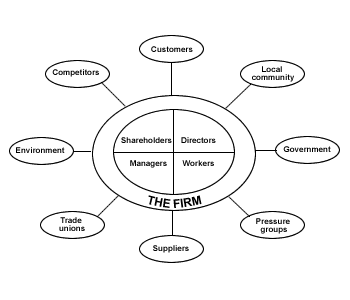
Figure 1 Stakeholders - internal and external
This model can be a useful plan when answering questions.
Remember, stakeholder questions usually boil down to 'it all depends'. It all depends to which stakeholder group the individual belongs.

Some food for thought
There are many groups who are stakeholders inside and outside of a firm who have an interest in its operation, and obviously its survival.
Have we reached a state where the interests of some stakeholders are becoming dominant, and even unfair? For instance, should shareholders interest be dominant or should firms be more sensitive to the roles and responsibilities it has in the society and the area in which it operates?

Why not try the following questions to check you are sure about internal and external stakeholders?
1 |
Internal and external stakeholdersMatch the following stakeholders to their status as either internal or external stakeholders. |
2 |
Internal and external stakeholdersMatch the following stakeholders to their status as either internal or external stakeholders. |
3 |
Internal and external stakeholdersMatch the following stakeholders to their status as either internal or external stakeholders. |
Stakeholder conflict
If you would prefer to view this interaction in a new web window, then please follow the link below:
However all the conflicts shown in the above diagram may only exist in the short run.
Competitive wages and good terms and conditions of employment for all employees should result in a highly motivated, content and productive workforce with low staff turnover. This in term leads to higher output and market share, economies of scale and lower costs, higher sales and profits, excellent image in marketing and recruitment terms.
This benefits all stakeholders in the medium and long term. Most large PLCs appear to be putting shareholder value as their key priority.
Decision-making and ethics - the shareholder v other stakeholders
Whenever decisions have to be made by a business the risk of stakeholder conflict is likely to arise. It is therefore not surprising that examiners often ask you to comment on this. Let's look at it in some more detail. As we saw earlier, being ethical may increase costs in the short run and reduce profits and dividends.
(a) The stakeholder - this wide-ranging group of interested parties have different feelings about how a business should be run. The needs of say employees and suppliers may be rather different. A careful balance will be needed and charting a course that satisfies most stakeholders can be difficult.
(b) The shareholder - they tend to like profits and a return on their investment. They have risked their money and want something for taking such a risk. In their opinion the correct way to run a business is to make profits and may see little reason for the firm to be more ethical than its competitors. The Directors have a legal obligation to the shareholders to act in their best interests. This obligation does not extend as broadly to other stakeholder groups.
So, do ethics pay for shareholders and other stakeholders? Well according to a recent report from the Institute of Business Ethics - they do. Follow the link below for a summary of their findings.
Does ethical behaviour pay?

Resolving stakeholder conflicts
Ultimately stakeholders all have an interest in the performance of the business and this is not helped by stakeholder conflict which can be extremely damaging. Poorly motivated staff, for example will lead to lower productivity, efficiency and lower profits. Even worse, would be conflict between management and the workforce leading to action industrial such as strikes.
The outcome of negotiations will be influenced greatly by the relative strengths of the stakeholder groups. Large multinationals, such as supermarket chains are able to impose cheaper prices on suppliers fearful of losing large orders. Employees, backed by powerful unions, may be in a position to force small firms into improving terms and conditions of employment. International pressure groups can exert considerable pressure to change behaviour on even the largest of organisations fearful of the effects on their brand and corporate image if they do not comply.
Potential Solutions
Businesses or governments will sometimes hire respected individuals, or groups, to:
- investigate the circumstances behind the disputes and to produce a report with potential solutions
- offer conciliation services and attempt to bring the conflicting stakeholders together in the same room or to liaise between the groups if this is not possible
- to arbitrate between the factions. Here both sides agree to accept the judgments of the independent body.
Other possible solutions include:
- Rewarding stakeholders in a way that links their performance to the success of the business. This can be achieved through:
- Share option schemes for staff - as shareholders, staff may be motivated to perform more effectively as employees, because increased profits should lead to higher dividends and increases on share value
- Performance related pay (PRP) - this may be a compromise between the desires of the shareholder to retain a lower wage base and the desire of the workforce to improve their terms and conditions. Employees will be rewarded if they increase the profitability of the business and the dividend payout for staff.
- Involving more stakeholders in the decision making process. For instance, representatives of individual stakeholders may be appointed as Directors of the business. It is not uncommon for employees to have a representative on the Board of Directors, and for major investors, such as banks to have the same. Some firms even appoint community Directors.
- Improving channels of communication between the stakeholder groups. Companies may keep their stakeholders informed of new developments through company magazines and websites. New technologies allow for the easy gathering of views through regular questionnaires. Even small firms may be able to afford this as simple, and free questionnaires can be produced using tools such as Survey Monkey. Alternatively the firm may hire Public Relations (PR) consultants or hire an internal PR team to keep the community and other stakeholders informed of the positive aspects of the business operations and attempt to minimise any negative impacts of their operations or planned changes.
1.4 Stakeholders - questions

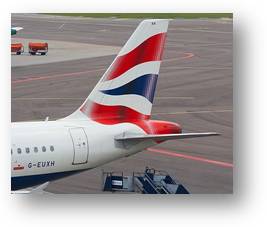 Stakeholder Conflict and Resolution
Stakeholder Conflict and Resolution
The 2010 British Airways dispute is a good example of stakeholder conflict as all stakeholders were affected negatively. Look at the following articles for background detail:
- Crew to strike for seven days as British Airways withdraws peace offer
- BA cabin crew strike talks break down without agreement
- British Airways tries to start again

Questions:
- Identify four stakeholders conflicts in this dispute
- Explain 3 reasons why British Airways appears so determined to resist the strike action.
- Analyse two potential short-run solutions to the dispute.
- Using the identified conflicts and your possible short-term solutions, evaluate the extent to which the different outcomes satisfy the long-term needs of each stakeholder group and commercial needs of the business itself.

1.5 External environment - notes
So far we have examined the nature of business activity, types of organisations and objectives and investigated the nature of stakeholders. Businesses have a range of aims and objectives, but they do not operate in a vacuum, but with a dynamic external environment which impacts on their decision making and operations. In this section we will look at the nature and scope of this external environment and how it provides opportunities and threats to the firm.

By the end of this section you should be able to:
- Prepare a PEST analysis for an organisation and use it to analyse the impact of the external environment on a firm
- Evaluate the impact of a change in any of the PESYT factors on a firm's objectives and strategy
- Analyse the impact that external opportunities and threats may have on business objectives and strategy
- Explain how external opportunities and threats can impact on decision making and SWOT analysis
External environment
The external environment - introduction
If you would prefer to view this interaction in a new web window, then please follow the link below:
These and many other factors make up the external environment and in the following section, we examine the components in further detail.
Introduction - PEST/STEP analysis
To help a business analyse the economic and business conditions they face, and to set strategic objectives for the future, they often start with a SWOT analysis.
Strengths (S) and Weaknesses (W) are internal factors, which influence performance. These are usually controllable by the firm itself, although the effectiveness of such control is dependent upon the strength and quality of management. Analysis of strengths and weaknesses is essentially an internal audit of where a firm is at present. If it is discovered, for instance, that motivation is poor, the firm may examine its recruitment or training, adjust payment schemes or look to empower the workforce.
Opportunities (O) and Threats (T) are the result of the external environment within which all businesses operate. These are uncontrollable factors, although the business will seek to forecast and prepare for change and remain flexible enough to react to changing circumstances.
PEST/PESTLE/STEEPLE analysis
PESTLE
If you would prefer to view this interaction in a new web window, then please follow the link below:
STEEPLE
If you would prefer to view this interaction in a new web window, then please follow the link below:
In the next few sections we look in more detail at the OPPORTUNITIES AND THREATS provided by each of elements of the external environment.
The legal and political environment - introduction
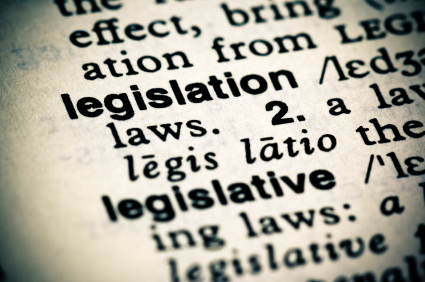 Governments want to encourage business activity, but they also need to pass laws and put in place rules and regulations to control business activity and avoid undesirable outcomes or negative externalities. They may pass regulations concerning the employment of people, environmental impact or perhaps constraints to ensure that all advertising is legal, decent and truthful.
Governments want to encourage business activity, but they also need to pass laws and put in place rules and regulations to control business activity and avoid undesirable outcomes or negative externalities. They may pass regulations concerning the employment of people, environmental impact or perhaps constraints to ensure that all advertising is legal, decent and truthful.
The legal environment therefore impacts on all business behaviour and can be split into a number of different areas:
- Employment legislation - rules, regulations and laws concerning the employment of people.
- Environmental legislation - laws, rules and regulations concerning the environmental impact that then operations of firms create.
- Consumer law - businesses sell to consumers and it is important that consumers have protection to ensure they are not misled or treated unfairly by firms.
- Competition law - competition is a healthy way to ensure that prices are kept down and that businesses innovate. Without competition firms may be in a position to exploit consumers and so governments often legislate to try to ensure competition is fair and to prevent the development of monopolies.
- Information /reporting law - governments often legislate to ensure that the information that firms provide is accurate and reflects the true state ('a true and fair view') of the business. These types of rules and regulations may include accounting regulations/standards to ensure firms represent their financial position accurately and ensure that firms do not keep information on consumers that they are not entitled to retain.
- Social legislation - here government attempts to promote the consumption of merit goods, which enhance human welfare such as education and health services, and discourages or prevents the consumption of demerit goods such as tobacco, and petrol. Demerit goods result in higher social costs.
The legal environment
 All businesses are subject to national and international laws. In Europe, for example, firms have to be aware of both national legislation and also comply with European Union legislation. In addition, there are aspects of international law that regulate trade and currency exchange (to prevent money laundering), impose contractual obligations and create systems of corporate governance.
All businesses are subject to national and international laws. In Europe, for example, firms have to be aware of both national legislation and also comply with European Union legislation. In addition, there are aspects of international law that regulate trade and currency exchange (to prevent money laundering), impose contractual obligations and create systems of corporate governance.
When looking at this area of the external environment you should be aware of:
(a) The reasons why certain laws have been passed
(b) The impact of the legal environment on business operations.
Let's start off by looking at some areas where governments tend to legislate. This is not an exhaustive list and you should be prepared to research the legal environment for the country where you live, as countries differ significantly in their regulation of business activity.
Health and Safety legislation
Let's look first at Health and Safety. Health and Safety legislation is usually an important part of government regulation. Business is generally responsible for providing a safe working environment, a written safety policy and a recognised training programme for health and safety. Ultimate responsibility for personal health and safety rests with the individual, but the company must provide the environment where both are legally met.
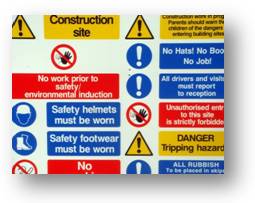 The European Union (EU), for instance, now issues 'directives' (all EU countries must accept these) on working hours (minimum), the lifting of heavy weights, the use of computer screens and the rights of pregnant women.
The European Union (EU), for instance, now issues 'directives' (all EU countries must accept these) on working hours (minimum), the lifting of heavy weights, the use of computer screens and the rights of pregnant women.
Like all laws imposed by any government they involve costs for those applying them. However, many firms will exceed their legal requirements as they want to be seen as a caring and safety conscious organisation. This approach may, as a result, attract higher quality staff.
Employment law
The law relating to employment can be applicable to the individual or collectively to the company. Laws relating to individual rights cover areas such as:
- Equal pay - the right to equal pay for equal work.
- Sex discrimination - the right to a working environment free from sex discrimination.
- Race discrimination - the right to a working environment free from race discrimination.
- Disability discrimination - the right to a working environment free from discrimination on the grounds of disability.
Laws on discrimination concentrate on terms and conditions of employment and equal opportunities when job vacancies are being advertised. In many countries, for example, it would be illegal to advertise only for a man or a woman for a particular post, unless there are unusual circumstances which demand a person of a certain gender. Similarly, laws in some countries would prevent firms only recruiting people of a particular age.
So how successful have countries been at reducing sex discrimination? The World Economic Forum produces an annual report to assess the current size of the gender gap by measuring the extent to which women in 134 countries have achieved equality with men in five critical areas: economic participation, economic opportunity, political empowerment, educational attainment, and health and well-being. Countries that do not capitalize on the full potential of one half of their societies are misallocating their human resources and undermining their competitive potential. So how did the various countries fare? Follow the link below to see the rankings of the various countries.
Top 20 countries - global gender equality
Employment protection
Employment protection concerns all employees. All employees would like to feel that they have some protection from being unfairly treated. One major concern is that their employment is secure. Employers, however, would like greater flexibility to increase or decrease their staffing levels to meet demand and supply conditions. So how can firms change their human resource level?
Firstly, it is important to understand the difference between dismissal (being 'fired') and redundancy.
Dismissal occurs when the employee has acted in manner, which breaches his or her contract of employment or makes it impossible for that person to remain in the organisation. For instance, any assault in the workplace is likely to lead to instant dismissal. Other reasons for dismissal could include incompetence, or a legal restraint which makes the continuing employment impossible. For example, a person who is found guilty of a drink driving offence and banned from driving could not carry on as a lorry driver.
Dismissal does not normally lead to any claims for compensation, unless that dismissal was unfair. Dismissal can be unfair if the firm has not followed its legal responsibilities, especially in the area of incompetence. Employees are generally entitled to a series of oral and written warnings before dismissal, although the number of warnings will vary from country to country.
Redundancy occurs when the job an individual is carrying out is no longer required. This does not mean that the individual has done anything wrong at all. Under these circumstances, the redundant employee is normally entitled to notice of redundancy and some compensation for the loss of employment.
Collective employment laws differ substantially from country to country, but it is worth you knowing some of the detail in your country to provide examples in an examination question. The areas where investigation would be useful are:
- Dismissal procedures - the formality of written and oral warnings prior to dismissal to which staff are generally entitled.
- Notice of redundancy -the length of notice an individual has to be given. After 4 weeks continual employment an employee is often entitled to 1 week's notice and this will increase by perhaps 1 week for every year employed to a maximum of 12 weeks.
- Contracts of employment - all employees are entitled to receive, within a certain time of commencing employment, an official contract of employment.
- Trade union recognition and involvement. It is a right in most countries of any employee to seek membership of a trades union, but they do not have to belong if they do not wish to.
Consumer protection
This area of the law aims to protect consumers from unfair practices relating to product quality and especially financial terms. Legislation will differ significantly between countries, but may include laws which:
- Dictate how goods should perform in relation to the quality and functions described by the producer (goods should be 'fit for purpose').
- Prescribe how quantities should be accurate (weights and measures etc.).
- Cover accurate and truthful description of goods and services offered for sale.
- Relate to the amount of credit that can be given by recognised credit agents.
- Make companies responsible for damage caused by one of their products.
- Control food display and safety. This is an area of law that changes rapidly.
Competition policy
This area of policy is where government keeps a watchful eye on corporate behaviour. It is concerned about possibly abuses of power by firms. These may include:
- monopoly behaviour
- mergers and takeovers
- restrictive practices.
Research shows that competition leads to greater choice, quality and lower prices and so government is charged with monitoring business to make certain it lives up to these expectations. Governments ensure that anti-competitive (anti-trust) practices are prevented.
It is argued by some economists that modern, global capitalism helps control business and makes them act in the interest of consumers, so should be allowed to self-regulate. They are open to greater competition and so must be able to attract custom by offering quality at affordable prices. However, others believe that self-regulation is inadequate to prevent business taking advantage of their power.
Political stability and instability
 Even in countries perceived as politically stable, political change can have a significant impact on business. This may simply be because government changes the legal framework, which as we have seen in the previous section is wide-ranging, but it could also be that a change of government changes the political attitudes towards business. This may result in less 'business-friendly' policies, changes in business taxation and regulations or, perhaps, political changes that affect the firm's marketing.
Even in countries perceived as politically stable, political change can have a significant impact on business. This may simply be because government changes the legal framework, which as we have seen in the previous section is wide-ranging, but it could also be that a change of government changes the political attitudes towards business. This may result in less 'business-friendly' policies, changes in business taxation and regulations or, perhaps, political changes that affect the firm's marketing.
Governments can also change the social agenda and this may impact on firms. For example, a government may introduce, or modify, a minimum wage. Many businesses oppose a minimum wage as they believe it:
- increases costs
- damages flexibility
- reduces international competitiveness, especially against those countries which do not have minimum wage levels.
Governments may also sign up to additional agreements. For example, the European Union governments agreed to improve the terms and conditions of employees in the Social Chapter of the 1992 Maastricht treaty, which sets out broad social policy objectives concerning working conditions, consultation of workers, employment rights, and social security. This gave employees many additional rights including:
- Paternity rights on the birth of a child
- Additional employment protection
- Equal employment status for part-time workers
- Maximum working hours
- Free movement of EU nationals
- Free association in trade unions and collective bargaining
- A minimum working age of 16
- Protection for disabled workers
Changes of this nature will affect firms significantly and may increase their costs. However, additional rights could also result in improved motivation and this may help compensate for higher costs. Businesses will look carefully at all political changes to assess the impact that they will have on them and their competitors.
Political instability
Political instability can have an even greater impact on business and it may make them reluctant to invest in new capital or enter new markets. It may even encourage relocation of activities to a more stable and predictable area as business owners hate risk! Political instability in an area where a firm operates will mean that the firm has to be very flexible and adaptable; ready to change their operations at very short notice to reflect changes in the political environment.
The 2011 unrest in Tunisia is an example. Business ratings agencies such as Fitch consider political stability when advising businesses on investment opportunities.
The social and cultural environment - introduction
Businesses affect the societies in which they operate and are, in turn, affected by social and cultural change in those societies. In this section we look at both these areas. Social change may affect businesses through many aspects of their activity. These may include:
- Human resources - expectations within society about patterns of employment and working conditions will affect the firm's organisation. Increasingly, trends towards home working, more flexible employment patterns and a portfolio approach to a career are influencing firms and the way they operate. Social change impacts on firms in different ways, but all businesses would be wise to plan for change.
- Marketing - firms need to ensure that their product portfolios reflect the pattern of demand in society. Changes in society lead to changes in the pattern of demand and firms need to be aware of changes taking place in their market. Market research will be an important element of judging the significance of trends and changing consumer purchasing behaviour.
- Production - with the growth in multinational enterprises, production has become increasingly globalised and ready to shift anywhere. However, firms are also under increasing pressure to ensure that their production does not impact negatively on the countries and societies where they operate.
Social responsibility
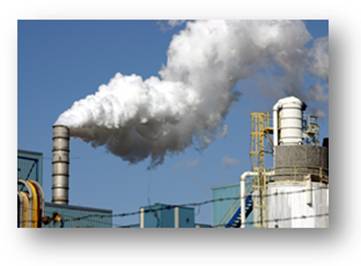 As well as being affected by society, business also has a responsibility to the society in which it operates. Members of society are stakeholders (have an interest in how the business operates) and need to be treated accordingly. Let's look at the range of major stakeholders and think of how a business has a social responsibility towards them.
As well as being affected by society, business also has a responsibility to the society in which it operates. Members of society are stakeholders (have an interest in how the business operates) and need to be treated accordingly. Let's look at the range of major stakeholders and think of how a business has a social responsibility towards them.
- Employees - they look for job security and adequate rates of pay.
- Customers - want to buy with trust and a belief that adequate quality will be a norm. They also assume safety has been a primary objective of the business and that the price they pay is a fair reflection of costs plus a reasonable amount of profit.
- Suppliers - expect some security of orders at a fair price and regular payment of bills.
- Owners - look for dividends, increasing profits and a positive image of the business with the wider public e.g. environmental responsibility.
- Government - hope that business uses resources efficiently and effectively and makes decisions with the best and widest interests of society in mind.
- Local community - again look for jobs within a secure environment and a lack of social costs.
Demographic trends
Population
 A key stakeholder is the local population, but increasingly businesses need to think on a larger, even global scale. They need to look carefully at population changes in the various countries in which they operate as this population acts as both customers and a potential workforce.
A key stakeholder is the local population, but increasingly businesses need to think on a larger, even global scale. They need to look carefully at population changes in the various countries in which they operate as this population acts as both customers and a potential workforce.
Global Population
The world's population is estimated to hit 7 billion by 2013 and 9 billion just before 2050. Excellent population data can be found on the US Census Bureau site. This site also has a summary page for links to general population data information including the world population clock (reload the page after one minute to see the change).
The population changes in India and China are particularly significant, not just to those countries. Together, China and India have over 2.5 billion people, representing more than one third of the world's population. Not only are their populations growing faster than most western countries, but economic growth is far greater as well. The economic demands of the two populations will increase rapidly over the next decade, as well as their consumption of scarce resources such as oil and water. This will influence prices of commodities and the finished goods that use these
Populations are often presented in terms of a pyramid, identifying the structure of a population. The US Census Site also allows you to compare population pyramids at a national level. This can provide valuable background knowledge to support analysis of government and industry behaviours. Many western countries have ageing populations. We will discuss the consequences of this later. Asian countries tend to have younger age profiles:
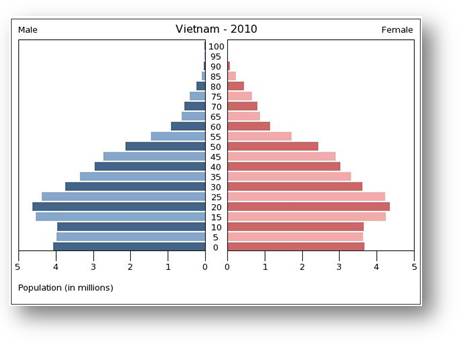

China has a huge, but relatively young population. However, as the population grows and birth rates fall the structure of its population will change. An excellent graphic of these changes over a one hundred year period can be found here. As populations age, their demand patterns change, which impacts on the goods and services produced by firms.
As economies develop, their populations tend to age and then possibly decline as longer life expectancy is offset by falling birth rates. Any growth in the population of developed countries is likely to come from immigration.

Let's think about how population changes might affect business. Have a think about how these population changes might affect business and jot down some notes. Then follow the link below to compare your notes with ours.
What might be the effect on business of changes in population?
Why not use the window below to find equivalent population data for the country where you are and analyse the impact that population changes will have on business in the country?
The technological environment - introduction
 Technological change presents significant opportunities and threats for businesses.
Technological change presents significant opportunities and threats for businesses.
Technology developments affect business operations in a number of positive ways:
- Increasing access to, and storage and manipulation of, data.
- Increasing speed and volume of communication.
- Reduced language and cultural barriers.
- Reduced costs of production.
- Reduced administration costs, waste and increased efficiencies.
- Increased outsourcing of key functions cutting operating costs.
- Higher quality products at competitive prices through improved innovation and development.
- Better working conditions, flexible working practices and greater opportunity for personal development.
- Increasing access to global markets and greater mobility in business transactions.
However, there are some potential negatives associated with technology development
- The real costs of remaining ahead of competitors.
- Fewer barriers to entry to markets, allowing smaller companies to compete using relatively low cost web marketing tools.
- Empowering customers to seek lower prices and better deals.
- The increasing support costs such as licensing of software, maintenance of equipment and the training of staff.
- Reduced job security.
- The pace of constant change undermining existing organisational structures and threatening social relationships.
- The increased risk of interconnected systems failing and resulting chaos. Not all systems are secure and it is increasingly difficult to protect systems from hacking.
The Internet and the World Wide Web (www).
 The terms Internet (or 'Net') and World Wide Web (or 'Web') are often used interchangeably, but in fact are two separate, although related, things.
The terms Internet (or 'Net') and World Wide Web (or 'Web') are often used interchangeably, but in fact are two separate, although related, things.
The term 'Internet' is a shortened version of an 'interconnection of computer networks', a massive network of networks. This is a global structure which combines and links millions of personal, business, and governmental computers, all connected like roads and highways. Any one computer can communicate with any other computer as long as they are both connected to the Internet. The information travelling over the Internet uses a variety of languages known as protocols.
The Web, however, is just one part, or subset, of the Internet. The Web is a way of accessing information over the medium of the Internet using free software called web browsers (which we know well by their brand names - Internet Explorer, Firefox, Opera etc). The Web uses the HTTP protocol to transmit data, which is only one of several languages spoken over the Internet. Browsers allow users (you and me) to access Web pages, or documents, that may contain a range of graphics, sounds, text and video. Web pages themselves are linked to each other via hyperlinks and a Website is a collection of related web pages. All publicly accessible websites collectively constitute the World Wide Web. It was estimated that in 2009, there were approximately 25 billion web pages and 110 million websites, although the exact figures are difficult to verify.
![]()
"The social value of the Web is that it enables human communication, commerce, and opportunities to share knowledge [and] to make these benefits available to all people, whatever their hardware, software, network infrastructure, native language, culture, geographical location, or physical or mental ability."
Sir Tim Berners-Lee, inventor of the World Wide Web
Comparative data on the number of users in different continents and countries can be found here on the Internet World Stats site.
The Internet
The Internet (not the Web) is also used for other purposes, primarily for e-mail. What is important about the Internet - which makes it unique in a commercial sense - is that no one owns it. It is true that governments and organisations can control parts of it, or influence its development, but no one body can easily prevent free access or the dissemination of information and transfer of data. This makes the Internet a potentially liberating and democratising tool. Small firms can use the Internet as freely as large firms. This provides an opportunity for small firms and a potential threat to the larger, more established businesses.
However, access to computers and to the Internet varies considerably between countries and regions, and poor or limited access can be both a weakness and a potential threat, if competitors in other regions are able to use the Internet and the Web more effectively to improve communications and to promote, sell and distribute goods and services. In addition, less democratic states may try to restrict the information available to users within that country.

'Google Shuts China Site in Dispute Over Censorship'
In 2010 Google shut its China site in a dispute over the censorship of its content by the Chinese government. In the short run, Google's action will not have a huge impact as the Chinese market represents a relatively small 2% of its annual $24bn revenue, but it risks losing the huge future revenues as China's Internet market continues to expand.
The void left by Google has been filled effectively by the Chinese search engine Baidu, which is the leading search engine in China and willing to cooperate with government censorship requirements. This illustrates the fact that multinational providers may have problems satisfying local tastes and complying with national laws and regulations.
You can read about Google's decision in the articles:
Commercial firms do not like free access and unregulated information, so try to incentivise individuals to join communities and networks that can be controlled. Meanwhile, more and more of the interesting stuff on the Web is hidden behind a login and password. Examples are social networking sites such as Facebook, MySpace and Flikr. These have millions of users, but present two significant problems. Firstly, information on one site is not usable in the others and secondly, these sites do not allow users much control over how their personal information is disseminated, which results in potential privacy problems.
The whole framework of the Web (and Web marketing) is based around the idea that everything is in a compatible format. Any browser, any computer, any connection, you see pretty much the same thing. A 2010 Business week article suggests a label for the increasing commercialisation of the net - calling it the rise of the "Splinternet". This phrase originated from Josh Bernoff, is a reference to a situation where the common Web browser experience of the past 15 years is shattered into systems of incompatible content formats. Now with iPhones, Androids, Kindles, Tablets, and TVs connecting to the Web, that's not true. Your site may not work correctly on these devices. For example, Apps that work on the iPhone don't work on Google's Android systems. Consumers may have to adapt to a world where gadgets are the new marketing medium.
E-commerce
What is more important than definitions and distinctions, is that both the Internet and the Web are used to promote what is referred to as e-commerce - using networks and electronic devices to support buying and selling, and supporting any communication or transaction between a business, their customers, suppliers and other stakeholders.
The growth of the web has led to the development of retailers which sell exclusively via the Internet, such as Amazon. However, the Web has also provided existing retailers, such as Staples, with an additional distribution channel. In the US, the 500 e-retailers in the Internet Retailer Top 500Guide for 2009 accounted for 93.7% of all web sales. Perhaps more remarkable is that the top 100 of those merchants control 80.7% of all web sales.
While the big players have long been dominant, their dominance is growing. In 2008, the Top 500 accounted for 87.9% and the Top 100, 74.5%. So it appears that established brand identity and economies of scale still provide competitive advantages, even in this new marketplace. Indeed, the big e-retailers are getting bigger.
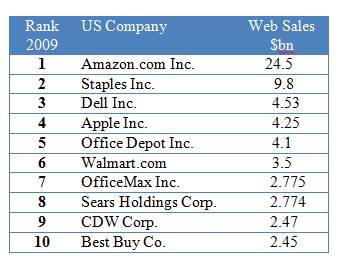
In the next section we look at possible areas where technological change will impact on business.
Technological change
 In this section we are looking at some other areas where technological change has had an impact on business.
In this section we are looking at some other areas where technological change has had an impact on business.
Change
Change tends to affect business in terms of:
- Products
- Materials
- Processes
- Systems
Let's look at each of these in turn.
Products
The application of science and technology means that new products and services are forever entering the market. The possibility of 'first mover advantage' is a strong motivator for many businesses. Much time and money is spent on developing new ways of reducing the period that passes between the first idea and the actual appearance of the product and advantages that correct technical applications can make to product life cycles. All of us are aware of the digital age, the use of mobile forms of communication and medical advances. It is in these areas that many of the new products will appear.

Consider what goods and services may appear next in:
- the mobile phone market
- the entertainment market
Materials
Adapting new, or previously unused materials can reduce costs, improve quality and boost productivity. Genetically modified (GM) foods are foods derived from genetically modified organisms (GMOs). Genetically modified organisms have had specific changes introduced into their DNA by genetic engineering techniques. There is some controversy about the techniques behind this. Critics object to GM foods on several grounds, including safety issues, ecological concerns, and economic concerns raised by the fact that these organisms are subject to intellectual property law.
Suggested future applications GMOs include drugs in food, such as bananas that produce human vaccines against infectious diseases, metabolically engineered fish that mature more quickly, fruit and nut trees that yield years earlier, foods no longer containing properties associated with common intolerances, and plants that produce new plastics with unique properties.
Nanotechnology: The next industrial revolution
However, even more significant than GM technology is the miniaturisation of the materials we use. You are probably more than familiar with the downsizing of technology. Data memory cards for use in cameras, MP3s etc have becoming increasingly small at the same time that their memory capabilities increase. However, these familiar objects are about to be eclipsed by the developments in nanotechnology - by something we cannot see.

I want to build a billion tiny factories, models of each other, which are manufacturing simultaneously. . . The principles of physics, as far as I can see, do not speak against the possibility of manoeuvring things atom by atom. It is not an attempt to violate any laws; it is something, in principle, that can be done; but in practice, it has not been done because we are too big.
Richard Feynman, Nobel Prize winner in physics
 Nanotechnology is the science of building machines at a subatomic level. When K. Eric Drexler popularized the word 'nanotechnology' in the 1980's, he was talking about building machines on the scale of molecules, a few nanometers wide-motors, robot arms, and even whole computers, far smaller than a cell.
Nanotechnology is the science of building machines at a subatomic level. When K. Eric Drexler popularized the word 'nanotechnology' in the 1980's, he was talking about building machines on the scale of molecules, a few nanometers wide-motors, robot arms, and even whole computers, far smaller than a cell.
This new technology offers huge opportunities for business in the creation of machines and processes beyond our imagination a couple of decades ago. Machines that function at a molecular level, medical applications that are astounding and even solutions to climate change with re-engineering of nature. However, you may be surprised to know that nanotechnology is already in everyday products on sale, such as:
- Sunscreens containing nanoparticles of zinc oxide
- Self-cleaning glass in conservatories using nanoparticles to break down and loosen dirt
- Clothing coated with nanoparticles, give better protection from UV radiation. and help repel water and other materials, making the clothing stain-resistant.
- Scratch-resistant coatings on everything from cars to eyeglass lenses
- Tennis racquets - the VS Nanotube Power racket. Is made of carbon nanotube-infused graphite, meaning the racket is very light, yet many times stronger than steel
If you wish to read more, there is an excellent summary of nanotechnology can be found on the 'howstuffworks' site.

A wonderful animation gallery of nanotechnology machinery can be found here.
For a fascinating discussion of the applications of nanotechnology and the huge potential business opportunities, you may like to watch an extract from the BBC's Visions of the Future series with Dr. Michio Kaku discussing Nanotechnology either from the YouTube site or in the window below.
Processes
Technology has been applied to the ways in which products are designed and manufactured.
Computer-aided design (CAD) employs computer technology for the design of real and virtual objects and in the drafting of technical and engineering drawings, in automotive, shipbuilding, and aerospace industries and industrial and architectural design. CAD techniques are also used in the entertainments industry to produce computer animation for special effects.
CAD is an input into:
Computer-aided manufacturing (CAM), which is the use of computer software to control tools and machinery in manufacturing as well as assisting management systems, transportation and storage. The primary purpose of CAM is to speed up the production process while introducing greater precision in cutting and moulding to minimise waste and reduce production costs.
Systems
These too have been radically transformed by technology. In marketing, the Internet is now a major way of reaching both current and potential customers. Communications are virtually instantaneous to anywhere on the globe. Stock control and financial records can be kept electronically, allowing for easier access and faster response to change.
The ecological environment
A key area of corporate social responsibility is the impact that a firm has on the environment and this may attract significant media coverage.
There is a tendency to assume that this impact is mostly negative. However, business may have positive impacts on the local environment and national environment. For example, firms fund improvements in the local infrastructure and provide community facilities. They may improve the environment by taking derelict sites and redeveloping these to provide local amenities.
However, much of the focus on this aspect of the external environment will always be on pollution and other negative effects of production. These are called 'negative externalities'. and include:
- Congestion caused on the use of local services - roads etc.
- Noise - noise is also a form of pollution and many forms of business activity are noisy
- Air and water pollution - a side effect of many production processes is pollution of some form, though there are often options to minimise these side effects.
- Use of non-renewable resources - many processes use fossil fuels or other non-renewable resources. These are by their very nature un-replaceable and so will have a serious impact on future economic activity.
 There are many ways that businesses can reduce the negative effects of their operations and work with stakeholders to promote more environmentally friendlier practices:
There are many ways that businesses can reduce the negative effects of their operations and work with stakeholders to promote more environmentally friendlier practices:
To minimise damage to the environment, businesses consider:
- Reducing emissions
- Producing or using lead free fuels and other 'greener' sources of energy, e.g. renewable resources or energies. It is not uncommon for business developments to include sources of wind and solar energy on site.
- Incorporating cleaner production methods in new buildings, plants etc.
To reduce levels of waste they:
- Improve industry re-cycling programmes
- Encourage energy management schemes
- Offer free long-life shopping bags or other bio-sensitive packaging of products
To try to raise environmental awareness, they:
- Ask staff for ideas
- Promote customer awareness and participation
- Publish literature such as sustainability reports
To help protect the environment, they:
- Donate money for environmental projects that directly affect their stakeholders
- Fund or sponsor education programmes
-
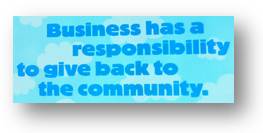 Provide recycling facilities
Provide recycling facilities
To assist the community, they support:
- Tree planting
- Urban re-generation schemes

How many examples of any of these practices can you see in your local area?
The economic environment - introduction
We have already seen that businesses do not operate in a vacuum. They are affected by a range of external factors; with one of the key external factors being the economy. With increasingly global markets, even local firms will now be affected by both the national and international economy. Inflation, unemployment, exchange rates, interest rates and economic growth are all issues that will affect all aspects of business activity.
Changes in government economic policy can have wide-ranging effects on the demand for business products and therefore marketing approaches. Government policy may affect the cost of business inputs - labour, raw materials and capital. As a result, any business that does not keep a careful eye on the external economic environment is vulnerable to reduced sales and profits.
Economic growth

Economic growth
Economic growth is an increase in the productive capacity of an economy measured in terms of the growth in real national income per capita (per head) between one year and another.
Economic growth is normally good news for business. We normally measure it via the real GDP figure - i.e. the Gross Domestic Product adjusted for inflation.
Gross Domestic Product is a measure of the total amount of goods and services produced in an economy over a period produced by the residents of a country. Income from abroad is, therefore, excluded.
Comparisons of country GDP can be found on the CIA World Factbook or viewed in the window below:
The determinants of economic growth in an economy include:
- Access to factors of production and their productive use.
- Application of technology and the rate of technological progress.
- Development of a competitive advantage.
- Creation of a highly skilled workforce.
- Increasing investment levels (the purchase of capital).
- Positive government policies that support business and aid growth.
 Businesses usually experience benefits from economic growth because:
Businesses usually experience benefits from economic growth because:
- It delivers new opportunities.
- There is greater certainty in markets.
- Incomes are increasing (businesses with income elastic products will benefit the most in this situation)
- Demand is increasing
- The size of all markets is increasing
However, there are potential negative consequences of economic growth. These may include:
- Externalities - social costs
- Damage to the environment
- Depletion of resources
- Rising prices (inflation)
- Increasing size and monopoly power of firms creating unfair competition
- Increasing inequalities between rich and poor
Growth is essential to provide higher revenues and profits and to improve the standard of living of the population in general. However, a trade-off has to be accepted and growth at all costs may have serious consequences. A mad rush to high and constant levels of economic growth might result in the exhaustion of resources, environmental damage and most certainly the failure to deliver sustainable growth. It can also lead to risk-taking and deregulation in the pursuit of further growth, which can be disastrous as shown by the recession of 2007 - 2010 considered by many economists to be the worst financial crisis since the Great Depression of the 1930s. This recession has had a dramatic, but disproportionate effect on growth rates around the globe. Those countries exposed to the 'credit crunch', such as Europe and the USA have seen sharp declines in economic growth. Other areas, particularly in Asia have continued to grow strongly.
The BRIC countries
The 'BRIC countries' - Brazil, Russia, India and China - are both the fastest growing and largest emerging market economies. They account for almost three billion people, or just under half of the total population of the world. In recent times, the BRIC have also contributed to the majority of world GDP growth.
According to various projections, it is only a matter of time before China becomes the biggest economy in the world probably between 2030 and 2050. Goldman Sachs believes that by 2050 the BRIC countries will be the most important economies, relegating the US to fifth place. GM recently estimated that BRIC countries will account for more than 35% of the total auto market globally by 2014.
Apart from their growth characteristic the BRIC countries have little in common, but political and economic alliances are beginning to develop and in 2010, the leaders of these countries met in Brazil's capital Brasilia for the second BRIC summit.

The Two Faces of Brazil
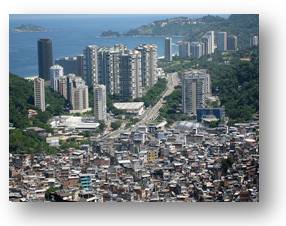 Despite the world recession, Brazil has managed economic growth of almost 5% and is set to overtake both the UK and France to become the world's 5th largest economy up from 10th place in 2006. It was one of the first emerging markets to begin a recovery after the global recession.
Despite the world recession, Brazil has managed economic growth of almost 5% and is set to overtake both the UK and France to become the world's 5th largest economy up from 10th place in 2006. It was one of the first emerging markets to begin a recovery after the global recession.
Brazil will host the 2014 World Cup and the Olympic games in 2016 raising its profile even further as a global power. Brazil's economy outweighs that of all other South American countries and has an expanding presence in world markets. It has the third largest aircraft manufacturing industry in the world and is tackling climate change, with 50% of its cars running on bio-fuels. It is trying to foster an image as the new 'breadbasket of the world'. It exports more meat than any other country and is aiming to be a significant energy producer. With falling unemployment, a buoyant economy, growing confidence, a hugely popular president, fantastic beaches and 6 millionaires created every hour, Brazil looks a perfect place to live.
However, that is just one side of the story; there is a darker side. Brazil is a country with deep inequality - approximately 60 million people are classified as living below the poverty line.
 The most visual representation of poverty in Brazil is the slums, or favelas. Over five hundred favelas can be found within the Rio area housing approximately 2 million people. Here unemployment is high and drug wars common. The favelas sit side by side with trendy opulent areas, magnifying the social divide. According to UNICEF about 42 percent of Brazilian children live in poverty. Approximately one eighth of all Brazilian children live on the streets. There is little sanitation, poor electricity and minimal chance of escape. There are calls for tax, social security, political and labour reforms to address the cycle of poverty.
The most visual representation of poverty in Brazil is the slums, or favelas. Over five hundred favelas can be found within the Rio area housing approximately 2 million people. Here unemployment is high and drug wars common. The favelas sit side by side with trendy opulent areas, magnifying the social divide. According to UNICEF about 42 percent of Brazilian children live in poverty. Approximately one eighth of all Brazilian children live on the streets. There is little sanitation, poor electricity and minimal chance of escape. There are calls for tax, social security, political and labour reforms to address the cycle of poverty.
Comparing Brazil to similar countries in economic terms is instructive. Brazil and Hungary have comparable per capita income, but the incidence of poverty in Brazil is much higher. In Hungary the richest 20% of the population receives about four times more income than the poorest 20%, whereas in Brazil the richest 20% receives 30 times more than the poorest 20%.
This cycle of poverty and the equality gap needs addressing before the Brazilian economy can really be considered a global power
Adapted from: BBC News sources below:

- Will Brazil's economy keep growing?BBC News, (27/5/10)
- Brazil's bid to be 'world's breadbasket'BBC World News America, (26/5/10)
- Tackling Brazil's povertyBBC World News America, (28/5/10)
- Brazil's development spurs economic quality hopesBBC World News America, (27/5/10)
- Brazil's air industry takes offBBC World News America, (24/5/10)
- 'Our growth quality is better than China'BBC World News America, (25/5/10)
- Brazilian economy poised to overtake UK'sBBC News Today, (27/5/10)
Additional Data on Brazil can be found from the following sources:
- Brazil EconomyEconomyWatch
- BrazilCIA World Factbook
- Brazil dataWorld Bank
- Embassy of Brazil Links to latest information on Brazil

Written Report
Using the above resources, write a report of approximately 1000 words on Brazil's economy, covering some of the following issues:
- The growth and structure of the Brazilian economy
- The negative effects of rapid economic growth
- Levels of inequality and poverty
- Policies to reduce inequality
- The future economic prospects of Brazil
- A comparison of Brazil with other South American economies
The Business Cycle

Business Cycle
The business cycle is the periodic, but irregular up-and-down movements in economic activity, measured by fluctuations in real GDP and other macroeconomic variables.
The business cycle is an alternative name for the trade or economic cycle, so these terms are often used interchangeably.
Figure 1 below shows a possible business cycle.
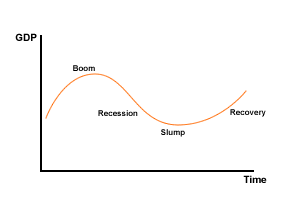
Figure 1 A Business Cycle
Changes in the business cycle seem to be caused by a number of factors, or more realistically, by several of the following happening in the same time period:
- Changes in what is known as business confidence. When a business is confident about the future it is more likely to invest in new capital, such as buildings. When confidence is low, new investment is often postponed, and indeed a firm may sell fixed assets if demand for their products is falling.
- If it appears consumer demand is about to fall, businesses will de-stock and sell what they have without replacing all that is bought by consumers. This means a fall in output. If the business cycle is thought to be moving upwards then business will restock in preparation for increased demand - this increases output.
- Changes in government policies, which are thought to be either causing the economy to expand or contract. A set of policies designed to increase economic growth (e.g. a cut in interest rates) will normally increase business confidence, whilst policies designed to say control inflationary pressures (e.g. increases in taxation or interest rates) will cause business confidence to fall. Following the recent recession, many governments are looking to cut their deficits by reducing spending. This is likely to lead to an economic downturn.
- Changes in consumer behaviour, which are often the result of other macro factors. An increase in interest rates might cause consumer confidence to fall and have an impact on business confidence. A period of high employment might have the opposite effect.
If you would prefer to view this interaction in a new web window, then please follow the link below:
For managers of businesses, the key point to remember about the business cycle is that it has existed for over 150 years, so when an economy looks especially positive, it should be remembered that a recession may follow and the business should prepare for this in the 'good times'. The same should apply to governments. The UK chancellor in 2007 claimed in his last budget before becoming Prime Minister that because of his economic policies, the UK "would never return to the old boom and bust". The deep global recession that soon followed proved that the business cycle is alive and kicking!
The effect and implications of the business cycle
If you would prefer to view this interaction in a new web window, then please follow the link below:

Find the economic growth figures for the country where you live and try to establish what stage of the economic cycle the country is in; then consider the potential consequences for domestic businesses. To find data for your country try starting with the OFFSTATS site. You can browse this site by country and subject e.g. 'France' and 'economic growth'.
With globalisation comes increasing economic interdependence, where the problems in one country may quickly ripple outwards to other regions of the world.

Europe woes herald prolonged recession fears - February 2010
 Just as America's recession began to ebb, trouble was brewing in Europe as the global economy struggled toward a recovery. A rout in stock markets that began in Europe spread to Wall Street on Thursday and around the globe to Asia on Friday, amid fears that Europe may be the world's next financial flashpoint. Pressure has been mounting across the Atlantic as Greece, Portugal and a handful of struggling countries that use the Euro scramble to pay off mountains of debt accumulated from years of profligate spending.
Just as America's recession began to ebb, trouble was brewing in Europe as the global economy struggled toward a recovery. A rout in stock markets that began in Europe spread to Wall Street on Thursday and around the globe to Asia on Friday, amid fears that Europe may be the world's next financial flashpoint. Pressure has been mounting across the Atlantic as Greece, Portugal and a handful of struggling countries that use the Euro scramble to pay off mountains of debt accumulated from years of profligate spending.
The Dow Jones industrial average slid 2.61 percent as American investors grew more uncertain about Europe's economy. Stock markets across Europe slumped as much as 6 percent, and worries that the troubles might push even big European nations like Spain into a financial crisis drove the Euro to $1.37, a seven-month low against the dollar. Asian markets echoed the losses on Friday. The Nikkei in Japan shed 2.9 percent, and the Hang Seng in Hong Kong was also down 2.9 percent in afternoon trading.
Problems in Greece began the panic as the government proposed far-reaching cost-cutting plans to curb a deficit of 12.7 percent of gross domestic product - more than four times the permitted ceiling for countries using the European Union's single currency. That has prompted alarm in markets, and created arguably the biggest challenge for the euro since its inception. The Greek prime minister announced a series of additional austerity measures, including the extension of a broad public sector wage freeze in 2010 and an increase in fuel taxes. He also hinted at raising the retirement age.
The crisis caused by Greece's wayward economic management has posed unprecedented challenges for the 16 countries in the Euro zone. The Euro fell to a six-month low against the dollar last week - before recovering slightly - on fears that a Greek default would undermine other weak members, leading to a domino effect. The markets have been alarmed by the size of deficits in Portugal, Spain and Ireland.
"Greece is in the centre of a speculative game aimed at the euro," the Greek prime minister said in a televised speech. "We are the weak link in the euro zone. We must act immediately and decisively."
Inflation

Inflation
Inflation is a 'persistent (or sustained) increase in the average level of prices'.
 This results in fall in the currency's purchasing power. In other words consumers can buy fewer goods and services with each unit of their currency. It is important not to confuse inflation with an increase in the price of a particular good or service - it is the overall level of all prices that is important.
This results in fall in the currency's purchasing power. In other words consumers can buy fewer goods and services with each unit of their currency. It is important not to confuse inflation with an increase in the price of a particular good or service - it is the overall level of all prices that is important.
Alternatively, if there is a persistent fall in the average level of prices in an economy, this is referred to as 'deflation'. Japan has had a history of struggling with deflation, particularly in the 1990s, and has recently experienced it again.
Changes in inflation are usually measured through the calculation of a Consumer Price Index (CPI) or Retail Price Index (RPI). The CPI measures the movements in prices of a typical 'basket' of goods and services consumed by the 'average' consumer. The changes are weighted to take account of how much income people spend on certain items. When the price of a basket increases, then this means that the average price level has risen. The US Bureau of Labor Statistics publishes a range of information on the US economy including inflation and the weights attached to goods in the average US basket.
Causes of inflation
Inflation has several potential causes, though quite often it is the result of a combination of the following factors.
- Demand led or demand-pull inflation. This is when demand within an economy is greater than the ability of the economy to supply. As such we normally forecast that prices will rise to ration the amount available. High levels of employment, high levels of consumer income and easy access to relatively cheap credit facilities often cause this type of inflation. A simple analogy is an auction; if there are lots of bidders for a particular product - its price will rise.
- Cost inflation (also called cost-push inflation) is caused by increasing costs of manufacturing inputs, such as raw materials, energy and wages forcing companies to increase prices (elasticity permitting) to maintain their profit margins.
- Changes in money supply - this 'monetarist' interpretation of inflation centres on the supply (amount) of money increasing faster than output. In simple terms it is caused by 'too much money chasing too few goods'. This can be made worse if the supply of money increases. This might happen as the result of government printing more money or banks increasing access to credit, such as the process of 'Quantitative Easing'.
- One other possible cause in the mind of some economists is that of expectations. If consumers think that prices will rise in the near future, they buy now before the price rise and so actually cause inflationary pressure as demand increases.
One of the most extreme examples of inflation out of control was that experienced in Zimbabwe. The BBC has produced an excellent question and answer article on hyperinflation in Zimbabwe explaining the underlying factors. By December 2008, inflation in Zimbabwe was estimated at 6.5 quindecillion novemdecillion percent (65 followed by 107 zeros). In April 2009, Zimbabwe abandoned printing of the Zimbabwean dollar, and the South African rand and US dollar became the standard currencies for exchange.
Problems associated with inflation
For some economists, inflation is the root of all economic problems. High inflation may certainly affect business in various negative ways:
- It will impact on sales and cause them to fall as prices increase.
- The national economy will lose part of its international competitiveness and this will reduce earnings from exports - this will particularly affect firms who export a large proportion of their output.
- The increase in prices will put pressure on employees to seek compensatory wage claims.
- Business will feel less secure regarding future planning, such as investment in new factories or machinery.
- The value of investments is destroyed over time.
- It can be economically disastrous for lenders.
- Government control of the economy to restrain inflation, such as increases in interest rates or increases in taxation can restrain economic development of the country and damage business performance.
- High levels of inflation tend to lead to economic stagnation.
When inflation is low:
- Interest rates will be low and that means low costs of borrowing.
- Export prices should be competitive.
- Business is operating against a less uncertain background and can therefore plan with more consistency.
- Costs are lower as prices seldom change.
- Firms have to be competitive, as they can't pass on prices rises as easily as they can when prices are rising.
Inflation performance
To allow inflation comparisons between EU countries, the method of calculating the CPI has been standardised. This is referred to as the Harmonised Index of Consumer Prices (HICP).
The HICP differs from the US CPI by excluding owner-occupied housing from its scope. However, the Bureau of Labor Statistics, the producer of the US CPI, has recently calculated an experimental index designed for direct comparison with the HICP.
An interactive diagram of annual percentage changes in inflation rates in the Euro area (1996 - 2009) can be seen here or can be opened in the window below.
Exchange rates

Exchange Rates
An Exchange Rate is 'the rate at which one nation's currency can be exchanged for that of another.' This is mainly determined by the supply and demand for the currency.
 What creates a demand for a currency? Currency is needed to fund foreign trade or to pay for investments overseas. If Australian customers want to buy goods or services from Japan, they will need to buy Yen first. This will increase the demand for Yen.
What creates a demand for a currency? Currency is needed to fund foreign trade or to pay for investments overseas. If Australian customers want to buy goods or services from Japan, they will need to buy Yen first. This will increase the demand for Yen.
What influences the supply of a currency? Those wanting to buy products from, or invest in, another country will need to buy the currency of that country in order to do this. For example, if US residents want to buy German goods, they will need to buy Euros with their dollars to find the purchase. This will increase the supply of dollars on the foreign exchange markets.
Both demand and supply of currencies may be influenced by Speculation. Speculators buy currencies whose value they expect to increase and sell currencies whose value they expect to decrease. Speculation can have significant effects on the value of a currency. In September 1992, George Soros a Hungarian-American currency speculator, sold US$10 billion of British pounds in a bet against the success of Bank of England's effort to maintain the pound's value. In doing so, he was credited with a major role in forcing a devaluation of the pound that contributed to breaking up the system of fixed exchange rates that governments were trying to put into place in the European Union. Soros earned an estimated US$ 1.1 billion in the process.
What determines an exchange rate?
- Monetary Policy (Interest rates): Capital can flow freely and quickly between countries chasing the highest relative interest rate. To invest in a US bank, a foreigner will have to buy dollars increasing the demand and the value of the dollar.
- Political factors and stabilities of economies.
- Economic Growth: Countries experiencing prolonged recession will find exchange rates weaken. Countries with strong 'export led growth e.g. China and Asia will see their currencies rise - unless they try to maintain lower rates by interfering in the market by selling currency reserves to increase supply. The USA accuses China of this practice causing the major US balance of payments deficit with China.
- Purchasing Power Parity (PPP) theory of exchange rates. This states that in the long run exchange rates are determined by the relative inflation rates in different countries
- International Trade: The desire of overseas customers to buy a country's goods (and services (exports) or the desire of domestic customers to buy foreign goods and services (imports).
- Speculation: Investors buy and sell currencies if they believe they are about to rise or fall in value.
Exchange rate and import and export price changes

Floating Exchange Rate
A floating exchange rate system is where the external value of the currency is allowed to find its own value against other currencies without government interference. The value will be determined by supply and demand in the foreign exchange market (forex market).
A downward adjustment of a currency in a floating exchange rate system is called a depreciation of the currency. An upward adjustment is called an appreciation of the currency. When the exchange rate changes, this also leads to a change in the level of export and import prices.
These can be summarised as:
Appreciation in the exchange rate - export prices rise, import prices fall
Depreciation in the exchange rate - export prices fall, import prices rise.
If you have problem remembering this then simply try a simple example in your head. For example, if the exchange rate between UK sterling and the US dollar is £1=$2, then a £5 export from the UK will sell in the US for $10. If the exchange rate falls to £1=$1 then the export price falls to $5 (though the firm still gets £5). So, depreciation in exchange rate = decrease in export prices. All the rest follows from there.
Inevitably changes in the value of a currency will lead to changes in demand patterns for imports and exports and to the value of any surplus or deficit on the Balance of Payments.
What happens when export prices rise?
Much will depend on the price elasticity of demand for the exported product. If it's inelastic then sales may not drop significantly, whilst if it's price elastic sales will fall and serious decisions will have to be made about pricing policy. Exporting firms may take the decision to lower prices and accept a lower profit margin.
What happens if import prices fall?
This might reduce national prices (i.e. lower inflation), especially if the imports are components of other products (in which case costs have fallen). However, if imports become cheaper, then local equivalents might struggle - especially if price is important in consumer's decisions. Always remember that goods need to be competitive both on price and non-price factors.
So, exchange rates and their fluctuations can influence business. Movements in rates mean:
- Uncertainty and difficulty in planning, such as setting accurate budgets
- Problems in overseas markets
- The need to buy on spot or future markets to reduce the risk of price fluctuations
- Costs of changing catalogues and price lists ('menu costs')
The European Central Bank (ECB) has data on trends in exchange rates between currencies for a range of currencies and a range of time periods. The economic uncertainties in the USA and Euro area between 2007 and 2010 led to some significant fluctuations in exchange rate between the Euro and the US dollar over that period.
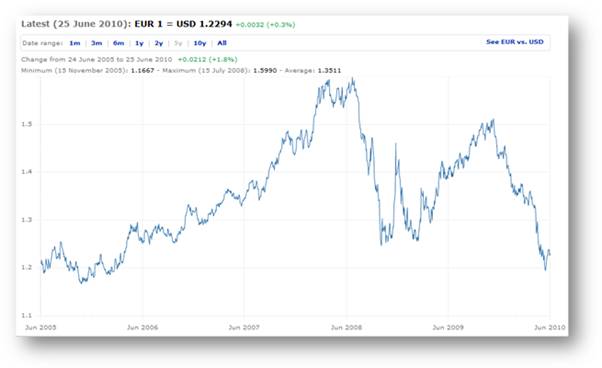
An interactive version of this can be seen in the window below:
A fascinating visual representation of the fluctuations of the Euro against the Dollar, the Pound and the Yen from 2002 to 2010 can be found here
Business often attempt to minimise the effects of exchange rate increases by buying a range of currencies (hedging) or dealing in options, where the firm enters into an agreement to buy products in the future, but at today's prices.

What is the impact of exchange rate fluctuations on firms, especially those involved in exporting and importing?
Unemployment

Unemployment
Unemployment is 'the number of people (of working age) who are willing and available to work at current wage rates, but not currently employed.'
If unemployment is high, then incomes are lower, and demand for goods and services is likely to fall. On the plus side, it may mean there is plenty of labour available and at lower wages, but this is of little use is this if there isn't demand for the goods and services they can produce.
Types of unemployment
If you would prefer to view this interaction in a new web window, then please follow the link below:
Impact of unemployment
Unemployment is bad news for both individuals and business. Those made unemployed normally lose part or all of their income and therefore their ability to spend at the same level. This in turn causes aggregate demand (total expenditure) in the economy to fall. Raw materials and resources fall in price as a result. Workers also see their 'power' reduced and this means that their representatives cannot bargain for such high wage increases.
Faced by a fall in overall demand, producers will seek to cut costs and labour is normally one of those they cut. Investment will also fall and this might be in people and training just as much as machinery. Those firms which suffer the most immediate impact on their performance might be vulnerable to take-over and that too can cause a reduction in the number of employees needed.
Governments will see tax yields fall in time of high unemployment. This may affect their spending plans, negatively affecting demand levels.
Interest rates

Interest Rates
Interest rates are a measure of the price of money. Interest is what is paid when money is borrowed and the return for individuals or organisations lending their funds or parting with their liquidity.
Interest rates can go up or down in response to economic conditions. These changes significantly impact on the operation of a business.
A fall in interest rates
 A fall in interest rates has a range of effects. These include:
A fall in interest rates has a range of effects. These include:
- Making saving less attractive - possibly increasing spending
- The cost of credit falling - making borrowing more attractive to consumers.
- Mortgages becoming cheaper - leaving more disposable income for spending.
- Business short-term debt charges falling - lower interest payments on existing borrowing. Will affect highly geared firms particularly.
- Investment becoming more attractive - projects that were not viable at higher interest rates may become viable now.
- The value of the national currency falling - cheaper exports, more expensive imports.
How might some of these affect a business?
As interest rates fall, so consumers have more money to spend and this causes a rise in sales, especially those made on credit. As business costs fall, so firms have more money to invest or pay in dividends. 'Highly-geared' companies (those with large external loans compared to shareholder equity) will gain as interest charges fall and they too may invest more. As a result, the demand for investment or capital goods will increase.
As interest rates fall, however, there is less incentive for overseas investors to deposit money and those with existing investments may transfer these to other countries with higher rates. The consequence of this is that the demand for a currency will fall and the supply of that currency will increase, leading to a fall in the value of that currency in relation to other currencies. As we discussed earlier the fall in the value of a currency will reduce the price of exports and increase the price of imports. As a consequence, the demand for domestically produced goods should rise abroad and at home, although the extent of this change will depend on how price elastic demand is.
If all, or many, of these changes happen then the economy should expand. As sales increase more people are needed to make the new goods and services and unemployment will fall. However, some skills might be in short supply and wage levels and inflation could increase as a result.

The European Central Bank (ECB) based in Frankfurt sets European interest rates for all Euro countries. How would you expect these interest rate changes to affect businesses in Europe?
Government fiscal policy

Fiscal Policy
Fiscal policy involves the Government changing the levels of taxation and government spending in order to influence Aggregate Demand (AD) and therefore the level of economic activity.
The purpose of Fiscal Policy is:
- to reduce the rate of inflation to the target laid out by the government or central bank (most developed economies set a target for HICP of 2%)
- to stimulate economic growth in a period of a recession.
- to stabilise economic growth, avoiding the 'boom and bust' economic cycle.
Finance ministers use fiscal policy to alter the activity rates of the economy. They budget for either a surplus or deficit in their spending patterns in an attempt to influence economic behaviour.
Expansionary (or reflationary) fiscal policy
This involves increasing aggregate demand (AD) in an economy by:
- increasing government spending and/or,
- reducing direct and/or indirect taxes
The effect is to:
- increase consumers spending because they have more disposable income
- create a government budget deficit or cut a budget surplus
Deflationary (or tight) Fiscal Policy
This involves decreasing aggregate demand in an economy by:
- cutting government spending and/or,
- increasing direct and/or indirect taxes
The effect is to:
- reduce consumer spending
- reduce a budget deficit or create a government surplus
Fine Tuning:
This involves maintaining a steady rate of economic growth through using fiscal policy. However, given the number of economic variables, this is extremely difficult to achieve.
Automatic Fiscal Stabilisers
Governments are aware that there are some fiscal controls that work without government intervention. These are called automatic fiscal stabilisers.
- If the economy is growing, people will automatically pay more taxes (VAT and Income tax) as they earn more and the Government will spend less on unemployment benefits. The increased tax and lower government spending, will act as a check on aggregate demand
- In a recession, the opposite will occur with tax revenue falling but increased government spending on benefits, thus naturally increasing the level of aggregate demand
The Multiplier Effect
An increase in government spending of say $1m will not just increase spending by that amount - there will be a multiplier effect. These are the knock-on effects in spending that will happen as a result of the initial boost.
For example, an increase in spending on health to build new hospitals will benefit construction companies, which will spend more perhaps on investment as well as wages and this will result in further spending, which will further be passed on to other firms.
This is similar to a domino effect, except each successive domino is smaller. For example if the profits of an entrepreneur rise, he or she has two options; to spend the additional profit or save it. Most individuals will choose to save some and spend the rest.
Let's assume that on average the entrepreneur spent 80% of any additional income received. If the entrepreneur earns an additional $1m profit, so spending in the economy will increase by $800,000. Let's say the entrepreneur purchased a yacht. Then the yacht builders will receive an additional $800,000, but will also spend some of this and save the rest. Assume they spent 80% on a new boat yard, so the constructors of this yard will receive $640,000. They the construction company will spend or save etc. So the initial increase in aggregate demand of $1m had led to an additional demand in the economy of:
$1m + $800,000 + $600,000 ...and so on = final increase in aggregate demand.
There is a formula to work out the total extra aggregate demand based on the decisions to spend or save, but it is clear that the initial injection of $1m leads to a greater increase in aggregate demand through the multiplier effect. In the diagram below the multiplier effect is 5, as the initial increase in spending of $1m results in an increase in overall spending in the economy of $5m
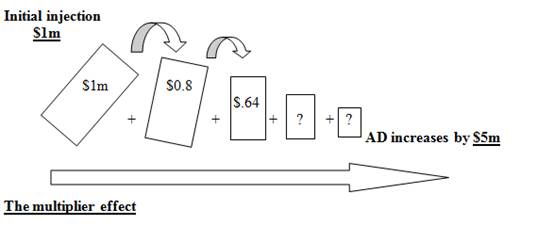

Can you complete the final two boxes?
There are two main types of taxation:
- Direct taxes - these are taxes on income e.g. income tax and corporate taxes. Income tax is a progressive tax - in other words, it takes an increasing proportion of a person's income as their earnings get higher. The aim of this tax is to help redistribute income as well as raise revenue for the government.
- Indirect taxes - these are taxes on expenditure and include sales taxes as well as any 'excise duties' which are taxes on tobacco, alcohol, petrol and so on. These taxes tend to be more regressive in nature - in other words they are more difficult for the less well off to pay as they represent a higher proportion of their income. If VAT is 20% for example, and a rich person and a poorer person buy sofa for $1000, then both purchasers will pay VAT of $200. This obviously represents a higher proportion of the poorer person's income
Fiscal policy changes will affect business significantly and as a Business and Management student you need to be prepared to discuss these changes. Think carefully about issues like:
- Corporate tax changes: Will the changes encourage or discourage investment? Will firms be looking to relocate to take advantage of lower taxes elsewhere? Will the changes leave firms with more or less internal funding for R&D and other product development?
- Direct tax changes: Will people have more or less money to spend and therefore what will happen to demand for the product or service? Have the tax changes affected higher income earners and lower income earners to the same extent? If wealthier consumers are badly affected by tax changes, they may but fewer luxury items. If a business focuses on the luxury market, it is likely to be affected more than those concentrating on staple or necessity good. All of this will depend on the sensitivity of the firm's goods and services to any changes in customer (income elasticity of demand). Also of importance is whether tax changes will influence employee's motivation to work and/or whether the firm will be under pressure to increase wages to maintain disposable income?
- Indirect tax changes: Will the tax changes increase or reduce demand? How price elastic is the demand for goods affected by the tax change? In addition, tax changes may alter the operational costs of a business such as energy charges.
1.5 External environment - questions
In this section are a series of questions on the topic - External environment. The questions may include various types of questions. For example:
- Self-test questions - on-screen questions that give immediate marking and feedback
- Short-answer questions - a series of short-answer questions to help you check your understanding of the topic
- Case study - a case study with associated questions
- In the news - questions based around a topical business news article
Click on the right arrow at the top or bottom of the page to work through the questions.
The social environment - self-test

1 |
Ethical behaviourWhat effect might acting in an ethical way have on a business? |
2 |
Pressure groupsHow might a pressure group encourage corporate responsibility? |
3 |
Social auditingSocial auditing might involve: |
4 |
Environmental auditingWhy might a business carry out an environmental audit? |
5 |
ExternalitiesWhat are 'externalities'? |
The economic environment - self-test

1 |
Trade barriersIn what ways have the reductions in trade barriers boosted international trade? |
2 |
Supply-side policiesWhat is the main aim of the policies known as 'supply-side'? |
3 |
Interest rate riseWhy might an interest rate rise be bad for business? |
4 |
Demand-pull inflationWhich of the following definitions describes demand-led or demand-pull inflation? |
5 |
Short term interest ratesWhy might a business be worried by increases in the short term rates of interest? |
6 |
Changes in exchange ratesIn what way might an increase in the value of the £ affect a UK-based company that exports some of its output? |
7 |
Supply-side policiesHow might supply-side policies help reduce unemployment? |
8 |
Changes in government policyWhy might changes in government policies affect the business cycle? |
9 |
Business cycle - boomWhat is meant by the term boom? |
10 |
Increase in short-term interest ratesWhich of the following would be directly affected by an increase in short term interest rates? |
11 |
GNPWhat is meant by the term Gross National Product? |
12 |
Budget deficitA budget deficit is when |
Technological change - short answer questions

Question 1
Explain the advantages of being first to launch a product.
Question 2
Outline the benefits of CAD and CAM.
Question 3
Outline some of the changes that have arisen in marketing as more technology has been introduced.
Question 4
Analyse how changing technology has affected stock control.
Question 5
Examine the reasons why employees may fear new technology.
Technological change - case study

Is it all good news?
The recent spate of stories in the newspapers of the workload of some who work in call centres has increased concern about the real impact of technology on the working lives of employees.
Pressure is put on employees to answer a certain number of calls per work period, particularly where sales are proportional to calls made. Customers complain of delays, an inability to actually speak to the correct department, which has led to increasing abuse of staff.
Some are questioning the ability of machines within an IT department to appreciate and manage employees in telesales sections. Can a machine actually understand what a human experiences when talking with another?
For an increasing number of potential customers, their first contact with a company is by telephone. The challenges presented by touch-tone systems, automated replies, lists of questions etc are not always appreciated by a possible purchaser. Neither do staff enjoy targets and unknown call monitoring. Perhaps some benefits of technology are less obvious than was first thought?

Question 1
Define a call centre
Question 2
Explain why the personnel employed in such centres are the primary concern of managers.
Question 3
Discuss how customer relations may be improved by the careful use of technology.
Economic growth - short answer questions

Question 1
Identify the possible causes of the business cycle.
Question 2
Outline the main determinants of growth.
Question 3
Examine the disadvantages and problems associated with too much economic growth.
Inflation - short answer questions

Question 1
Identify the main affects on business of increasing rates of inflation.
Question 2
Examine why is monetary policy is only one of the policies used by government to control the economy.
Question 3
Explain the reasons why is inflation considered to be a problem for an economy.
Exchange rates - short answer questions

Question 1
Identify the key factors causing a change in demand for a currency.
Question 2
Explain how firms can minimise the effects of exchange rate fluctuations.
Question 3
Examine how fluctuating exchange rates may cause problems for domestic firms.
Exchange rates - Case Study

Investors embraced the perceived safety of the American dollar as the financial crisis shook the world in 2008. But since March 2009, as stock markets rebounded and investors again rolled the dice in riskier markets, the dollar has suffered, raising questions about whether its status as a go-to currency for trade and investment would fade in the coming years.
Washington officially supports a strong dollar, but a weaker dollar, while raising the prices of imported goods like oil, also helps give American manufacturers an edge in foreign markets by decreasing the relative price of their products. Officials in the Obama White House have done little to curb the dollar's more recent slide.
As budget deficits reached an estimated $1.6 trillion for 2009 and the government printed money to finance its financial rescue programs, other countries and investors started to get nervous. China, which holds the most dollar reserves, raised concerns about rising American debt, and some of its top officials floated proposals that would replace the dollar as the world's reserve currency. Global investors began putting more of their money into Euros. And in October, rumours surfaced that the oil-producing countries would stop pricing oil in dollars, though that speculation was quickly batted down by governments in the Middle East and Russia.
The American economy is still the largest in the world, and with so many trillions of dollars being held by foreign governments, the dollar's dominance in world markets is not likely to fade quickly. Still, worries abound.
Adapted from: New York Times
Oct. 12, 2009

Question 1
Define the term 'exchange rate'.
Question 2
Analyse the effects of a falling dollar on the US economy?
Question 3
Discuss how falls in the value of the US dollar will affect US businesses that trade with the European Union.
Unemployment - short answer questions

Question 1
Identify the main problems caused by unemployment.
Question 2
Examine the ways that unemployment impact on an economy.
Interest rates - short answer questions

Question 1
Explain the effects on an economy of a fall in interest rates.
Question 2
Explain how interest rates influence business.
Apple's iPad goes global
Read the article Apple's iPad goes global (you can do this in the window below or follow the previous link to read the article in a separate window) and then consider answers to the questions below.

You may also like to read some of the following articles to support your answers:

Question 1
Carry out a PEST analysis for the iPad.
Question 2
Analyse the importance of the iPhone to the sales of the iPad
Question 3
Evaluate the potential consequence of the iPad and other e-readers, such as the Kindle on the publishing industry.
Anti-monopoly probe by EU
Read the article Google faces anti-monopoly probe by European Commission (you can do this in the window below or follow the previous link to read the article in a separate window) and then consider answers to the questions below.

Question 1
Identify evidence from the article to support the view that Google is exercising 'monopoly' power in Europe
Question 2
Use the internet to investigate government policies to prevent monopoly practices in the country where you live.
Question 3
Evaluate the advantages and disadvantages to consumers of having a dominant search engine in Europe.
Oiling the wheels of industry?
Read the article Crude oil's rollercoaster prices (you can do this in the window below or follow the previous link to read the article in a separate window) and then consider answers to the questions below.

You may also want to read the articles:

Question 1
Identify the main factors that have contributed to the volatility in oil prices since 2008.
Question 2
Assess whether the rise in oil prices affects a firm's fixed or variable costs or both. Explain your answer fully.
Question 3
Discuss the impact that volatile oil prices are likely to have on firms.
Question 4
Evaluate the impact that rising oil prices are likely to have the national economy of the country where you live.
Japan cuts Interest rates
Read the article BOJ Steps Up Asset Purchases, Lowers Benchmark Interest Rate (you can do this in the window below or follow the previous link to read the article in a separate window) and then consider answers to the questions below.

You may also want to read the articles:

Question 1
Define the following terms:
- Deflation
- Interest rates.
Question 2
Explain how a change in the Japanese interest rates can influence the value of the Yen
Question 3
Evaluate the impact that the change in the Japanese interest rate will have on both Japanese and US businesses.
China relaxes controls on Yuan

Chinese accused of maintaining weak exchange
Chinese imports into the lucrative US market are starting to hurt and that's official. The last independent maker of TV's in the US wants an 84% tariff put on all imports of these mainstream purchases from China and Malaysia. He accuses producers in these two countries of 'dumping' products on the US market.
Once it was Japan and its near neighbour South Korea who frightened US manufacturers. Now their attention has been turned to the new powers in the Far East. The US trade deficit with China is $44 billion and rising.
The 'low' price of the Chinese currency has also attracted the notice of concerned US-based producers. Pressure is now on for the President to demand that the Chinese currency (renminbi) be floated. The drive for protectionism is gaining momentum and tariffs and other barriers are threatened. US textile producers are complaining that imports from China, which became a member of the WTO in 2001, are costing thousands of US jobs.
So, is this a genuine threat to the living standards of those US people working in these industries, or is it simply the domestic economy growing accustomed to the globalisation of trade and the shift of manufacturing capacity to more 'economic' locations? The US companies point to low wages and few labour protection rules in China. As a country, its old political regime can still cause problems, for it allows the industrial sector to launch new products with enormous speed - command economies can still exert pressure on conforming with whatever they want its people to do.
The battle is set to begin and who can guess the outcome?

You may also like to read the article:
(you can do this in the window below or follow the previous link to read the article in a separate window) and then consider answers to the questions below.

Questions
- Define (a) dumping and (b) floating exchange rates
- Examine the reasons why China's decision to relax its control over the yuan should help US producers.
- Discuss the advantages and disadvantages of the USA introducing trade barriers against Chinese goods
Suggested answers
External influences and market structure

Is business simply getting bigger?
British Airways and Iberia sign merger agreement
British Airways and Spanish airline Iberia have signed a deal to merge and create one of the world's biggest airline groups. The airlines first began working together in 1999 following the privatisation of the Spanish flag-carrier. BA and Iberia are expected to complete the merger by December, subject to approval from regulators and shareholders. In a statement, the two companies said the merger would benefit shareholders, employees and customers.
The new company will be called International Airlines Group, but the BA and Iberia brands will continue to operate as normal. The company will have its headquarters in London, with BA shareholders retaining 55% ownership of the company. In total, the group will operate 419 aircraft, flying to more than 200 destinations, and carry a total of 62 million passengers a year.
BA chief executive Willie Walsh said the merger would be good for customers.
"The merged company will provide customers with a larger combined network. This is an important step in the process towards creating one of the world's leading global airlines that will be better equipped to compete with other major airlines and participate in future industry consolidation."
Analysts welcomed the move in light of the current economic environment in which global airlines are struggling. Both BA and Iberia are expected to report heavy losses this year, with BA predicted to announce its biggest annual loss since privatisation. The merger is seen as a chance for the two airlines to cut costs following two very tough years for the airline industry. It is expected to save the airlines 400m Euros a year. The Unite union, which represents thousands of BA workers, said
"Mergers mean synergies, and synergies usually mean job losses and the levelling down of terms and conditions."
The merger will also allow the company to compete more effectively with other European giants including Air France-KLM and Germany's Lufthansa and with US-based United Airlines and Continental Airlines whose recent agreement to merge will create the world's biggest carrier. It is also seen as a stepping stone towards a transatlantic alliance with American Airlines.
The theory
This news story clearly indicates significant consolidation taking place in the airline industry. The nature of the market is an important factor for business as it will be a key determinant of their pricing and other marketing strategies.
External influences - types of markets
Businesses operate in different economic markets. The structure of those markets influences the way in which the business behaves. In the airline industry, for example, a relatively widespread market structure is becoming more concentrated in the hands of a few multinational oligopolies. How will this affect the businesses in that market and those that supply to the airlines?
There are a number of market structures, although some are theoretical. Market structures exist along a continuum from a single firm at one end to many, many firms at the other end.
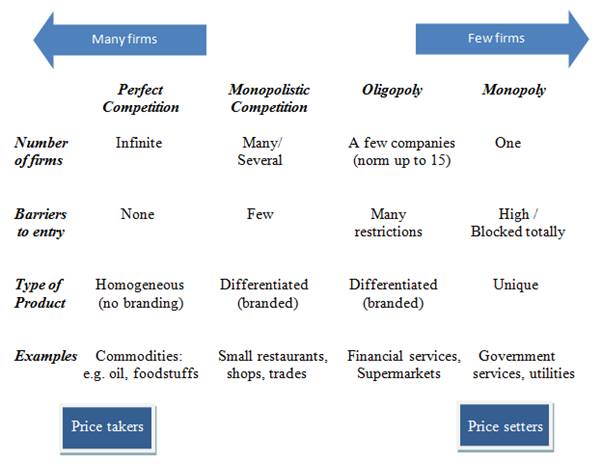
Perfect competition cannot exist in reality as it assumes customers have perfect knowledge of all products and prices. However, there are markets where products are undifferentiated and there are thousands of small firms competing. Examples of these are found mostly in the commodity sector, such as the market for rice, coffee, copper etc. Here the products are unbranded and prices are set in world markets. Individual growers or producers cannot set their own prices, but have to accept the market rate.
At the other end of the market, a pure monopoly exists when there is only one seller. There are examples of true monopolies but these are almost entirely in the public sector where government prohibits competition in sectors it perceives as strategic e.g. utilities, transport and communications. Legally, however, governments start to investigate 'monopoly power' in the private sector when firms have significant market share. Under EU law, a very large market share raises a presumption that a firm is 'dominant'. In a legal case bought by Virgin Atlantic Airways in 1999, British Airways was considered to be overly powerful with a 40% market share on certain routes in Europe. Virgin Airlines argued successfully that this created an 'unfair market'.
The market structure under which a firm operates will determine its behaviour. Firms under perfect competition will behave differently from firms, which are monopolies. This behaviour or conduct will in turn affect the firm's performance, profits, prices and efficiency.
In the case of airline there is an attempt to create global coverage through strategic alliances.
Alliances provide a network of connectivity and convenience for international passengers and international packages. Alliances also provide convenient marketing branding to support passengers making inter-airline connections within countries. This branding even includes unified aircraft liveries among member airlines.
The market is dominated by three leading alliances:

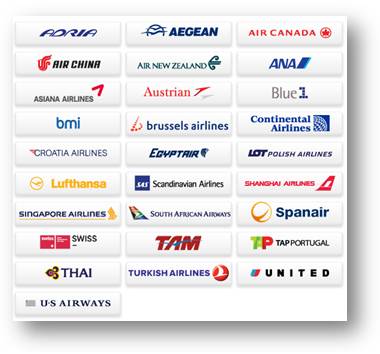

By establishing these joint arrangements the member airlines are trying to create a situation where a passenger requiring a number of flights is always able to connect with a flight offered by another member. Costs may be reduced by sharing facilities and administration, thus allowing for lower prices.
The three largest networks are creating an oligopolistic market structure and are, therefore, restricted by laws and monopoly regulations. Anti-trust (anti-monopoly) actions are always possible when one company is dominant in a market:

Microsoft suffers stunning EU antitrust defeat: Sept 2007

Microsoft suffered a stunning defeat when a European Union court backed a European Commission ruling that the U.S. software giant illegally abused its market power to crush competitors. The court said Microsoft, the world's largest software maker, was unjustified in tying new applications to its Windows operating system in a way that harmed consumer choice. The verdict could force Microsoft to change its business practices.
"Microsoft must now comply fully with its legal obligations to desist from engaging in anti-competitive conduct. The Commission will do its utmost to ensure that Microsoft complies swiftly".
The court upheld a record 497 million euro ($689.9 million) fine imposed on the company as part of the original decision. More importantly, it endorsed Commission sanctions against Microsoft's tying together of software and refusal to give rival makers of office servers information to enable their products to work smoothly with Windows, used by 95 percent of computers.
"The Court upholds the Commission's decision finding that Microsoft abused its dominant position. Microsoft has not demonstrated the existence of objective justification for the bundling, and ... the remedy imposed by the Commission is proportionate," the court statement said.
The Commission ordered the company to sell a version of Windows without the Windows Media Player application used for video and music, which few have bought, and to share information allowing rivals' office servers to work smoothly with Windows. The Commission fined Microsoft a further 280.5 million Euros for not complying with the earlier judgment.
The company has weathered a series of defeats in antitrust cases in the last decade and sees legal setbacks as almost part of its business model and a price for its near-monopoly.
1.5 External environment - simulations and activities
In this section are a series of simulations and activities on the topic of the external environment.
TryIT - The external environment for Maze Green Yachts
 Now that you have considered the way in which the external environment affects businesses, you may like to see how effectively you can take account of it while trying to run a major yacht manufacturer.
Now that you have considered the way in which the external environment affects businesses, you may like to see how effectively you can take account of it while trying to run a major yacht manufacturer.
In the window below is the Maze Green Yachts online business simulation. In this, you get to see how well you can run a major international yacht manufacturer.
To test how well you can manage the company with changes taking place in the external environment, go to the Maze Green business simulation (you can either do this in the window below or you can open it in a separate window by following the previous link).
In the simulation the firm will be affected by changes in both the national and international economy. Try running the simulation for a few quarters to assess how Maze Green are affected by the external environment and then consider the following questions.

Question 1
Identify three changes in the economy that would lead to an increase in demand for yachts.
Question 2
A government budget is approaching. Suggest changes in government policy for which Maze Green Yachts are likely to be lobbying.
Question 3
Maze Green Yachts are considering publishing a Corporate Social Responsibility Report for their stakeholders. Discuss the areas that they should consider in this report.
Question 4
Analyse the impact that a reduction in interest rates is likely to have on Maze Green Yachts.
Question 5
Discuss the impact on Maze Green Yachts of a competitor making a major technological breakthrough in the materials used to manufacture yachts. What policies could they adopt to minimise the effect of this?
1.6 Organisational planning tools - notes
So far we have examined the nature of business activity, types of organisations and objectives and investigated the nature of stakeholders. We have also considered the impact of the external environment on the firm in terms of the opportunities and threats it provides.
We now move on to consider the tools that are available to a business to help them plan their strategic approach.

By the end of this section you should be able to:
- Analyse the importance of the information in a business plan to different stakeholders
- Apply a formal decision making framework to a given situation
- Prepare a SWOT analysis for a given situation and use this to analyse an organisations position

- Analyse and interpret business plans
- Apply decision making processes and planning tools and evaluate their value
- Compare and contrast scientific and intuitive decision making processes
- Construct and interpret decision trees and evaluate their value as a decision making tool
Organisational planning tools
Planning is a vital element of business activity and needs to be done over various timeframes. To help a business in their planning there are a number of tools available. Skilled craftsmen know that they need the correct tool for particular tasks. When faced with a complicated project, they will use a number of tools together. Business tools are very similar. Although it is possible to use individual tools at a tactical level, it is the combination of tools and the information provided by their use that is the basis of effective management.
Planning is at the core of business success. Strategic planning is concerned with the direction of the business and the setting of goals, targets and corporate objectives. The business plan sets how in detail how the business will achieve its corporate objectives.
Business plan
 When starting a business, a business needs a business plan as it will almost certainly need a bank loan, and the first thing that the manager will want to see is the formal business plan.
When starting a business, a business needs a business plan as it will almost certainly need a bank loan, and the first thing that the manager will want to see is the formal business plan.
The business plan sets out in logical order what a firm proposes to do, how it proposes to do it, how much it will cost, what it will bring in etc. It will contain forecast accounts and cash flow. It should be supported by research data where appropriate.
A business plan:
- States the owners' objectives and how they want to achieve these.
- Reminds all employees of the purpose of the business; where it is going, its mission and values and its key corporate objectives.
- Informs lenders and potential investors about the central aims of the business.
- Identifies the products and/or services it intends to sell and identifies any unique selling point.
- Lists key personnel with details of their experience and skills.
- Provides information on the markets in which the business will operate, including sales projections, target markets and identified competitors.
- Provides forecasts of expected profits and cash flow projections and examines the time period in which the business will break even and move into profit.
- Outlines a marketing mix, with pricing strategies, marketing and promotional plans and designated distribution channels, including location details.
The planning process:
The business plan in itself is not as important as the process behind its development. As the computer industry says - 'garbage in, garbage out'. In other words it is the accuracy of the research and the forecasts that is paramount, which is determined by the quality of the market analysis that takes place before the Business Plan is written.
It is also important that the Business Plan is kept current with periodic reviews of strategic and tactical objectives and the updating of key accounts and forecasts.
Decision-making processes - introduction
Managing a business successfully involves effective decision-making. Decision-making lies at the heart of good management. Decisions can be based on:
- Scientific data or facts.
- Experience
- Intuition or 'gut feeling'
Clearly, most decisions are likely to combine aspects of all three factors. A very experienced manager may make faster, but effective decisions based on knowledge, acquired from previous and successful business actions. Less experienced managers may feel more secure if they gather more data to support a chosen course of action.
It must always be remembered that the business environment is dynamic and complex and a previously successful decision may not prove so successful at a later time. Managers must regularly review their decisions in the light of events and make new judgments if evidence suggests they should.
Decision-making processes
A decision-making framework
If you would prefer to view this interaction in a new web window, then please follow the link below:

The decision-making framework can be an excellent revision tool. Every aspect of the Business and Management course can be placed somewhere on this diagram!
Bill Gates, founder of Microsoft is a keen supporter of scientific approaches to decision making. It is not unexpected that he believes that new technologies - and Microsoft software - should be used to underpin this approach!
However, some management writers, such as Henry Mintzberg and Tom Peters, argue that over emphasis on scientific approaches and repetitive planning processes can lead firms into fixed patterns and inflexible structures. This can be dangerous in high technology industries or those subject to continuous change. Mintzberg's recent work focused on how decision makers respond to significant changes in the external environment.
Experience
The scientific decision-making model is not required for all decisions. Many decisions are simple and/or routine and do not require any detailed analysis. Managers may decide to rely on their experience of similar situations. This is likely to be the case in 'programmed' or routine decisions, which have been made many times before, such as ordering supplies like paper or raw materials.
It is possible that this is a good approach to adopt, as it does not use up unnecessary time. However, it may be that a more scientific approach to even routine decisions like these may lead to cost savings if, for instance, cheaper suppliers can be found, or alternative products sourced.
Intuition or 'gut feeling'
 It may be that decisions about selling original or innovative products or services cannot be based on past experience or previous data as this does not exist. Entrepreneurs are often risk takers and are prepared to 'go into the unknown'.
It may be that decisions about selling original or innovative products or services cannot be based on past experience or previous data as this does not exist. Entrepreneurs are often risk takers and are prepared to 'go into the unknown'.
Other managers are so confident in their own abilities that they will act on their own feelings about what is 'right', based upon the patterns they see and their knowledge of the markets. Certainly this approach is quicker and less expensive than scientific approaches, although the risks of failure may be higher as a result.
Decision-making techniques
There are a number of techniques that may help managers make more effective decisions. These include:
- Decision trees (probability diagrams)
- The Five Whys
- The Cause and Effect diagram (Fishbone diagram)
We go on to look in more detail at these on the next few pages.
Decision-making - fishbone diagram

Fishbone diagram
If you would prefer to view this interaction in a new web window, then please follow the link below:
5 Whys technique
This is a technique that can be used to support the fishbone diagram and establish some of the underlying problems that may not be immediately obvious. This simply consists of asking a series of questions to establish the root cause of a problem or issue. It doesn't always have to be five whys, but it is considered that asking why five times should usually be enough to get to the root cause. For more detail and an example of the technique at work, why not have a look at the Wikipedia 5 Whys page.

A worked example:
An employee with a poor attendance record is asked the following questions:
- Why did have you been away for the last three Fridays?
Because I was feeling stressed and this made me feel sick
- Why were you feeling stressed?
Because I had three projects to finish by the end of the month.
- Why did you have three projects to complete by the end of the month?
Because I did not have the skills to prepare some of the graphs required.
- Why did you not have the skills to prepare some of the graphs required?
Because both the training days I had signed up for were cancelled.
- Why were both the training days you signed up for cancelled?
Because the budget for training had been cut by 30% and these courses were expensive.
So it appears from further questioning using the 5 Whys technique that the absenteeism was being caused by poor training.
Solution: The manager of the department arranged for internal training from two employees in another department who had the appropriate skills and had been on earlier sessions of the cancelled training courses. They created a process to allow collaboration on future projects.

Further detail - Ishikawa diagram
For some more detail on the fishbone or Ishikawa diagram, why not have a look at:
- Wikipedia - Ishikawa/fishbone diagram
- Mindtools.com - cause and effect diagrams
Why not try and develop your own fishbone diagram in the window below, or follow the previous link to open the diagram in a new window.
This is really a very straightforward template, which would be ideal as preparation for the Case Study paper. The key factors from the Case Study can be grouped and placed on the fishbone template and used to support your analysis and evaluation.

Decision trees

Decision trees are a special type of decision-making aid. You must be systematic and disciplined when preparing one. The main benefits come from the preparation process, rather than the tree diagram itself. The tree acts as a summary of all that you have done. You have to think logically and clearly, and be willing to hunt for information and data.
Decision trees are an aid to decision making. They are a diagrammatical way of presenting options and probabilities. They reflect the situation that firms frequently have to make decisions in circumstances of doubt and uncertainties. Sales depend on the state of the economy, as well as many other things. Economies change, not always predictably, so here is another source of error. This is what leads us to decision trees. These allow for this source of uncertainty.
Constructing a decision tree
A construction tree is constructed working from left to right, but all calculations are made from right to left.
A decision tree consists of:
- Squares: These are decisions points
- Circles: These are chance of probability nodes
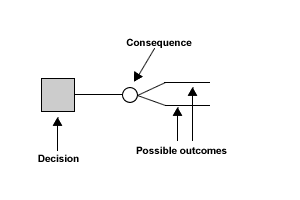
Figure 1 Decision tree - key
The lines that come out of the squares or decision points represent the available options to the decision maker. In the example shown below these are the Project A, Project B and do nothing. The choices are decided by the decision-maker, i.e. they are controllable.
The lines that come out of the circles or chance nodes represent the various outcomes. These outcomes may be uncontrollable by the decision-maker, such as success of failure. The result may be influenced by external factors, such as the reaction of competitors.
Imagine a situation where a firm has to choose between two projects A and B. There is of course a further option; do nothing or stay as you are. Remember, there is always the alternative of doing nothing. This is illustrated below.
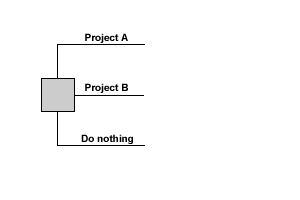
Figure 2 Decision tree choices
Now, the gains from the projects will vary, depending on how successful the marketing is. It is considered it could be very good, average or poor. This set of consequences can be added to the decision diagram to give the outline decision tree.
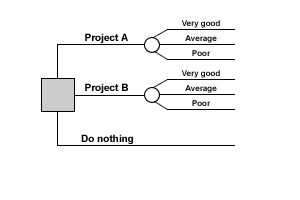
Figure 3 Outline decision tree
Data has to be collected now - data on possible costs, returns and probabilities. Assume that these are collected and have been added to the outline decision tree. The figures in brackets indicate a cost; all others are incomes or revenues.
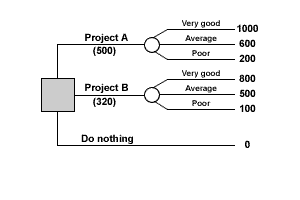
Figure 4 Decision tree with costs and returns
It is now necessary to work out the expected value, or weighted average return for each option. Examine the diagram above.
Project A has three possible outcomes. The outcome has a probability of success and this is expressed as a percentage chance. Let's say that we estimated that 'very good gains' has a 30% chance of being the outcome, 'average gains' a 50% chance and 'poor gains' a 20% chance. The value of all the probabilities must add up to 100% if expressed as a percentage and 1.0, if expressed as decimal (in other words, one of the possibilities must happen). If you multiply the possible outcomes by their probabilities and add them together, then you get the expected value.
| Outcome | x | Probability | = | Expected Value | |
| Very good marketing | 1000 | x | 0.3 | = | 300 |
| Average marketing | 600 | x | 0.5 | = | 300 |
| Poor marketing | 200 | x | 0.2 | = | 40 |
| Total | 640 |
However, there are costs associated with the each project. Project A costs 500, so the net Expected Value is 140 (640-500).
If you conduct calculations for all opions you have prepared an evaluated decision tree. The full decision tree is shown in figure 5 below.
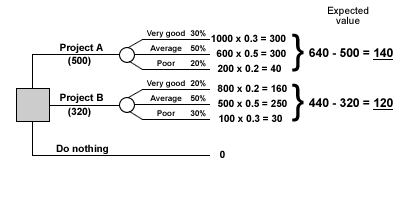
Figure 5 A full decision tree with probabilities and expected returns
What does the completed diagram show?
To complete the diagram, the decision-maker will reject options on purely financial grounds and reject the options with the lower financial returns. In this example, the expected values of Project A is 140 and for project B is 120. Both are positive so taking one of these options is better than doing nothing which returns no gain at all. However, project A returns the greater expected outcome, so this would be the choice based on net expected value.
The decision maker shows the two rejected options by drawing two parallel lines through the rejected options. The completed diagram is shown below:
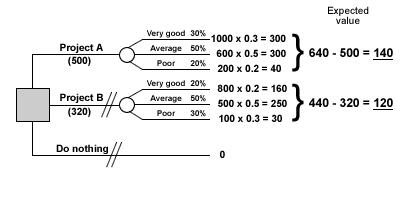
Figure 6 A full decision tree with probabilities, expected returns and rejected options
The expected returns for Project A and project B are quite similar. At this point the decision maker will consider other financial and non-financial factors, such as:
- Training costs
- Maintenance
- Motivation
- Competitor behaviour
- Long-term flexibility
- Business objectives
- Mission and vision statements
- Stakeholder views
Once the non-financial factors are considered as well a choice is made. Even when there is a difference in the level of financial returns, the cheapest option may not necessarily be the best if non-financial factors do not support the financial outcome.
It is good practice to place a key on your finished diagram:
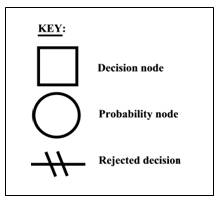
Decision trees have many advantages and disadvantages
Advantages of using decision trees
- Constructing a decision tree may reveal alternative courses of action that had not previously been identified or thought of.
- It formalises the decision making process and makes the process more objective and logical.
- It offers a visual presentation of the options.
- The requirement of numerical values makes results of decision-making better.
- The Management is forced to consider risk.
Disadvantages of decision trees
- Probabilities will usually have to be estimated, and might, themselves, be subject to variability.
- Not all factors or decisions can be given numerical values.
- The results are purely quantitative and ignore more important qualitative factors.
- Data may be out of date when a decision is actually taken.
- The process can be time consuming and expensive. It may not be worth it.
- Expected values are weighted averages of outcomes and are unlikely to relate to the actual outcome.
- Possible options may be overlooked.

Decision trees - worked example

This section is a worked example, which may help sort out the methods of drawing and evaluating decision trees.
The Property Company
A property owner is faced with a choice of:
(a) A large-scale investment (A) to improve her flats. This could produce a substantial pay-off in terms of increased revenue net of costs but will require an investment of £1,400,000. After extensive market research it is considered that there is a 40% chance that a pay-off of £2,500,000 will be obtained, but there is a 60% chance that it will be only £800,000.
(b) A smaller scale project (B) to re-decorate her premises. At £500,000 this is less costly but will produce a lower pay-off. Research data suggests a 30% chance of a gain of £1,000,000 but a 70% chance of it being only £500,000.
(c) Continuing the present operation without change (C). It will cost nothing, but neither will it produce any pay-off. Clients will be unhappy and it will become harder and harder to rent the flats out when they become free.
How will a decision tree help the taking of the decision?
Process:
- Draw the decision tree representing the options open to the property owner.
The tree starts with a decision point, a node, so start the tree with a square.
Three lines radiate from this, representing the three options. Label them carefully.
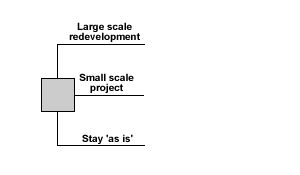
Figure 1 Decision options
- Add the chance nodes, the probabilities and the outcomes.
The options end with possible outcomes, so mark with a circle. In this case there are two possible outcomes for the investment options, and only one for the 'as is' option. Add all the data to this diagram.
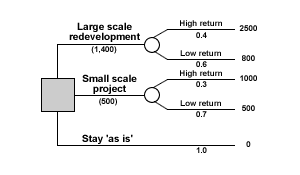
Figure 2 Decision tree with options and probabilities
- Calculate the expected values
Now start to calculate, starting from the right. Multiply the outcomes by the relevant probability, and then add the answers together for each option. Put answer above the appropriate circle.
Tree diagram now looks like figure 3 below:
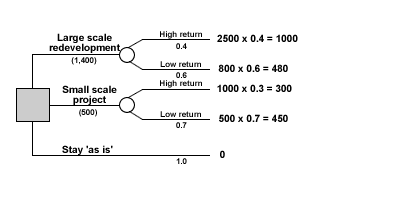
Figure 3 Decision tree diagram with outcomes and returns
- Calculate the net expected value
The final stage is to adjust for the costs of the options. Now subtract the costs of each option from the expected value, and mark the calculation on the diagram. Reject the options with the lowest net expected value.
The final tree diagram is shown below.

Figure 4 Completed decision tree diagram
Use of decision tree diagram
So, now advise the owner what to do. What would your be? Jot down some ideas and then follow the link below to compare your notes with ours.
Decision tree - advice
More than one decision - a more complex decision tree
The decision trees shown to date have only one decision point. It is possible that questions asked in examinations have more than one decision. The way to look at these questions is to imagine each decision point as of a separate decision tree
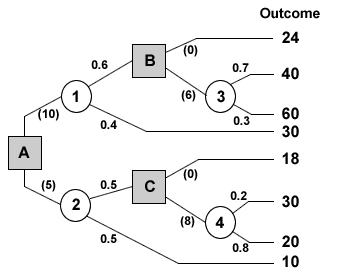
In the diagram above, treat the section of the tree following each decision point as a separate mini decision tree. In this case there are three distinct diagrams with decision points A, B and C as the three starting points. The net expected value at the decision point B and C then become the outcomes of choice nodes 1 and 2.

- Using the decision shown above, calculate which option should be selected on purely financial grounds. Show all your calculations to support your answer.
- Analyse the advantages and disadvantages of using decision trees.

In more complex decision trees it is better to calculate the expected values away from the diagram and add just the result to the diagram.
Node:
1.
0.6 x 40 = 24
0.4 x 30 = 12
Total: 36
2.
0.5 x 18 = 9
0.5 x 10 = 5
Total: 14
3.
0.7 x 40 = 28
0.3 x 60 = 18
Total: 46
4.
0.2 x 30 = 6
0.8 x 20 = 16
Total: 22

SWOT analysis
A SWOT analysis is an INTERNAL audit of where the business is at the present and how it is affected by its EXTERNALenvironment:
STRENGTHS - what the firm does well and its advantages e.g. experience
WEAKNESSES - what the firm does not do well e.g. customer service
OPPORTUNITIES - changes in external conditions, which will allow the firm to develop markets, sell more, expand and make more profits
THREATS - External factors which may stop the firm achieving its aims - CONSTRAINTS and barriers
These are summarised in the diagram below:
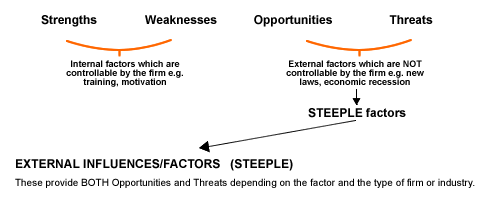
As seen from the diagram, SWOT analysis should be combined with STEEPLE Analysis, which will provide details of the external environment.
Why use SWOT analysis?
A SWOT analysis can support effective strategic planning based on an examination of the firm's capabilities and its external environment. A SWOT analysis is a business tool which allows the assessment of a product, division or organisation in terms of its strengths, weaknesses, opportunities and threats. Its simple four box format makes it a useful visual tool to assist the planning process. The strengths and weaknesses are summary of the present position of the product, decision or organisation, whereas the opportunities and threats represent the future potential or concerns of the business.

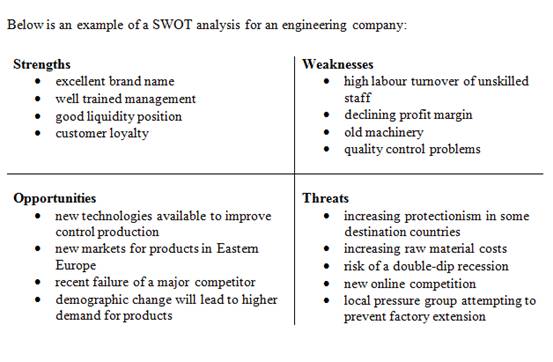
SWOT analysis has many uses and purposes.
- It gives a good picture of the firm's actual position in the marketplace
- It is a good training tool for staff and may help create a team environment.
- It helps develop a better understanding of the firm's service level, product range and brands
- It forces the firm to examine its business and consider the present and future competition.
- It examines external influences and future changes
- It encourages an assessment of strategic opportunities, such as expansion or relocation
There are links between:
- Strengths and Opportunities, and
- Weaknesses and Threats.
For example, a firm that has a well trained and loyal workforce (strengths) will be in a good position to adapt to changes in the markets (opportunities) and to produce products and services to meet new customer needs. So firms should seek to build on their strengths to put them in a position to take advantage of new opportunities when they arise.
However, a firm which has an unmotivated workforce and poor quality services (weaknesses) may not be in a good position to compete with new suppliers in the market place (threats). The firm should seek to reduce its weaknesses to address growing threats.

- Like any business tool it is only as good as the people preparing and using it, and will need to be used in conjunction with other tools. It requires honesty by all involved, especially to admit the organisation's weaknesses.
- SWOT analysis should NOT be used to assess a strategy. You cannot have an opportunity or threat of a strategy.
1.6 Growth and evolution - notes
So far we have examined the nature of business activity, types of organisations and objectives and investigated the nature of stakeholders. We have also considered the impact of the external environment on the firm in terms of the opportunities and threats it provides and prepared and evaluated a range of decision making tools.
One of the main aims of a firm is to grow. To assist this process, firms use a range of techniques including those examined in earlier sections - planning, setting strategic and corporate objectives and SWOT and PEST analysis. In this section we move on to look at the impact of this growth and ways in which it can be achieved. We also consider the driving and restraining forces for growth and evolution of different businesses.

By the end of this section you should be able to:
- Apply the concepts of economies and diseconomies of scale to business decisions
- Evaluate the relative merits of small and large scale organisations and recommend an appropriate scale of operation for a given situation
- Explain the differences between internal and external growth
- Evaluate joint venture, strategic alliances, mergers and takeovers as methods of achieving growth
- Analyse the advantages and disadvantages of a franchise for both franchisor and franchisee and evaluate the use of franchising as a growth strategy

- Explain the value of the Ansoff matrix as a decision making tool and apply the tool to a given situation
- Evaluate internal and external growth strategies as methods of business expansion
- Examine how Porter's generic strategies may provide a framework for building competitive advantage
Economies and diseconomies of scale
The level of efficiency of a firm depends on people as well as the equipment used. There is an optimum level of output for a factory where average costs are minimised. We will examine how this optimum cost depends on the scale or size of the factory and on its management style.
Most firms start as small businesses, sometimes owned and operated by a single person. If they are successful they grow and may eventually become very large. Some even expand beyond their home country and become multi-national. Why is it, that entrepreneurs and organisations, seek growth as a major objective?
Growth brings both advantages and disadvantages to a business. These interact, and depending on the nature of the business and the way it is managed, decide the optimum or most efficient size for the business.
This is the area of economies and diseconomies of scale.

Economies of scale
Those factors which determine that as a business becomes bigger it becomes more efficient. In other words, those factors that cause the average cost of the product or service (unit cost) produced to fall as the scale of operation increases.

Diseconomies of scale
Those factors which determine that as a business becomes larger it becomes less efficient. In other words, those factors that cause the average cost of the product or service produced (unit cost) to rise as the scale of operation increases.
Figure 1 illustrates that average cost falls as output increases, with the result that large firms may enjoy lower costs that smaller competitors. This competitive cost advantage allows large firms to have larger profit margins and have more options in pricing policy.
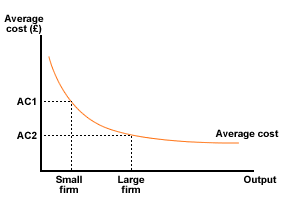
Figure 1: The effect of economies of scale on average cost
Figure 2 illustrates that economies and diseconomies of scale both affect a business from the first expansion. However, as the firm grows the effects of the economies of scale tend to decrease, but the effects of the diseconomies of scale increase as inefficiencies begin to appear. There is an optimal size for a firm, where average costs are at their minimum.
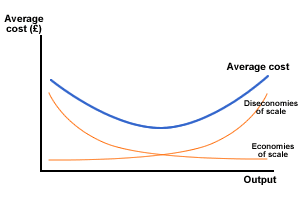
Figure 2: The effect of economies and diseconomies of scale on average cost
Types of economy of scale
Internal economies of scale
If you would prefer to view this interaction in a new web window, then please follow the link below:
External Economies of Scale
If you would prefer to view this interaction in a new web window, then please follow the link below:
What are the major diseconomies of scale?
If you would prefer to view this interaction in a new web window, then please follow the link below:

1 |
Economies of scaleMatch the following examples of economies of scale with their classification. |
Internal and external economies and diseconomies of scale
External economies of scale are those that benefit the industry as a whole, especially as the industry grows. An example would be the concentration of industry, and the availability of specialised training, supply and maintenance services.
External diseconomies occur when this concentration becomes excessive. Everything is then in short supply. To check your understanding try the following two questions:

Question 1
Why are some industries, such as the automobile and aircraft industries, and the petrochemical industry, dominated by a few large companies but others, like the local retail outlets, operated by a large number of small firms?
Have a think about the answer to this and jot down some notes and then follow the link below to compare your notes with ours.
Question 1 - answer
Question 2
Why, even within the petrochemical industry, are all firms not of the same size?
Question 2 - answer
Economies and diseconomies of scale - examples

Multiple retailers and small grocers
Multiple retailers such as Wal-Mart, Tesco, Sogo and Carrefour exploit economies of scale as much as they can. They maximise the benefits of bulk buying as they purchase huge quantities of materials from suppliers. They become the major customers even for the largest of manufacturers such a Heinz. They also get the advantages of the economic employment of specialist staff, power with the banks, and, as major employers of staff, influence within the local authorities. Prices are low to the customer, profits reasonable to the shareholders. Some stakeholders may suffer, e.g. the small supplier, particularly of agricultural products may be forced to offer lower and lower prices to maintain their supply contracts.
What can the small suppliers do? One solution is to develop power by themselves by merging with other suppliers of by forming voluntary groups or cooperatives to become larger units and gain their own economies of scale.
Small versus Large Organisations
It can be difficult to define the term 'small organisation' and the classification will be different from country to country. It is likely that the measure will include:
- Sales turnover
- Number of employees
- Market share
- Privately owned
A small organisation, therefore, is a business that is privately owned and operated, with a small number of employees and relatively low volume of sales. It is likely to have fewer than 500 employees.
In the United States the Small Business Administration classifies a small business as having fewer than 500 employees for manufacturing businesses and less than $7 million in annual receipts for most non-manufacturing businesses. In the European Union, a small business has fewer than 50 employees. However, in Australia, a small firm is defined as having fewer than 15 employees. A business of less than 10 employees can be defined as a 'microbusiness'.
Often small businesses get subsumed into the category of small and medium sized enterprises (SMEs).
There are many reasons why small organizations survive and prosper. A small organisation:
- can be started at a very low cost, carried out with minimum investment and potentially run on a part-time basis. Small business grants, financial aid and economic support is readily available as governments like to promote small business developments.
- can be from the home with low overheads, meaning they can be competitive on price despite their lack of scale.
- can be entrepreneurial and the owner is usually highly motivated by the independence provided .
- can manage their assets and liabilities and cash transactions relatively easily and the owner can setup an accounting system on a home PC using off the shelf software.
- tends to be intimate with its customers and clients, which results in greater accountability and maturity. The business can provide exclusivity in their products and services and meet niche market needs which are uneconomic for big companies as they need to standardise their products and services to gain economies of scale.
- is suited to internet marketing because it can easily serve specialized niches, something that would have been more difficult prior to the internet revolution.
- not being tied to any bureaucratic inertia, it is typically more flexible in its response to change in the marketplace.
Small businesses, however, often face a variety of problems related to their size. Drawbacks for small organisations include:
- working on a low budget and therefore requiring very competent marketing and the planning to achieve strategic objectives.
- the improper handling of loans and poor liquidity ratios.
- frequent underfunding, which is a common cause of bankruptcy.
- higher costs than large firms such as higher interest rates, insurance costs and tax rates.
- concern about excessive government bureaucracy and regulation.
- lack of trust from customers who have not heard of them and would prefer to rely on well know corporations and brands.
- the 'Entrepreneurial Myth' based on an assumption that an expert in a given technical field will also be expert at running a business. Additional business management skills are needed to keep a business running smoothly.
- the capacity of much larger businesses to influence or sometimes determine their chances for success.
It is true that large businesses provide the society with employment and wealth, but in return they may remove the entrepreneur mind set. They forces people to become employees, rather than business owners who can start something of their own. This is because small business is often the life blood of an economy and the source of future job creation.
The appropriate scale of operation
We have seen that the optimum size for a business, is the point where average costs are at their lowest. This is, however, a theoretical concept and it may be impossible for the owners of a business to know when this point has been achieved. It is more likely that other factors are more influential, such as:
- the aims, objectives and goals of the owners
- the potential size of the market
- access to funding and investment
- competition in the market
There are examples of large organisations that have remained as private limited companies rather than floating the business, because the owners are determined to keep the business in family hands.

Mars Inc.
Mars had total revenue of $30 billion in 2008 and employed over 70,000 people. Despite their size and multinational status, the Mars family still owns the business as a private limited company with the Mars family as Chairman and directors.
We look more closely at these types of growth in the following sections.
Internal and external growth
Firms are rather like shellfish; they are constrained by their shells. To go on growing they have to shed the old one and grow a larger, new one. So, many things have to adapt and change as size grows beyond a certain critical size. For shellfish it is the shell, for a firm it is the way that it is organised. This is why many companies seem to grow in a cyclic manner.
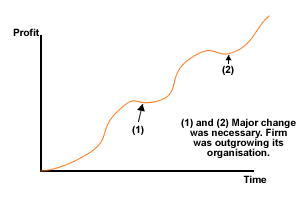
Figure 1 Growth of a firm
Growth is often split into two types - internal and external. These can be defined as follows:

Internal growth
Internal growth is where a firm gets larger from expanding by using its own resources. This is often known as organic (natural) growth. Growth comes from increased sales and higher profits, which are then reinvested in the business.

External growth
External growth is when a firm grows by taking over or merging with another firm (integration). This is often known as inorganic growth.
Internal growth
Internal growth, as we have seen, is a firm expanding by using its own resources. This is achieved by:
- Increasing sales revenue by improving products and services and making them more attractive to customers
- Better marketing of its product range
- Investment in research and development
- Improved training of its workforce
- Expanding the number of offices, factories and outlets
Benefits of organic growth
- Internal growth is relatively inexpensive, and the firm will not have to rely on outside sources of funds as most expansion is funded by retained profits.
- The owners of the business will be able to maintain control of the business whereas external growth may require the raising of additional capital. This may lead to a change in ownership.
- The business will be able to retain its identity and corporate culture as these will not be diluted by joining with other organisations.
Problems of organic growth and a change in size
Internal growth can cause problems within the firm. Since growth requires change in management structure, decision making process and its reporting systems.
As more people are employed, there is a need for more layers of hierarchy. As a result the chain of command becomes longer and decision making slower. Businesses will have to decentralise, and allow decision making to be taken more remotely. Trust will have to be earned and given. This is the area of diseconomies of scale, and will be a distinct disadvantage to future growth. Firms will have to cut bureaucracy, and eliminate layers (de-layering) of non-productive staff.
If a firm grows faster than its ability to manage its staff or control its costs, it is said to be 'overtrading'. This is frequently the underlying cause for falling profits and cash flow problems.
For private and public limited companies, the owners are the shareholders. Even if the founders are still majority shareholders, they have a legal obligation to consider the interests of all the other shareholders. In reality they can often run the company for themselves, almost ignoring the shareholders. This may be easy to do if there are many small shareholders, but harder if there is a group of large shareholders. Real conflicts can develop between the owners and the directors of a large company.

Conflict at Prudential AGM
Prudential plc is an international financial services group with significant operations in Asia, the US and the UK. They have approximately 25 million customers with £290 billion of assets under management. However, Prudential Chief Executive Tidjane Thiam was forced to apologize directly to shareholders when the insurer held its Annual General Meeting after it was humiliatingly forced to pull its $35.5 billion bid for AIA, the Asian insurance division of AIG.
The botched bid, which racked up $658.8 million in adviser fees and other costs, has led investors including top 15 shareholder Schroders to call for Thiam to quit, although other owners said it would be premature to force him out.
Read the article, Prudential bosses apologise for AIA deal collapse (you can do this in the window below or follow the previous link to read the article in a separate window) and then consider answers to the questions below.

The reasons why the Prudential considered external growth are given in this article on:

Questions:
- Define the terms:
- Annual General Meeting (AGM)
- Shareholder.
- Explain what is meant by the separation of ownership and control.
- Analyse the reasons why Prudential was considering expansion in Asia using a takeover.
- To what extent is there likely to be conflict between stakeholders within any business?
Change in legal structure
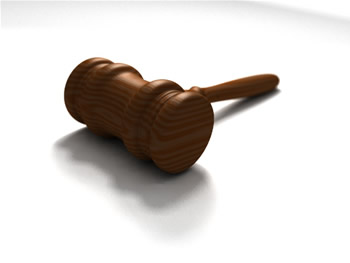 Problems of direction, management and control will occur when a firm grows if this requires a change in legal structure. Problems will occur on changes from sole trader to limited company, from limited company to plc, from national to international company. The business will also face problems if growth stops.
Problems of direction, management and control will occur when a firm grows if this requires a change in legal structure. Problems will occur on changes from sole trader to limited company, from limited company to plc, from national to international company. The business will also face problems if growth stops.
Legal actions have to be taken when the legal structure of a firm changes. These may be expensive. It may also be hard to change the legal structure unless conditions are right. It may not be possible to sell shares in a company unless:
- The financial history of the firm is good
- Its prospects for the future are good
- The overall market conditions are good.
The recession of 2007 onwards has made it more difficult to businesses to convert to plcs.
Expansion of operations is a common form of growth. Becoming an international operation can cause real problems, examples of which are:
- Adjustment to new laws.
- Having to deal with foreign languages
- Having to deal with different cultures.
- Longer chains of command and communications.
Reductions in size
So far we have concentrated on growth. Many firms expand and shrink on a cyclical basis. Shrinkage can cause real problems, involving:
- Reductions in staff levels. Trade unions will have to be consulted. Redundancies will have to be organised. Will these be voluntary or compulsory? How will a firm retain its key staff?
- Loss of morale and motivation amongst the remaining staff, as they fear they may be next.
- Cost of redundancies. Compensation to leaving staff may be considerable which will delay any cost savings for some time (costs may even rise for a few months).
External growth
There is often a limit to how much a firm can grow internally. This limit is the result of:
- Lack of funds
- Inadequate knowledge of new markets
- A desire to grow more quickly
External growth has the advantages of being:
- a faster way to grow and diversify
- a method of reducing competition
- able to grow market share
- an excellent way of gaining new skills, experience and ultimately customers
However, external growth tends to be an expensive method of growth and can radically change the nature and culture of a business.
There are three methods of external growth:
- Joint venture
- Strategic alliances
- Mergers and takeovers
Joint Venture and Strategic Alliance
External growth can be achieved by entering into a joint venture or strategic alliance. Although the methods are different, they do represent a similar method of external growth.

Joint venture
An agreement between two, or more organisations, to undertake a particular business activity. There will be a contractual agreement between the organisations and the joint venture becomes a separate legal entity. All organisations share in the profits or losses of the enterprise and will share the investment.

Strategic alliance
A strategic alliance is a collaborative agreement between two or more firms to pursue a set of agreed goals, but the firms remain completely independent organisations. The alliance ends when the goals are achieved.
A joint venture means setting up a separate organisation in which all the 'partners' have a stake. This arrangement allows the participating companies to grow, while maintaining their own identity and brands.
A joint venture and strategic alliance offer the following advantages and disadvantages:
Advantages:
- Competition may be reduced - by working in cooperation with another firm.
- A synergy is created where the joint skills, resources and experience of the businesses collaborating far exceed those of the two businesses acting independently.
- By partnering with a local firm, there may be fewer logistical problems entering a new and/or overseas market and it may be possible to take advantage of the local knowledge and distribution channels of the partner firm. This may lower distribution costs and may also reduce any problems due to language or cultural issues.
- Allows firms to work together without being burdened by these costs or the permanency of the arrangement. Mergers or takeovers are expensive and difficult to reverse.
- Enable a firm to move into a new product or market much faster.
- Avoidance of taxation, or at least rates on tax in the country of production.
Disadvantages
- Profits are shared - this may be regretted by the firm if subsequently they feel they could have carried out the activity quite easily themselves.
- Communication and control issues - there may be some issues with control in a joint venture - who has the final say? There may also be communication problems caused by cultural and language differences if the firms are very different in their organisational structure and management style.
- Conflict - there may be disagreements between the partner organisations especially if there are inadequate conflict resolution procedures. The joint arrangement requires goodwill to be maintained throughout the term of the agreement.

For more information on joint ventures and strategic alliances, why not have a look at the following Wikipedia pages?
For an example of how joint ventures can result in disputes, why not have a look at the BBC news article - Chinese war of words hits Danone. You can view this in the window below or follow the previous link to view it in a new window.
Mergers and takeovers
Buying a competitor, supplier of business customer can increase the speed of growth
We will now look at these in the context of an example firm - Student Computers plc. This company manufactures computers that it sells to retailers. It buys in most of its components.
How might it grow?
1. It could arrange a merger or a takeover.

Merger
Two firms agree to become one. They agree to merge. They become partners. This is unlikely to be the position for long as one partner starts to dominate. Staff will have to be made redundant, as two parallel staffs are not required. The new business starts to look for economies. At Board level, there is no room for two Chairmen, two Chief Executive Offices. Which of the directors leave the organisation will indicate which of the firms is dominant.

Takeover
A takeover is when one firm buys another, with or without its approval. One firm is dominant and becomes the owner. It is the taken-over firm that will face the brunt of the redundancies.
Takeovers and mergers could be horizontal or vertical.

Horizontal merger
A horizontal merger is when two companies in the same industry and at the same stage in the chain of production merge. An example is a merger between two breweries. It is also known as horizontal integration.

Vertical merger
A vertical merger (integration) is where firms at different stages of the production chain merge together. It may be either vertical forward integration where a firm merges with another further up the chain (e.g. a brewery taking over a chain of bars) or vertical backward integration where a firm merges with one further down the production chain (e.g. a brewery taking over a hop farm).
If a firm controls the whole distribution channel it is totally vertically integrated e.g. Shell owns oil-rigs, oil tankers and pipes, refineries and petrol stations.
Firstly, a reminder that firms can operate in one or more of the following sectors:
- Primary sector - extractive industries e.g. farming, mining, forestry and fishing.
- Secondary sector - manufacturing and construction.
- Tertiary sector - services (shops, banks etc.)
- Quaternary sector - high technology businesses
For a more detailed reminder of the various sectors, you may like to look at the 'Sectors of the economy' interaction in an earlier section.
Horizontal mergers or takeovers occur when two firms come together at the same level. Student Computers plc would join with another computer manufacturer.
Vertical mergers or takeovers occur when firms in different sectors come together. Student Computers plc may take-over a retailer (forward vertical merger) or it might buy a producer of silicon wafers, or paper pulp (backward vertical merger).
Figure 1 below summarises these possible types of integration.
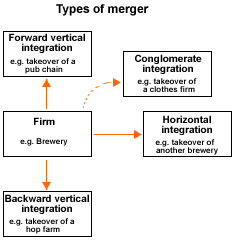
Figure 1 Different types of integration
2. It might aim to become a conglomerate.
This means that the firm, for example Student Computers plc, would expand into all sorts of activity - property management, mining, selling of CD's. The only requirement is that they can make money out of it.
Most conglomerates are also multinationals as they operate in more than one country.
3. In certain circumstances, there may be a management buy-out.
This is when the management of a firm, usually with the help of a venture capitalist, offer to buy the company. This rarely occurs when a firm is doing really well, more often when it is in trouble, or is facing a take-over from other companies.
4. They may buy a brand from another firm
The process of buying a brand from another firm is known as brand acquisition. It is not a full merger - that means the purchase of the whole company, but is simply the takeover of one of the firm's brands. Firms may often sell brands if they feel they do not tie in with their core business.
Risks and rewards
The opportunities from takeovers and mergers are obvious - increased market share, access to new markets, access to private R&D, less competition - but they can be obvious to the competition as well. A plc is always vulnerable to an unfriendly takeover. All that is required is for 50% of the shares of a business, plus one more, to be bought by the acquiring business. As quoted companies cannot restrict sales of their shares on the stock market, they have little defence to a predator, except to try to persuade existing shareholders not to sell their stake.
The rewards for the acquiring business can be summarised as:
- Faster growth
- New products
- Access to R&D
- New key personnel
- Access to new markets
- Greater market share
Firms looking for suitable merger partners or acquisitions often seek economies of scale and synergies. Synergies refer to a fit of complementary activities; rather like pieces of a jigsaw. A synergy is like saying '2 + 2 = 5, the whole is greater than the value of the two independent parts. This was a term first adopted in a business context by Igor Ansoff, who was responsible for establishing strategic planning as a management activity in its own right.
Problem may arise with takeovers and mergers. Mergers are dangerous; one side will want to dominate. It might mean you lose control at the critical moment. You may also pay too much and this may cause financial problems in the future (perhaps from having had to borrow too much and therefore having become too highly geared). Valuation of another firm can be difficult from the outside.

Examples and illustrations
This is an area where it may be useful to bring in examples (where relevant). A good way to find these is to do a search in the Biz/ed In the News archive. You might want to try searching on terms like:
- Merger
- Takeover
You can try this in the window below:
Often customers like to shop with small local or regional firms, especially if they are founded on certain socially responsible criteria or perhaps just quirkiness. They build their goodwill on this basis and their independence. However, as these businesses grow and become more profitable, they often become the target of takeover, and despite the owners best intentions it may be difficult for them to resist the substantial rewards from selling to a larger company.

Ben & Jerry's
 One example of a controversial takeover is Ben & Jerry's ice cream, acquired by the multinational Unilever. Ben & Jerry's was founded by "hippy capitalists" Ben Cohen and Jerry Greenfield in a converted petrol station in Vermont in 1978.
One example of a controversial takeover is Ben & Jerry's ice cream, acquired by the multinational Unilever. Ben & Jerry's was founded by "hippy capitalists" Ben Cohen and Jerry Greenfield in a converted petrol station in Vermont in 1978.
The founders always believed passionately in the social principles of their business and in the need to be environmentally friendly in their operations. In 1985, the Ben & Jerry's Foundation was established with a gift from Ben & Jerry's to establish community-oriented projects and then funded each year from a donation equivalent to 7.5% of the company's pre-tax profits. The firm's customers tended to support the high ideals of the business and were shocked when the founders decided to sell their business to a large corporation in 2000.
Unilever, the Wall's ice cream and Flora margarine group, strengthened its brand portfolio paying $326m for the ice-cream business. Ben & Jerry's unusually-named flavours, such as Chunky Monkey and Cherry Garcia were added to Unilever's Wall's ice-cream brands, including Magnum and Solero. Details of the takeover were reported on the BBC website:
However, Unilever took the strategic decision to keep Ben and Jerry's separate from the main Unilever business in an attempt to retain its reputation for corporate social responsibility (CSR) and the attached customer goodwill and brand loyalty. Many commentators saw this as a cynical, rather than a principled move. If you visit the Ben & Jerry's website there are no overt references to Unilever as the parent company. For instance, the chronological history of the company does not include the takeover.
The following article about the takeover identifies many of the issues that face small firms as they grow and change in nature and business structure:
Stop me and buy a Ben & Jerry's

Questions:
- Distinguish between a takeover and a merger
- Explain the importance of customer loyalty to Ben and Jerry's
- Analyse the advantages and disadvantages of the ethical objectives that underpin Ben and Jerry's operations
- Evaluate the reasons for Unilever's takeover of Ben and Jerry's
Porter's generic strategies

For an organisation to obtain a sustainable competitive advantage, Michael Porter suggested that they should follow either one of three 'generic' strategies.
These ideas were developed by Michael Porter in 1980 in his book Competitive Strategy: Techniques for Analysing Industries and Competitors. He argued that the strengths of a firm basically fall into one of two categories:
- Cost advantageor
- Differentiation
He then looked at applying these strengths in either a broad scope (looking at the whole market) or a narrow scope (looking at a particular segment of the market). As a result of this approach, he came up with three 'generic strategies'.
They are called generic strategies because they are not firm or industry dependent. The diagram below illustrates these different strategies.
If you would prefer to view this interaction in a new web window, then please follow the link below:
The skill required is to choose the right strategy at the right time. These generic strategies are driven by five competitive forces that the organisation has to take into account (see unit 4.2 in the marketing topic).
Porter warned against firms becoming 'stuck in the middle', where they feel threatened on all fronts by new competitors and respond by trying to compete on costs, image and quality rather than selecting the strategy most appropriate for the business. Unless the business focuses on the areas where it has a competitive advantage, customers will become confused about what the business is and what it represents.

Without looking at the diagram above, can you match the generic strategies with their market position?
1 |
Porter's generic strategiesCan you match each generic strategy with its market position? |

Franchises
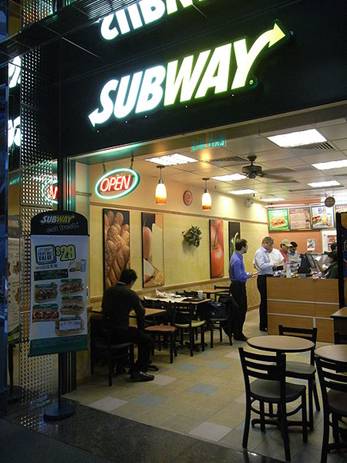 A franchise may be set up as a sole trader, partnership or company. Examples are McDonalds and Subway.
A franchise may be set up as a sole trader, partnership or company. Examples are McDonalds and Subway.
A franchise is an agreement between two parties; the Franchisor and the Franchisee. The franchisee is allowed to use the brand name, logo, trademark and products/services of the Franchisor in return for:
- An up-front, one-off payment called a royalty to be allowed to use the brand name
- An annual share of the profits
There are clear advantages to setting up a new business as a Franchisee:
- There is no need to come up with a new idea - someone else has had it and tested it, too! Consequently failure rates are far lower than other start ups, often around one in ten.
- Larger, well-established franchise operations will often have national advertising campaigns and a solid trading name
- Good franchisors will offer comprehensive training programmes in sales and indeed all business skills.
- Good franchisors can also help secure funding for your investment as well as e.g. discounted bulk-buy supplies for outlets when you are in operation
- If aware that you are running a franchise, customers will also understand that the franchise is part of a much larger organisation, which may provide greater credibility
There also many advantages for the Franchisor:
- The business can achieve rapid growth without high capital investment and running costs.
- Franchisees are likely to be more motivated and committed than paid managers as increasing profits is a major incentive.
However, there are RISKS or disadvantages associated with franchising for both the franchisor and franchisee:
Franchisee:
- Costs may be higher than expected. As well as the initial costs of buying the franchise, the franchisee pays continuing royalties and may be required by the contract to buy products from the franchisor which may not be the best or the cheapest.
- The franchise agreement usually includes restrictions on the operation of the business. This may prevent changes to suit the local market.
- The franchisor might go out of business, or change the way they do things.
- Other franchisees could give the brand a bad reputation.
- The franchisee may find it difficult to sell the franchise - the terms of the contract may restrict sale to someone approved by the franchisor.
- Reduced risk means you mean lower profits.
Franchisor:
For the franchisor, there is a risk that a poor or unscrupulous franchisee may affect the brand image of the entire business. It is not unknown for franchisees to 'steal' an idea and then set up in opposition. Franchisors attempt to prevent this by restrictions in the franchise contract, but it may be very difficult and costly to enforce.
Franchising is a major growth area in many countries, because this model is considered far less risky and less costly than setting up a new business from scratch. Entrepreneur magazine produces an index of the top 10 global franchises (you can see the 2011 results here).
The top 10 Global Franchises (2010):
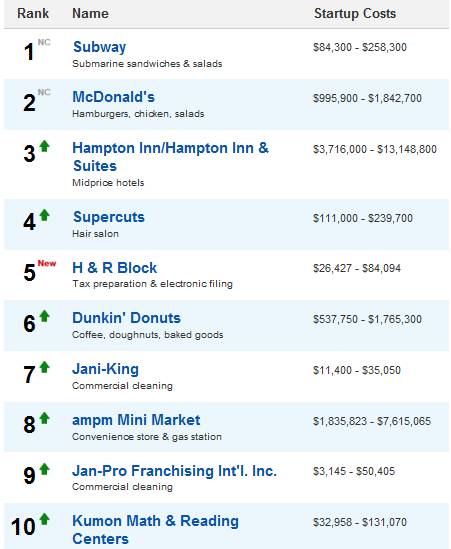

1 |
Ansoff matrix
This is another useful tool for a business when it is analysing its growth potential and setting marketing objectives.
The Ansoff product-market matrix, developed by Igor Ansoff, 'the father of corporate strategy' in 1957, helps firms to understand and assess marketing or business development strategy. Any business, or part of a business, can choose which strategy to employ, or which mix of strategic options to use. The matrix is used primarily to understand the risk component of various growth strategies. Ansoff argues that within a company there should be an element of 'core capability', linking past and future activities. In other words companies should concentrate on those things that they know and do well already, and build upon this.
If you would prefer to view this interaction in a new web window, then please follow the link below:

Some quick questions
- Identify examples of each Ansoff's growth strategies.
- Explain the reasons why a business decides to diversify.
Have a think about the answers to these and then follow the links below to compare your answers to ours.
Question 1 - answer
Question 2 - answer
1.7 Growth and evolution - questions
In this section are a series of questions on the topic - Growth and evolution. The questions may include various types of questions. For example:
- Self-test questions - on-screen questions that give immediate marking and feedback
- Short-answer questions - a series of short-answer questions to help you check your understanding of the topic
- Case study - a case study with associated questions
- In the news - questions based around a topical business news article
Click on the right arrow at the top or bottom of the page to work through the questions.
PSA Peugeot CitroŽn in joint signs joint venture agreement
Read the article French PSA Peugeot Citroen signs joint venture with Chinese Changan Automotive Group (you can do this in the window below or follow the previous link to read the article in a separate window) and then consider answers to the questions below.

You may also like to read the BBC article on the joint venture:

Question 1
Define the terms:
- joint venture
- investment.
Question 2
Explain the benefits that PSA Peugeot CitroŽn expect to arise from the joint venture to manufacture in China.
Question 3
Comment on the statement that, 'Peugeot-Citroen and Chang'an are also creating a new brand with a separate identity from those of the French company or Chang'an'.
Question 4
Evaluate the use of joint ventures to expand into new markets.
Southwest airlines to buy AirTran
Read the article Southwest Airlines to buy rival US carrier AirTran (you can do this in the window below or follow the previous link to read the article in a separate window) and then consider answers to the questions below.

You may also like to read a further article on the joint venture:

For more background information on the airline industry you may want to watch these short videos from CNN:

Question 1
Define the terms 'merger' and 'takeover' and explain which of these terms would be most appropriate to describe Southwest Airlines and AirTran.
Question 2
Explain four consequences of the acquisition.
Question 3
Analyse methods by which Southwest Airlines has attempted to differentiation itself from its competitors.
Question 4
Evaluate external growth as a method of achieving Southwest' Airline's growth objectives.
Pfizer acquires Wyeth for $68bn
Read the article Pfizer acquires Wyeth for $68bn (you can do this in the window below or follow the previous link to read the article in a separate window) and then consider answers to the questions below.

Question 1
Define the terms:
- merger
- patent
Question 2
Analyse the advantages and disadvantages of the merger for the two firms.
Question 3
Assess the likely impact of the merger on pharmaceutical consumers.
Question 4
Evaluate the relative merits of small versus large organisations, with particular reference to the pharmaceutical industry.
Extension activity:
Carry out a PEST analysis for the newly merged Pfizer-Wyeth. You may like to research more widely on the web to find out about political and economic factors that are likely to affect the merged firm.
EU court rules against betting monopoly
Read the article E.U. Court Bats Down Germany's Protection of Betting Monopolies
(follow the previous link to read the article in a separate window) and then consider answers to the questions below.

You might like to read this New York Times' article to support your answer to question 4:

Question 1
Describe the 'monopoly' practices identified in the article?
Question 2
Identify policies that are currently used in the country where you live by the government to try to prevent such monopoly practices.
Question 3
Analyse the consequences of EU ruling against Germany's monopoly of the betting industry.
Question 4
Evaluate the strengths of the arguments for and against state monopolies in the betting industry.
Picking up the pieces
Read the article Picking up the pieces (you can do this in the window below or follow the previous link to read the article in a separate window) and then consider answers to the questions below.

Question 1
If Lego made a "DKr1.6 billion ($240m) operating loss on sales of DKr6.8 billion", calculate their profit margin.
Question 2
Define the term 'diversification'.
Question 3
Carry out a SWOT analysis for the Lego business.
Question 4
Discuss the reasons why Lego's attempt to establish themselves as a "lifestyle brand" ended in a high level of losses.
BBC dances around the world
Read the article, Why children's television has to rely on merchandising deals (you can do this in the window below or follow the previous link to read the article in a separate window) and then consider answers to the questions below.

Question 1
Describe the strategy that BBC Worldwide are planning to adopt to expand their business overseas.
Question 2
Explain why 'most companies that focus on making children's shows have to bring in co-production cash or, increasingly, rely on revenue from licensing'.
Question 3
Analyse how the objectives of a non-profit organisation like the BBC may differ from a profit making firm.
Question 4
With reference to the Ansoff Matrix and other appropriate strategic tools, discuss the extent to which the BBC funding and expansion strategy is likely to work.
Becoming a Subway franchisee

Click on the following link to find out about becoming a Subway franchisee. Subway is the largest Franchise operation in the world.

Produce a booklet entitled 'Becoming a Subway Franchisee'. Include the following:
- a brief description of Subway
- a summary of the franchising requirements
- an analysis of the advantages and disadvantages of franchising for franchisor and franchisee
1.7 Growth and evolution - simulations and activities
In this section are a series of simulations and activities on the topic - Growth and evolution.
DragIT - Build an Ansoff matrix
Build an Ansoff Matrix in the diagram below by dragging the appropriate classifications into the right place in the matrix.
1.6 Change (HL only) - notes
Change and management of change (HL only) - Introduction
So far we have examined the nature of business activity, types of organisations and objectives and investigated the nature of stakeholders. We have also considered the impact of the external environment on the firm in terms of the opportunities and threats it provides and prepared and evaluated a range of decision making tools. We have explained and evaluated growth and the tools to support the process.
We now move on to consider change and the management of change.

- Explain the causes of change and factors causing resistance to change
- Examine the dynamic nature of organisations and the relative importance of driving and restraining forces
- Evaluate different strategies for reducing the impact of change and resistance to change
Change

The only real, enduring strategic advantage comes from changing the rules of the game.
Businesses are dynamic in nature and subject to constant change in their internal and external environments. The rate of change is accelerating with increasing globalisation of business activity and the application of new technologies, making markets even more competitive, complex and open to new business models.
Every change is both an opportunity and a threat to an existing business. Successful businesses constantly monitor their markets and anticipate and plan for change. Unsuccessful businesses usually do not! Change is never easy to implement and manage and it is likely to be resisted by some employees and other stakeholders. Business survival, therefore, is about the management of change.
Significant change may force a business to reconsider such fundamentals as its mission and vision statements and the way it structures, manages and coordinates its operations. This may lead to a change in the corporate culture of the firm.

Causes of change

With increasing globalisation and rapid developments in markets around the world, change is inevitable in all aspects of business operations. No firm or organisation can rely on their customer base staying loyal over the long-term. Expectations and needs change rapidly and firms have to adapt to meet these. However, change is not always easy to manage effectively and there may well be resistance to change.
External drivers of change
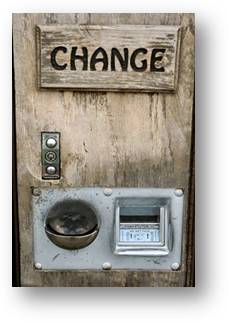 Change may result from a range of different areas, but stems mainly from change in the external environment. The causes of change may include:
Change may result from a range of different areas, but stems mainly from change in the external environment. The causes of change may include:
- Social factors and changes in consumer tastes - consumer expectations and tastes change over a period of time and firms need to adapt to this. For example, the growth in sales of organic and Fairtrade products in recent years has forced many food producers to adapt their product ranges.
- Market changes - new competition, changes in the structure of markets and other factors will affect how firms operate. For example, the growth of the European Union and the emergence of many other free trade areas around the world has changed the structure of many markets and led to more competition as tariff and other barriers are broken down.
- Population changes - changes in the population structure will mean that firms need to change. This may be because of changes to the potential supply of labour to the nature of their markets in which they operate. An ageing population in many developed countries will result in shortages of workers as well as changes in the pattern of demand for goods and services.
- Technological developments - changes in technology have led to new opportunities, both in production terms, but also in terms of product development. Recent years have seen a plethora of new technology-based products emerging.
- Legislation - political change may also affect firms and the way they operate. For example, changes in health and safety legislation may require a firm to change or adapt their production methods and/or product specifications.
- Economic trends - the recession that began in late 2007, has already had significant effect which will continue for years to come. Customers shopping habits will adapt to the new economic climate and firms will be forced to adapt as well.
Internal drivers of change
The internal resources of a business are in constant flux, and management needs to be aware of these and to react appropriately. The need to change can be driven by:
- Changes in the nature and size of the workforce
- New management and/or management styles
- Financial requirements and the availability of funds
- Changes in the expectations, attitudes and values of the workforce
- New product and service offerings
- The firm's corporate image if it is based on dynamism and innovation

Resistance to change

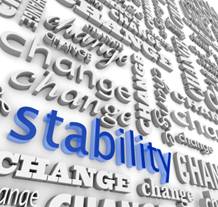 People are not always quite as ready to change as the firms they work for and rapid change may create resistance. There is an element of self-interest in us all. People may be more concerned with the implications of change for themselves, rather than the benefits the change may bring to the organisation. Some employees may fear the unknown and be happier with existing working practices. Fear of unemployment will also be a key factor causing concern as well as an increased workload.
People are not always quite as ready to change as the firms they work for and rapid change may create resistance. There is an element of self-interest in us all. People may be more concerned with the implications of change for themselves, rather than the benefits the change may bring to the organisation. Some employees may fear the unknown and be happier with existing working practices. Fear of unemployment will also be a key factor causing concern as well as an increased workload.
However, resistance to change may also come from within the organisation if the organisational culture is not one that is flexible and adaptable. An organisation that has not been used to rapid change may have developed a culture of comfort where employees at all levels are reluctant to adopt changes as they occur. If resistance to change exists at a group level, change may be more difficult to implement. In this instance, the firm will need to work on changing culture as well as the systems and procedures that need adapting.

Force Field Analysis

 Force field analysis is a technique developed by German psychologist Kurt Lewin.
Force field analysis is a technique developed by German psychologist Kurt Lewin.
Lewin believed that people's behaviour is affected by forces in their surrounding environment or 'field'. Successful firms need to be constantly adapting to changes in the environment.
Force field analysis uses the concepts of:
- Driving forces, and
- Restraining forces
Driving forces promote the change, while restraining forces hinder the change. Things such as ambitions, goals, needs or fears drive people towards or away from something constitute driving forces. Restraining forces, however, are different in nature as they act to oppose driving forces rather than constituting driving forces in themselves. Force does not imply physical pressure, but refers to the broad range of internal and external influences at a particular time.
Lewin asked two questions:
- Why does a process continue at its current level under the present circumstances?
- What conditions would change these circumstances?
Force field analysis can help indicate when the driving and restraining forces are not in balance, creating an opportunity for change. To help move towards a desired change the firm will need to develop a strategy to minimise the restraining forces and/or maximise the driving forces. These form the basis of change management, a theme developed in the next section.
A force field analysis diagram shows the forces in opposite directions.
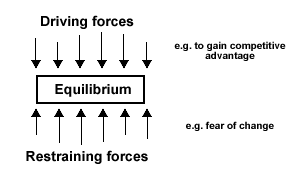
Force-field analysis
It is common for the strength of the force to be represented by the length of the arrow. The longer the arrow, the stronger the force. The force-field diagram will help managers decide whether a change is worth pursuing by:
- Examining the balance between driving and restraining forces
- Identifying the individuals or groups affected by a change
- Identifying supporters and opponents of the change
Managers will be encouraged to examine each of the forces in turn to establish the underlying factors behind each and consider strategies to inhibit restraining factors and to strengthen driving forces. It is the strategy used to implement the change that is important. Strengthening the drivers would seem the obvious policy, but analysis shows that this can lead to the strengthening of the resistors. Reducing the restraining forces, may be more effective.

For more detail, read the Wikipedia article on force-field analysis. You can do this in the window below, or you can follow the previous link to open the link in a new window. You may also find the mindtools.com article on force-field analysis useful.

Impact of change

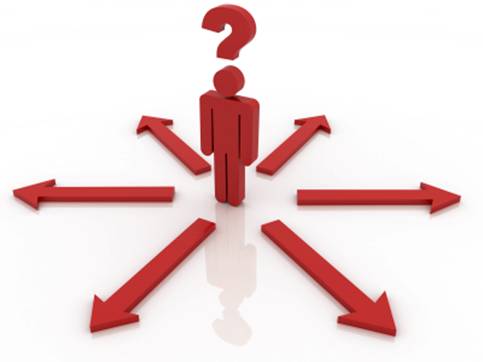 Rapid change can force businesses to restructure and make changes to retain their competitive advantage. Change normally makes product life cycles shorter which requires increased investment in research and development to maintain a balanced portfolio of products. Firms may find that a product that was a 'cash cow' in their Boston Matrix may quickly become a 'dog'. Research and development is necessary to ensure a new crop of 'stars' for the future. Firms will also have to look carefully at what their competitors are doing using benchmarking to ensure that they remain competitive.
Rapid change can force businesses to restructure and make changes to retain their competitive advantage. Change normally makes product life cycles shorter which requires increased investment in research and development to maintain a balanced portfolio of products. Firms may find that a product that was a 'cash cow' in their Boston Matrix may quickly become a 'dog'. Research and development is necessary to ensure a new crop of 'stars' for the future. Firms will also have to look carefully at what their competitors are doing using benchmarking to ensure that they remain competitive.
Firms will have to focus increasingly on quality as consumer tastes change and expectations rise. Quality approaches such as TQM (Total Quality Management) may, by changing the organisational culture, reduce resistance to change.
Change will also impact on working practices. To be more responsive and flexible firms may consider:
- More part-time and temporary working - people may be employed on shorter or even temporary contracts to allow the firm to adapt rapidly to changing circumstances.
- Increased working from home - people working from home enable the firm to respond quicker to changing circumstances. They don't need to build physical space to accommodate people in response to rapid changes in demand. Technological developments are leading to this becoming increasingly common with people able to access company resources through company networks.
- Increased incentive payments - firms may restructure their remuneration packages to try to incentivise people more and make them more willing to accept required changes.
As can be seen, change affects all aspects of the Business and Management programme and will impact on all business functions. Managing change may have some of the following implications:
- New production methods
- Flatter, smaller organisations
- Improved communication techniques
- Increases in research and development
- More frequent market research to identify trends in consumer tastes and buying habits
- Additional finance to fund new investment

Change management

If change is to be successfully introduced then the process has to be carefully managed.
John Storey
Research by John Storey has suggested four different approaches to managing change:
- A total imposed package - this would be a whole package of changes and as the title suggests would simply be presented to the employees as a 'fait accompli'. The senior management team would work out the restructuring they feel is required and then simply impose this on the firm. This has the advantage that it will create rapid change and ensure that the vision for the direction of the company is clear, but if the organisational culture does not match this approach then there may be significant resistance to change.
- Imposed piecemeal initiatives - this is a more gradual approach. Change and restructuring is still imposed by senior management, but in stages rather than all at once. This may give employees more time to adapt and may help alleviate resistance, but it will still need to be accompanied by changes in the organisational culture to encourage change. To help the introduction of the initiatives the firm may offer incentive payments or perhaps other non-financial rewards for the successful implementation of the changes. They may introduce quality circles, or team meetings to help manage the process.
- Negotiated total packages - similar to no.1 with the obvious difference that the aim is to agree the package through negotiation with the workforce. This may help significantly reduce the level of resistance to change though it may also act as a constraint on the extent of the change. However, this type of approach is growing more popular with trade unions keen to negotiate changes and ensure that their members benefit from change and are helped to cope with change.
- Negotiated piecemeal packages - similar to no.2, but as with 3 the gradual implementation will be negotiated at each stage. Once again the change may be linked to incentive payments - perhaps through productivity deals.
Kurt Lewin
 Kurt Lewin believed that to achieve change effectively, it was necessary to examine all the options for moving from the existing state to the desired future one. His change management model is linked to force field analysis and he classifies resistance into two categories. The first relates to 'social habit' or 'custom' and the second to 'inner resistance'. These classifications are rooted in the link between a group as whole and the individuals within it. He developed a three process of change management designed to break the habits, challenge the self interests and 'unfreeze' the customs of the group:
Kurt Lewin believed that to achieve change effectively, it was necessary to examine all the options for moving from the existing state to the desired future one. His change management model is linked to force field analysis and he classifies resistance into two categories. The first relates to 'social habit' or 'custom' and the second to 'inner resistance'. These classifications are rooted in the link between a group as whole and the individuals within it. He developed a three process of change management designed to break the habits, challenge the self interests and 'unfreeze' the customs of the group:
- Unfreezing - this stage involves overcoming any resistance or inertia to change among employees. This is done through discussion groups, meetings, information dissemination or any other process. At this stage, preconceptions, values and beliefs need to be challenged if the change is to be successful.
- Change - the second stage is where the change itself occurs. The shift from unfreeze to change may not happen overnight, but the idea is that people gradually adopt a new mindset and are therefore more open to accepting and implementing change.
- Refreezing - the final stage is to set the change in place. This process will institutionalise the change and ensure that it is embedded in the organisation. The new patterns of working can be built into job descriptions and changes in the organisational structure formalised and confirmed. The change is now embedded
Not surprisingly, Lewin used the analogy of a block of ice. He suggested that if you have a block of ice, but want a cone of ice, you will need to unfreeze the ice, mould it to the new shape required and then refreeze it. However, managing the process of changing a block of ice into a cone is probably much easier than change management in many large firms!
Leading change - Kotter's model of change management
If you would prefer to view this interaction in a new web window, then please follow the link below:

1.9 Globalisation - notes
Introduction
So far we have examined the nature of business activity, types of organisations and objectives and investigated the nature of stakeholders. We have also considered the impact of the external environment on the firm in terms of the opportunities and threats it provides and prepared and evaluated a range of decision making tools. We then considered the driving and restraining forces for growth and evolution of different businesses and the management of change.
In this section we will examine the growth of globalisation and multinational organisations and explain the impact of regional trading blocs.

By the end of this section you should be able to:
- Discuss reasons for the growth of multinational organisations in response to increasing globalisation
- Analyse the role played by multinationals in the global business environment
- Evaluate the impact of multinationals companies on the host country
- Explain the impact on a business of a country that is a member of a regional economic bloc
Globalisation defined

Globalisation
Fundamentally, globalisation is the closer integration of countries and peoples of the world which has been brought about by the enormous reductions of costs of transport and communications and the breaking down of artificial barriers to the flow of goods, services, capital, knowledge and to a lesser extent, people across borders
Joseph Stiglitz, former chief economist at the World Bank
 Globalisation is an umbrella term for a complex series of economic, social, technological, cultural and political changes seen as increasing interdependence, integration and interaction between people and companies in disparate locations.
Globalisation is an umbrella term for a complex series of economic, social, technological, cultural and political changes seen as increasing interdependence, integration and interaction between people and companies in disparate locations.
The concept has been referred to as 'the shrinking of time and space'.
Globalisation in the economic, social and political fields has been on the rise since the 1970s, receiving a particular boost after the end of the Cold War. Many economists believe globalisation may be the explanation for key trends in the world economy such as:
- Lower wages for workers, and higher profits, in Western economies
- The flood of migrants to cities in poor countries
- Low inflation and low interest rates despite strong growth
Globalisation has accelerated in the last 15 years. During a period of relatively strong economic growth, world exports as a share of GDP increased from under 20% in 1994 to over 32% in 2008, and whilst global trade fell back in 2009, as a result of the global slowdown, but bounced back in 2010.
Increasing foreign investment can be used as one measure of growing economic globalization. Foreign direct investment (FDI) is a measure of foreign ownership of productive assets, such as factories, mines and land. The largest flows of foreign investment occur between the industrialized countries. However, in recent years the flows into and out of emerging countries has grown significantly.
Following the recent worldwide recession, world GDP fell more than1% in 2009. Some of the world's key emerging economies suffered sharp recessions during 2009, whilst others notably India and China, were able to maintain strong growth.

An excellent source of information on globalisation is the BBC pages dedicated to this issue.
The drivers of globalisation:
If you would prefer to view this interaction in a new web window, then please follow the link below:
To the extent to which a nation-state is globalised in a particular year has until most recently been measured employing simple measures like flows of trade, migration, or foreign direct investment. A more sophisticated approach to measuring globalisation is the Globalization Index calculated by the Swiss economic institute, KOF. The index covers 208 countries.
The KOF Index of Globalisation measures the three main dimensions of globalisation:
- economic
- social
- and political.
In addition to three indices measuring these dimensions, the index also refers to:
- actual economic flows
- economic restrictions
- data on information flows
- data on personal contact and
- data on cultural proximity.
Some of the highlights from the 2010 KOF press release:

- Belgium comes first in the globalization stakes. Austria, which was in 3rd place last year, now ranks 2nd. This year's fast climber is Luxembourg, which advanced from 21st place to 14th place. Switzerland still comes 4th on the globalization index. While economic and political globalization is advancing, social globalization is stagnating.
- The emerging markets in Eastern Europe and Central Asia are recording the biggest jump on the index.
- In East Asia and the Pacific region, the globalization process has slowed down compared to the previous year, while index rankings actually went down in the Near East and North Africa.
- Macedonia made the biggest jump, advancing 25 places to rank 65.
- Myanmar, Kiribati and the Solomon Islands are at the bottom of the league.
Although released in 2010, the current analysis refers to the year 2007. Consequently, the developments triggered by the financial and economic crisis are not yet included.
The impact of globalisation on business
- Increased competition - this is caused by more foreign investment flowing to countries, de-regulation which allows businesses to enter markets from which they once precluded.
- Greater awareness and reactions to customer needs - the consumer is now very selective on such essentials as quality, service and price.
- Economies of scale - by selling across many continents business can acquire economies of large-scale production. This makes them very competitive.
- Location flexibility - many modern production techniques and service provisions can be allocated almost anywhere. This allows to them gain the advantages of low cost labour and other resource charges.
- Increased mergers and joint ventures - allowing access to bigger markets and associated cost advantages.

The Bangalore Tigers - Wipro, Infosys, TCS (Tata Consultancy Services)
Wipro, Infosys and TCS are India's big three technology companies, all of which have become major global players rivalling the US's largest companies - IBM, Accenture and EDS (HP Enterprise services). Please:
- watch the video The Bangalore Tiger in Bloomsbergand
- read the article Azim Premji believes education is key to India's economic future
before considering answers to the questions below.

Question 1
Define the terms:
- Outsourcing
- Service sector.
Question 2
Explain why Azim Premji believes education is key to India's economic future.
Question 3
Examine methods by which a firm may gain competitive advantage.
Question 4
Discuss the reasons for the growth of India's technology companies such as Wipro, TCS and Infosys.
Extension activity:
Select one of India's top three technology companies and use web searches:
- Describe the nature of the organisation
- Report on recent business activity

Globalisation illustration
A good example of the globalisation is IKEA. IKEA is now one of the world's largest furniture retailers and sell a 'standardised product' worldwide.
- In 1974 there were only 10 IKEA stores outside of Scandinavia and the company annual revenue was $210m.
- In 2006 there were 237 stores in 34 countries and their sales revenue was close to 17.3bn euro.
- They have a global network of suppliers - 1,300 firms in over 54 countries.
- They have very low costs that are partly derived from huge economies of scale - large stores and a highly organised supply chain.
- The IKEA group in 2006 employed 104,000 staff - called 'co-workers'.
You can read about the IKEA concept and see a chronological history of the business here.
Multinationals
Multinational (MNC) or Transnational Corporations (TNC)

MNC
Multinational or transnational corporations (MNC/TNC) are businesses with a headquarters in one country, but with business operations in a number of others.
There are numerous examples of multinational corporations, car manufacturers like Ford, GM, Toyota, Honda and Volkswagen, oil companies like Shell, Chevron and Exxon Mobil, technology companies like IBM, Dell, Microsoft and Hewlett Packard and food and drink companies such as Coca Cola, Pepsico, Kraft and McDonalds.
The following is a quote from the General Motors website site which is an excellent example of a multinational operation:

General Motors, one of the world's largest automakers, traces its roots back to 1908. With its global headquarters in Detroit, GM employs 204,000 people in every major region of the world and does business in some 140 countries. GM and its strategic partners produce cars and trucks in 34 countries, and sell and service these vehicles through the following brands: Buick, Cadillac, Chevrolet, GMC, GM Daewoo, Holden, Opel, Vauxhall and Wuling. GM's largest national market is the United States, followed by China, Brazil, Germany, the United Kingdom, Canada, and Italy.
Multinationals are normally conglomerates and may own a huge number of brands. As consumers we may not always be aware that a range of household brands are in fact owned by a single multinational. Two examples of multibrand manufacturers are Kraft and Unilever. It is fascinating and illuminating to examine their brand portfolio. You may be surprised by some of the names in these lists. Click on the logos below to see the full lists:
The sheer size of many multinationals means they often have considerable power and influence, especially when they locate in less developed countries. Not surprisingly over the years many have been criticised for their commercial behaviour resulting in some very negative press. Indeed, pressure groups have conducted some very high profile campaigns against prominent multinationals. One of the most notorious concerned the Swiss food company Nestlť and its marketing of its infant milk formula to mothers in developing countries, an issue that attracted significant attention in 1977 and a led to a boycott of Nestlť products worldwide.
Several sport's manufacturers including Nike and Puma have been criticised overpoor working conditions and exploitation of cheap overseas labour employed in the free trade zones where their goods are typically manufactured. Nike has also been accused of violating minimum wage and overtime laws in countries such as China, Vietnam, and Mexico.
In addition, events like the Bhopal chemical explosion in 1984 attracted much criticism and, cemented the view that MNCs are by their nature detrimental to the countries in which they operate. Bhopal is ranked with Chernobyl in Ukraine as the site of one of the world's worst industrial accidents. The accident happened at the pesticide plant in Bhopal in the central state of Madhya Pradesh. On the night of 2 December, forty tonnes of a toxic gas leaked from the pesticide factory and settled over slums in Bhopal. Official figures show at least 3,000 people died at the time and as many as 15,000 have died since. A detailed description of the events and links to additional sources of information can be found on the Triple A Learning Business and Management blog.
Why the drive to become multinational?
There are some significant drivers to become multinational. Some of these include:
- Reduced transport and distribution costs: By producing goods and services locally or regionally, firms can save considerable transport costs
- Avoidance of trade and non-tariff barriers: By locating in overseas markets, firms may avoid tariffs, quotas and other forms of protectionism. For instance, Asian firms invested in large numbers in the UK in the 1990s to allow then to export to the European Union and to compete with European suppliers without a cost disadvantage.
- Access to raw materials: by locating overseas, firms can ensure access to raw materials at reduced prices.
- Other cost advantages: for example lower labour, energy and property costs.
- Increased sales turnover: expanding overseas can provide access to large markets, including those of the developing world such as China and other Asian markets.
- Economies of Scale: Increasing scale of operations can lead to both internal and external economies of scale and spreading of risk. Overspecialisation is potentially disastrous for a business. However, multinationals have other markets to compensate, if one market is suffering decline or subject to political instability or natural disasters.
- First Mover Advantage: Getting into markets first provides marketing and distribution advantages, e.g. Tesco chose to expand their retail business into Eastern Europe such as Hungary and Poland, allowing them to acquire market share and customer loyalty before other competitors appear.
- Other Marketing advantages: Overseas brands may have an exclusive desirability allowing premium prices to be charged.
However, some firms have found expansion into overseas markets problematic because of:
- Cultural differences which may mean products and services need to be adapted or will not sell at all, e.g. dairy products in Asian countries.
- Lack of experience in the local market - no core competence
- Language difficulties, e.g. Vauxhall Nova translated as 'no go' in Spain
- Little brand awareness.
- Currency fluctuations and instability
- Political instability
- Local opposition or pressure group activities, e.g. over low rates of pay or use of child labour e.g. Nike and BAT in Burma/Myanmar
- Possible legal restrictions on access - e.g. must find a local partner to operate.
- Limited control over supply and distribution chains
- Greater set-up costs
Note: Solutions to some of these problems may be found through local joint ventures, strategic alliances or use of local agents.
MNCs from Emerging Nations
There has been more to globalisation than just a rise in world trade. There has also been a significant increase in foreign direct investment (FDI) by companies over the last
15 years, particularly those from emerging nations. The advance of globalisation is reflected in the number of companies establishing a presence in other nations. The easing of trade barriers and tariffs and the ICT revolution has underpinned globalisation.
The Fortune Global 500, the annual ranking of the world's largest corporations by revenue, shows the number of Fortune Global 500 companies based in Brazil, Russia, India or China (BRIC) more than double from 27 to 58 in the last five years. The highest placed BRIC firm in this list is Chinese oil giant Sinopec, which was 9th in the overall standings in 2009.
Emerging nations have seen a steady increase in the number of new multinational companies over the last five years with increasing numbers of emerging economy companies setting up operations in foreign countries. This offers a considerable opportunity for local companies that provide business-to-business services, such as communications and IT.
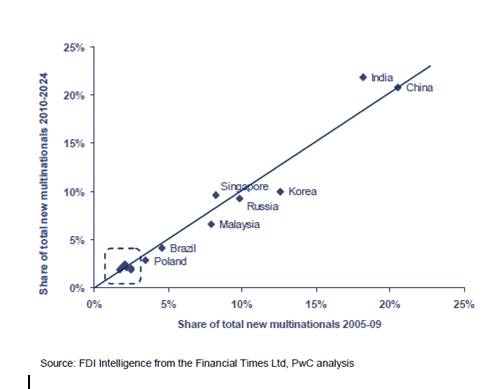

1 |
GlobalisationWhat is meant by the term 'globalisation'? |
2 |
Multinational CorporationsHow might an MNC influence technology and expertise in the countries in which it works? |
Impact of multinational companies on the host country
 Clearly, multinational corporations can provide developing countries with critical financial infrastructure for economic and social development. However, these institutions may also bring with them relaxed codes of ethical conduct that serve to exploit the neediness of developing nations, rather than to provide the critical support necessary for countrywide economic and social development.
Clearly, multinational corporations can provide developing countries with critical financial infrastructure for economic and social development. However, these institutions may also bring with them relaxed codes of ethical conduct that serve to exploit the neediness of developing nations, rather than to provide the critical support necessary for countrywide economic and social development.
When a multinational invests in a host country, the scale of the investment (given the size of the firms) is likely to be significant. Indeed governments will often offer incentives to firms in the form of grants, subsidies and tax breaks to attract investment into their countries. This foreign direct investment (FDI) will have advantages and disadvantages for the host country.
Advantages
The possible benefits of a multinational investing in a country may include:
- Improving the balance of payments - inward investment will usually help a country's balance of payments situation. The investment itself will be a direct flow of capital into the country and the investment is also likely to result in import substitution and export promotion. Export promotion comes due to the multinational using their production facility as a basis for exporting, while import substitution means that products previously imported may now be bought domestically.
- Providing employment - FDI will usually result in employment benefits for the host country as most employees will be locally recruited. These benefits may be relatively greater given that governments will usually try to attract firms to areas where there is relatively high unemployment or a good labour supply.
- Source of tax revenue - profits of multinationals will be subject to local taxes in most cases, which will provide a valuable source of revenue for the domestic government.
- Technology transfer - multinationals will bring with them technology and production methods that are probably new to the host country and a lot can therefore be learnt from these techniques. Workers will be trained to use the new technology and production techniques and domestic firms will see the benefits of the new technology. This process is known as technology transfer.
- Increasing choice - if the multinational manufactures for domestic markets as well as for export, then the local population will gain form a wider choice of goods and services and at a price possibly lower than imported substitutes.
- National reputation - the presence of one multinational may improve the reputation of the host country and other large corporations may follow suite and locate as well.
Disadvantages
The possible disadvantages of a multinational investing in a country may include:
- Environmental impact - multinationals will want to produce in ways that are as efficient and as cheap as possible and this may not always be the best environmental practice. They will often lobby governments hard to try to ensure that they can benefit from regulations being as lax as possible and given their economic importance to the host country, this lobbying will often be quite effective.
- Access to natural resources - multinationals will sometimes invest in countries just to get access to a plentiful supply of raw materials and host nations are often more concerned about the short-term economic benefits than the long-term costs to their country in terms of the depletion of natural resources.
- Uncertainty - multinational firms are increasingly 'footloose'. This means that they can move and change at very short notice and often will. This creates uncertainty for the host country.
- Increased competition - the impact the local industries can be severe, because the presence of newly arrived multinationals increases the competition in the economy and because multinationals should be able to produce at a lower cost.
- Crowding out - if overseas firms borrow in the domestic economy this may reduce access to funds and increase interest rates.
- Influence and political pressure - multinational investment can be very important to a country and this will often give them a disproportionate influence over government and other organisations in the host country. Given their economic importance, governments will often agree to changes that may not be beneficial for the long-term welfare of their people.
- Transfer pricing - multinationals will always aim to reduce their tax liability to a minimum. One way of doing this is through transfer pricing. The aim of this is to reduce their tax liability in countries with high tax rates and increase them in the countries with low tax rates. They can do this by transferring components and part-finished goods between their operations in different countries at differing prices. Where the tax liability is high, they transfer the goods at a relatively high price to make the costs appear higher. This is then recouped in the lower tax country by transferring the goods at a relatively lower price. This will reduce their overall tax bill.
- Low-skilled employment - the jobs created in the local environment may be low-skilled with the multinational employing expatriate workers for the more senior and skilled roles.
- Health and safety - multinationals have been accused of cutting corners on health and safety in countries where regulation and laws are not as rigorous.
- Export of Profits - large multinational are likely to repatriate profits back to their 'home country', leaving little financial benefits for the host country.
- Cultural and social impact - large numbers of foreign businesses can dilute local customs and traditional cultures. For example, the sociologist George Ritzer coined the term McDonaldization to describe the process by which more and more sectors of American society as well as of the rest of the world take on the characteristics of a fast-food restaurant, such as increasing standardisation and the movement away from traditional business approaches.
Regional economic groups / blocs
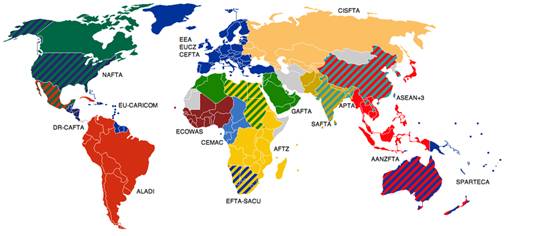 The purpose of creating trading blocs is to reduce or eliminate unnecessary trade barriers between member states, and to allow the free movement of goods, services, labour and capital.
The purpose of creating trading blocs is to reduce or eliminate unnecessary trade barriers between member states, and to allow the free movement of goods, services, labour and capital.
However, non-members of trading blocs are facing with financial and non-financial restrictions on their exports to these blocs, such as tariffs, quotas and even embargoes. As a result it is difficult for any country to survive outside one of these blocs and the world is splitting into expanding groups of trading nations promoting free trade between themselves, at the same time as they are restricting it to those countries outside of their blocs.
Pros and Cons of Regional Integration
There are many theoretical advantages and disadvantages that come with regional integration,
The advantages include:
- Less chance of conflict and war.
- Larger markets and customer base allows businesses within member countries to exploits economies of scale.
- Freedom of movement of goods and peoples.
- Increased global significance.
- Improving environmental and social conditions.
- The promotion of democracy and liberalisation.
- Trade creation-the elimination of protectionism increases trade, leading to a more efficient allocation of member state resources.
The disadvantages include:
- Loss of sovereignty, independence, and national identity.
- Loss of national power in favour of even bigger government.
- Increased competition leading to job losses in some domestic industries.
- Loss of border control and the increased risk of smuggled goods and people.
- Uniform laws don't account for cultural differences.
- Trade diversion - the elimination of trade barriers among the member states may divert trade away from more efficient non-member states that are disadvantaged by the protectionism they still face.
Protectionism
Protectionism arises because countries may not always feel that they benefit from completely free trade. While they may understand that free trade will benefit everyone, they may be suffering some of the costs associated with trade and feel that they want to restrict aspects of trading activity. These restrictions are known as protectionism. Trading blocs practice varieties of protectionist behaviour.
Examples of protectionist policies include:
- Tariffs - a tariff is a tax on imports. Tariffs reduce supply and raise the price of imports. This gives domestic equivalents a competitive advantage. Tariffs will often be charged by regional trading blocs on imports from countries outside the area. The EU charges a common external tariff (CET) to many goods imported into the EU.
- Quotas - quotas have the effect of restricting the maximum amount of imports allowed into an economy. Once again they reduce the amount of imports entering an economy and increase the equilibrium price within the market. The government receives no revenue from a quota, as it does with a tariff, unless it can set up a system of licences.
- Export subsidies - export subsidies allow exporters to supply the market with more product than the natural market equilibrium would have allowed. Foreign consumers will enjoy increased economic welfare as the price of their purchases fall. Domestic employees might enjoy more wages and job security, but domestic taxpayers are footing the bill for this.
- Embargo - imports from certain countries are completely prohibited.
- Administrative barriers - countries or regional blocs can also use a range of administrative or legal devices to slowdown imports and to add costs. These can include the importing firm being required to obtain various licences and permits.
The World Trade Organisation (WTO)
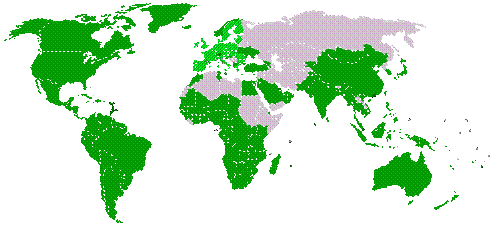 The World Trade Organisation helps to promote free trade by persuading countries to abolish import tariffs and other barriers to open markets. The WTO was established in 1995 replacing the General Agreement on Tariffs and Trade (GATT), which had been formed shortly after the Second World War.
The World Trade Organisation helps to promote free trade by persuading countries to abolish import tariffs and other barriers to open markets. The WTO was established in 1995 replacing the General Agreement on Tariffs and Trade (GATT), which had been formed shortly after the Second World War.
The WTO consists of 153 members representing more than 97% of total world trade. It also has 30 'observer' countries, mostly seeking membership. It has evolved into a complex web of agreements covering everything from farm goods and textiles to banking and intellectual property.
The WTO is the only international agency overseeing the rules of international trade. It helps to settle trade disputes between governments. Advocates of free trade say the gains in economic welfare are substantial. Critics of the WTO say the poor have just got poorer as a result of free trade. They say that the rich countries have maintained protectionist policies, and that poorer countries do not have the type of manufacturing infrastructure and economies of scale to enjoy the benefits of free trade.
The Stages of Economic Integration
If you would prefer to view this interaction in a new web window, then please follow the link below:

For fuller details of global trading blocs read the following article in Wikipedia
In 2009, 25 new regional trade agreements (RTAs) were notified to the WTO. The agreements include developed as well as developing countries, and involve countries from most parts of the world. In fact, they are not always regional, increasingly encompassing members from different continents. The new agreements bring the total number of RTAs in force to nearly 300.
Should we be worried by this trend? Read an analysis of the situation in the LSE's Centrepiece magazine.

To what extent are Regional Trade Agreements (RTAs) beneficial to their members and to the world trading system?
Regional trading bloc examples
The Association of Southeast Asian Nations (ASEAN)
 ASEAN is a geo-political and economic organization of 10 countries located in Southeast Asia. It was established on 8 August 1967 in Bangkok, Thailand, with the signing of the ASEAN Declaration by the 5 original members, namely Indonesia, Malaysia, Philippines, Singapore and Thailand.
ASEAN is a geo-political and economic organization of 10 countries located in Southeast Asia. It was established on 8 August 1967 in Bangkok, Thailand, with the signing of the ASEAN Declaration by the 5 original members, namely Indonesia, Malaysia, Philippines, Singapore and Thailand.
Brunei Darussalam then joined in January 1984, VietNam in July 1995, Lao PDR and Myanmar in July 1997, and Cambodia in April 1999, making up what is today the ten Member States of ASEAN.
ASEAN has a population of approximately 580 million people, 8.7% of the world population. In 2009, its combined nominal GDP had grown to more than USD $1.5 trillion. If ASEAN was a single country, it would rank as the 9th largest economy in the world in terms of nominal GDP.
The aims and purposes of ASEAN are:
- To accelerate the economic growth, social progress and cultural development in the region
- To promote regional peace and stability through abiding respect for justice and the rule of law in the relationship among countries of the region and adherence to the principles of the United Nations Charter
- To promote active collaboration and mutual assistance on matters of common interest in the economic, social, cultural, technical, scientific and administrative fields
- To provide assistance to each other in the form of training and research facilities in the educational, professional, technical and administrative spheres
- To collaborate more effectively for the greater utilisation of agriculture and industries
- To promote Southeast Asian studies
- To maintain close and beneficial cooperation with existing international and regional organisations with similar aims and purposes, and explore all avenues for even closer cooperation among themselves.
In January 2010, China came to an agreement with ASEAN to form a new free trade area incorporating China and the six founding members of the Association of South East Asian Nations (Asean). They plan to eliminate tariffs on 90% of imported goods.
In terms of population it will be the largest trade area in the world, with nearly 1.9bn people and it includes some of the leading export driven economies.
The European Union (EU)
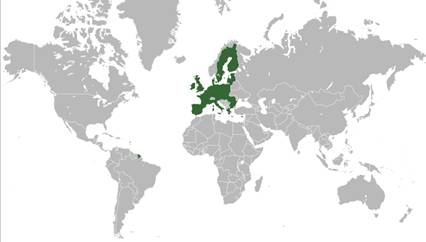 The European Economic Community (the EEC) came into being with the signing of the Treaty of Rome in 1957. It came officially into operation on January 1st 1958. The EEC aimed to create a common market, a customs union plus free movement of capital and labour. The original six members were Belgium, France, Italy, Luxembourg, Netherlands and West Germany.
The European Economic Community (the EEC) came into being with the signing of the Treaty of Rome in 1957. It came officially into operation on January 1st 1958. The EEC aimed to create a common market, a customs union plus free movement of capital and labour. The original six members were Belgium, France, Italy, Luxembourg, Netherlands and West Germany.
Since then, it has grown in size through enlargement, and in power through the addition of policy areas to its remit. Denmark, Ireland, and the United Kingdom, joined in1973, but Norwegian voters rejected membership in a referendum and so Norway remained outside.
Greece then joined in 1981, and Spain and Portugal in 1986. In 1986, the European flag was adopted for use by the Community and the Single European Act was signed. This was the first major revision of the Treaty of Rome and set the agenda to establish a Single Market by 1992. A common external tariff was imposed at this time.
In 1990, the former East Germany became part of the Community as part of a newly united Germany.
The European Union was formally established when the Maastricht Treaty came into force on 1 November 1993, and in 1995 Austria, Sweden, and Finland joined the EU. In 2002, euro notes and coins replaced national currencies in 12 of the member states, making it unique among trading blocs in establishing monetary union. In 2004, the EU saw a major enlargement from 15 to 25 members when Malta, Cyprus, Slovenia, Estonia, Latvia, Lithuania, Poland, the Czech Republic, Slovak Republic, and Hungary joined the Union.
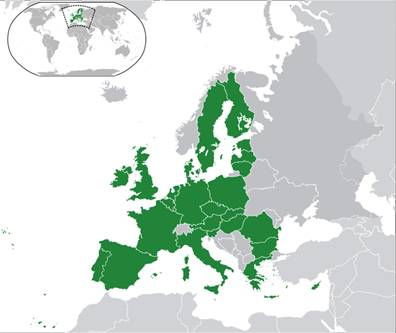 On 1 January 2007, Romania and Bulgaria became the EU's newest members. The eurozone increased to include sixteen countries with Slovenia, Cyprus and Malta, and by Slovakia adopting the euro.
On 1 January 2007, Romania and Bulgaria became the EU's newest members. The eurozone increased to include sixteen countries with Slovenia, Cyprus and Malta, and by Slovakia adopting the euro.
With over 500 million citizens, the EU countries combined generated an estimated 21% of the world's total economic output in terms of purchasing power parity, which makes it the largest economy in the world by nominal GDP and the second largest trade bloc economy in the world by PPP valuation of GDP.
The EU is likely to see additional enlargement in the next few years. Other countries wanting to join include Croatia, Iceland, Serbia, Macedonia, Albania and Montenegro. The membership bid by Turkey has become the major controversy of the ongoing enlargement. Turkey has been an associate member of the EU since 1963. It was one of the first members of the Council of Europe in 1949, and was also a founding member of the Organisation for Economic Co-operation and Development (OECD) in 1961. Opposition to Turkey's membership results from its long standing dispute over Cyprus, concerns about democracy and human rights in the country plus the issue of it being a relatively poor country by EU standards. Another major barrier to membership is the fact that, although Turkey is a secular state with no official state religion, 99 percent of the population is registered as Muslim. If Turkey is ever accepted EU, it would become the first Muslim nation to do so. However, strong elements in Germany, France, and the Netherlands oppose Turkey's bid.
On the map below, countries are shown as follows:
- Dark blue - members (as of 2009)
- Mid blue - candidate countries (as of 2009)
- Pale blue - potential candidate countries (as of 2009)
- Green - membership possible
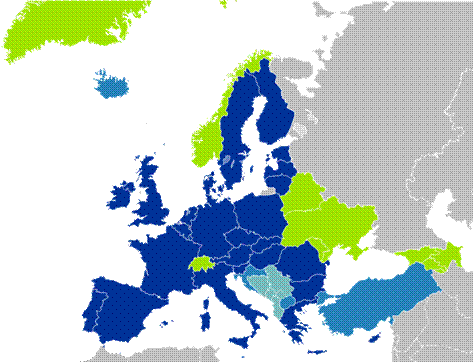

For some more information on the European Union, a search of the Biz/ed In the News is a good starting point. When searching, try using the following terms:
- Euro
- EU
- European Union
- Enlargement
You can access the Bized archive in the window below:

To narrow the search it is worth selecting the 'Match whole words only' and 'Match your phrase exactly' boxes below the main search boxes to avoid finding a lot of additional results)
The European Union - using the web

Media sites
To keep up to date with EU developments, the following sites are recommended:
- The Economist - some useful background here and also their country profiles may be a help.
- The Guardian archive - possibly the best archive on the web. Well worth a search of this to find out about European issues.
- The BBC news site - again, an excellent archive to search.
Other sites
The European Union's has its own site - Europa. This is a massive site, but the basic information link is a good starting point
1.9 Globalisation - questions
In this section are a series of questions on the topic - Globalisation. The questions may include various types of questions. For example:
- Self-test questions - on-screen questions that give immediate marking and feedback
- Short-answer questions - a series of short-answer questions to help you check your understanding of the topic
- Case study - a case study with associated questions
- In the news - questions based around a topical business news article
Click on the right arrow at the top or bottom of the page to work through the questions.
Globalisation shakes the world
Read the article Globalisation shakes the world (you can do this in the window below or follow the previous link to read the article in a separate window) and then consider answers to the questions below.

Question 1
Define the term 'globalisation'.
Question 2
Analyse the advantages and disadvantages of increased globalisation to (a) a less developed economy and (b) a developed economy.
Question 3
Discuss the factors that have led to the rapid pace of globalisation in recent years.
Here is the US news from Bangalore
Read the article Here is the US news from Bangalore (you can do this in the window below or follow the previous link to read the article in a separate window) and then consider answers to the questions below.

Question 1
Define the terms 'offshoring', 'outsourcing' and 'nearshoring'.
Question 2
Explain three advantages of outsourcing business functions like human resource management.
Question 3
Analyse the extent to which India is able to benefit from external economies of scale by winning outsourcing contracts from overseas firms.
Question 4
Discuss the arguments for and against Reuters outsourcing some of their news functions to Bangalore.
A flat earth?
Read the article The new rules of the global game (you can do this in the window below or follow the previous link to read the article in a separate window) and then consider answers to the questions below.

You may also like to read the article Why Bill Gates believes the world is flat.
You can also listen again to the BBC programme, The new rules of the game, May the force be with you (part 1), The dark side (part 2), The new rules and who makes them (part 3).

Question 1
Define the term globalisation.
Question 2
Explain why Bill Gates (and Thomas Friedman) believe the world is flat. Do you agree with their argument?
Question 3
Discuss the advantages and disadvantages of globalisation for (a) developed countries and (b) developing countries. You may find it helpful to listen to Part 2 of the Rules of the game (linked to above).
Question 4
Analyse the impact that globalisation has had on our lives over the last decade.



